Paul van Yperen's Blog, page 2
September 25, 2025
Claudia Cardinale (1938-2025), Part 2
Italian actress Claudia Cardinale (1938-2025), who passed away last Tuesday, was one of Europe's most iconic and versatile film stars. The success of her films 8½ (1963) and Il Gattopardo/The Leopard (1963) piqued Hollywood's interest in her. But she returned to Italy to make the ultimate Spaghetti Western. In the following decades, she continued to star in many interesting European films. This is part 2 of EFSP's In Memoriam post on her.
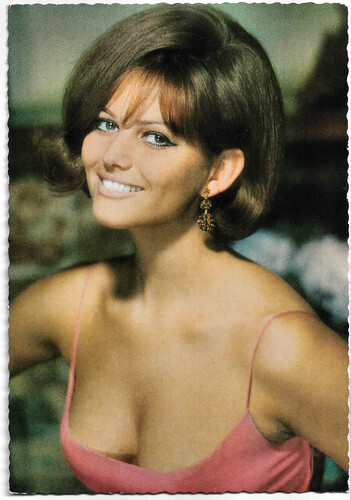
French postcard by E.D.U.G., no. 459. Photo: Sam Lévin.
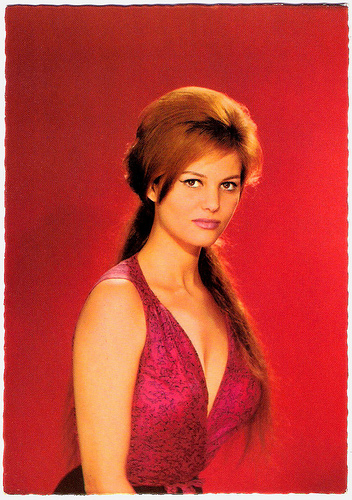
French postcard by E.D.U.G., no. 183. Photo: Sam Lévin.
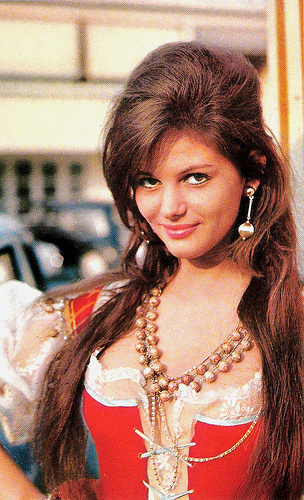
French postcard by Edition P.I., Paris, no. 1102. Photo: Kasparian. Publicity still for Cartouche (1962).
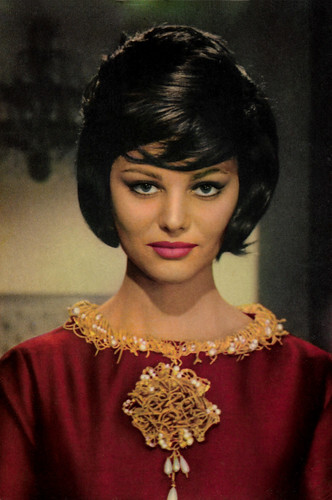
Spanish postcard by Ediciones Raker, Barcelona. no. 1094. Photo: Claudia Cardinale in The Pink Panther (Blake Edwards, 1963).
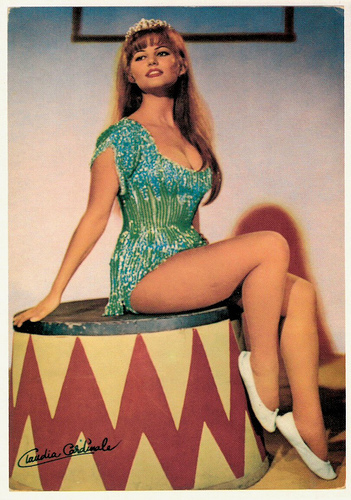
Postcard by Moviestar 1961, no. F 73. Photo: Publicity still for Circus World (1964).
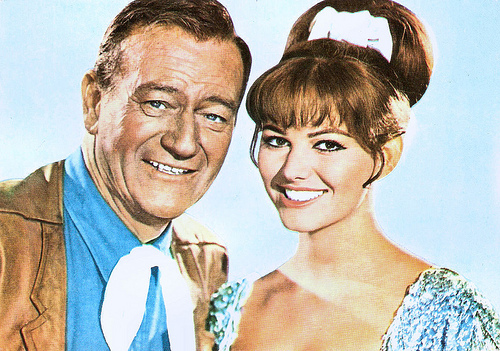
Romanian postcard by Casa Filmului Acin. Publicity still for Circus World (Henry Hathaway, 1964) with John Wayne .
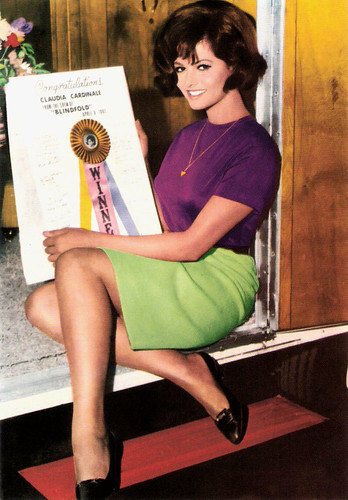
Spanish postcard by Postal Oscar Color, no. 567. Holding an announcement for an award for Blindfold (Philip Dunne, 1966).
Pink Panther
In 1963, Claudia Cardinale played the princess who owned the Pink Panther diamond in The Pink Panther (Blake Edwards, 1963), which was filmed in Italy. It was the first in the series of detective comedies starring Peter Sellers as bumbling French Inspector Jacques Clouseau (the mishap-prone snoop was actually a supporting player in his debut).
The film was an enormous success and brought CC to English-speaking audiences. In 1964, she co-starred with John Wayne and Rita Hayworth in her first American production, Circus World (Henry Hathaway, 1964). It was another box-office hit.
The following year, she appeared with Rock Hudson in Blindfold (Philip Dunne, 1966), an offbeat mixture of espionage and slapstick comedy.
The Professionals (Richard Brooks, 1966) is her favourite among her Hollywood films. In this Western, she is a gutsy Mexican woman married against her will to a rich American. The film received Academy Award nominations for Best Direction (Richard Brooks), Best Screenplay (Brooks again), and Best Cinematography (Conrad L. Hall).
Claudia Cardinale continued dividing her time between Hollywood and Europe for the remainder of the decade.
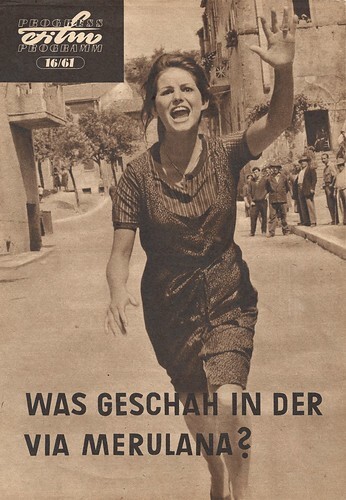
Cover of Progress Film Programm, no. 16/61. Claudia Cardinale in Un maledetto imbroglio / The Facts of Murder (Pietro Germi, 1959), based on Carlo Emilio Gadda's novel 'Quer pasticciaccio brutto de via Merulana' (That Awful Mess on Via Merulana, 1957). Via Merulana is a major street in Rome. The German title of the film was: Was geschah in der Via Merulana?
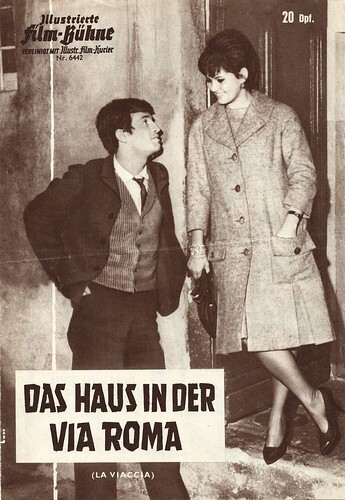
Cover of Illustrierte Film-Bühne, no. 6442. Claudia Cardinale and Jean-Paul Belmondo during the shooting of La viaccia / The Lovemakers (Mauro Bolognini, 1961). Belmondo wears his outfit from this period film, set in the 1880s. Cardinale wears her modern clothes. The German title of the film was Das Haus in der Via Roma.
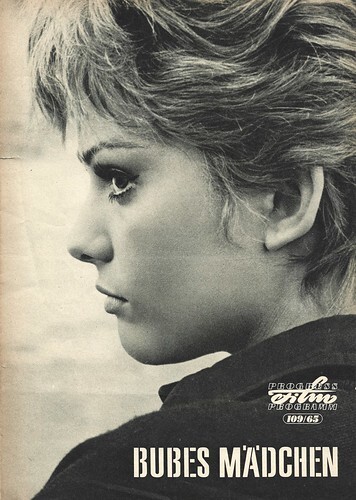
Cover Progress Film Programm, no. 109/65. Claudia Cardinale in La ragazza di Bube / Bebo's Girl (Luigi Comencini, 1963). The German title was Bubes Mädchen.

Small Czech collector card by Pressfoto, Praha (Prague), 1965, no. S 101/7. The retail price was Kcs 0,50. Photo: Claudia Cardinale in La ragazza di Bube / Bebo's Girl (Luigi Comencini, 1963). The film was presented at the Karlovy Vary International Film Festival in 1964.
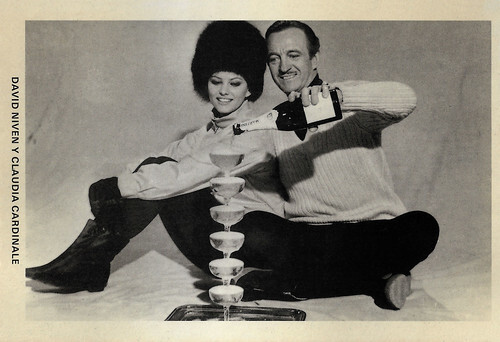
Spanish postcard by Productos Compactos, no. 44526, 1990. Claudia Cardinale and David Niven on a publicity still for The Pink Panther (Blake Edwards, 1963).
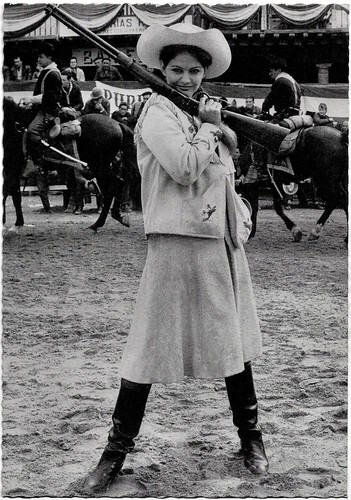
West German by Filmbilder-Vertrieb Ernst Freihoff, Essen, no. 890. Photo: Lothar Winkler. Claudia Cardinale in Circus World (Henry Hathaway, 1964).
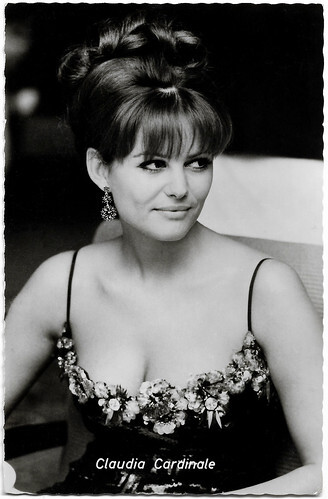
West German postcard by Kolibri / Friedrich W. Sander Verlag, Minden/Westf, no. 2367. Photo: Schorcht. Claudia Cardinale in Il magnifico cornuto / The Magnificent Cuckold (Antonio Pietrangeli, 1964).
The ultimate Spaghetti Western
Throughout the 1960s, Claudia Cardinale also appeared in some of the best European films. In France, she appeared in the Swashbuckler Cartouche (Philippe de Broca, 1962), featuring Jean-Paul Belmondo.
Back in Italy, she played in I Giorno della civetta / The Day of the Owl (Damiano Damiani, 1968) with Franco Nero , and Nell'anno del Signore / The Conspirators (Luigi Magni, 1969) with Nino Manfredi .
Mesmerising is her performance in Sandra / Vaghe stelle dell'Orsa... (Luchino Visconti, 1965) as a Holocaust survivor with an incestuous relationship with her brother ( Jean Sorel ).
Another highlight in her career is C'era una volta il West / Once Upon a Time in the West (Sergio Leone, 1968), the ultimate Spaghetti Western. Lucia Bozzola writes in her review at AllMovie : "In Sergio Leone's epic Western, shot partly in Monument Valley, a revenge story becomes an epic contemplation of the Western past. (...)
As in his 'Dollars' trilogy, Leone transforms the standard Western plot through the visual impact of widescreen landscapes and the figures therein. At its full length, Once Upon a Time in the West is Leone's operatic masterwork, worthy of its legend-making title."
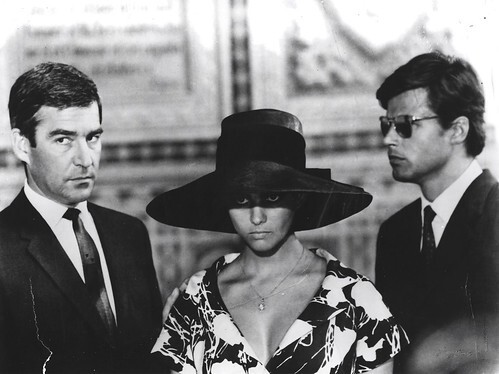
Vintage still. Claudia Cardinale, Michael Craig and Jean Sorel in Vaghe stelle dell'Orsa / Sandra (Luchino Visconti, 1965).
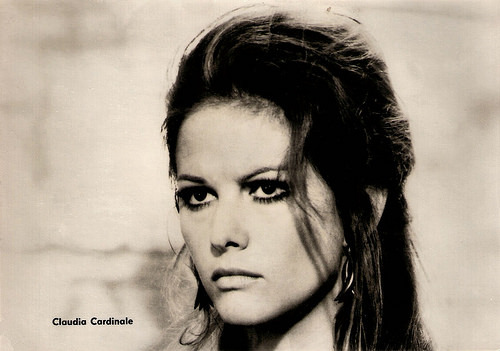
East German postcard by VEB Progress Filmvertrieb, Berlin, no. 225/69, 1969. Photo: publicity still for Il giorno della civetta / The Day of the Owl (Damiano Damiani, 1968).
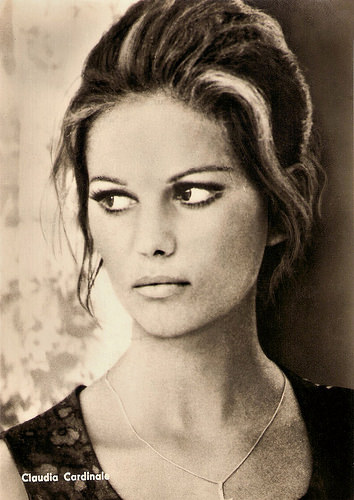
East German postcard by VEB Progress Filmvertrieb, Berlin, no. 20/70, 1970. Photo: publicity still for Il giorno della civetta / The Day of the Owl (Damiano Damiani, 1968).
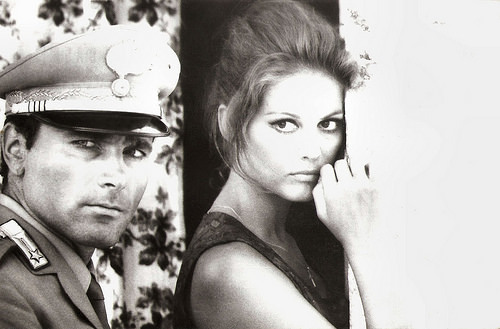
Romanian postcard by Casa Filmului Acin, no. 427. Photo: publicity still for Il giorno della civetta / The Day of the Owl (Damiano Damiani, 1968) with Franco Nero .
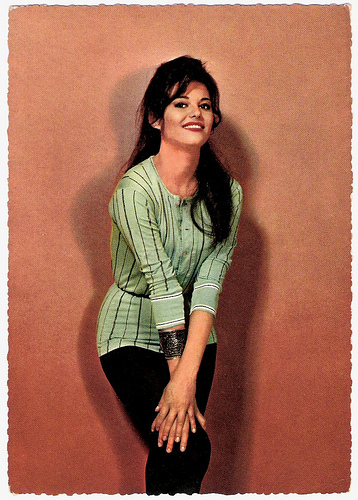
German postcard by Krüger, no. 902/47.
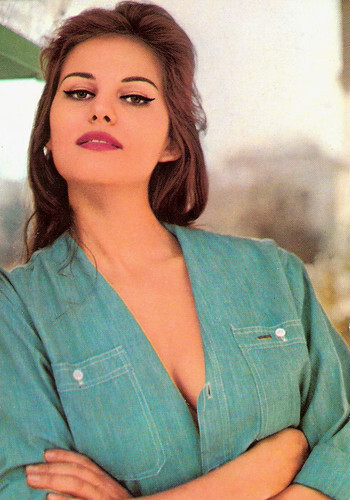
German postcard by Krüger, no. 902/115.
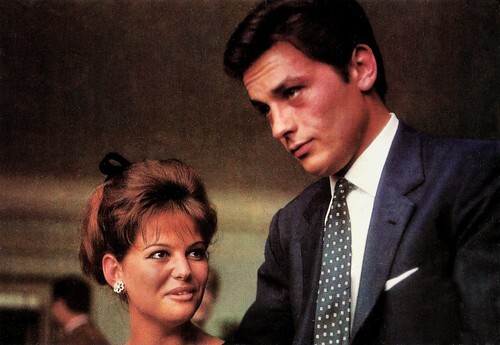
Spanish postcard by Postal Oscarcolor, no. 343. With Alain Delon.
International arthouse hit
In the following decades, Claudia Cardinale remained mainly active in European cinema. She played a small part for Visconti in Gruppo di famiglia in un interno / Conversation Piece (Luchino Visconti, 1974) starring Burt Lancaster and Silvana Mangano .
She worked with other major Italian directors at Goodbye e amen (Damiano Damiani, 1977), the TV mini-series Jesus of Nazareth (Franco Zeffirelli, 1977) as the adulteress, and La Pelle / The Skin (Liliana Cavani, 1981) starring Marcello Mastroianni and based on the bitter novel by Curzio Malaparte concerning the Allied liberation of Naples.
An international arthouse hit was Fitzcarraldo (Werner Herzog, 1982), the story of an obsessed impresario ( Klaus Kinski ) whose foremost desire in life is to bring both Enrico Caruso and an opera house to the deepest jungles of South America. In his diary of the making of Fitzcarraldo, Werner Herzog writes: "Claudia Cardinale is a great help because she is such a good sport, a real trouper, and has a special radiance before the camera. In her presence, [ Klaus Kinski ] usually acts like a gentleman."
Other interesting films include the Luigi Pirandello adaptation Enrico IV / Henry IV (Marco Bellocchio, 1984) with Marcello Mastroianni , the epic La révolution française / The French Revolution (Robert Enrico, Richard T. Heffron, 1989), the nostalgic drama Mayrig / Mother (Henri Verneuil, 1991), and the romantic thriller And now... Ladies and Gentlemen (Claude Lelouch, 2002) starring Jeremy Irons .
On Television, she gave another well-received performance in the TV drama La storia / History (Luigi Comencini, 1986), in which she plays a widow raising a son during World War II.
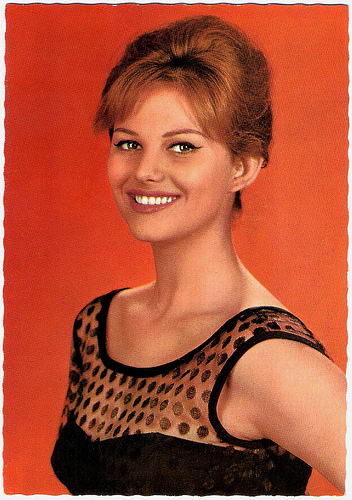
French postcard by E.D.U.G., no. 229. Photo: Sam Lévin.
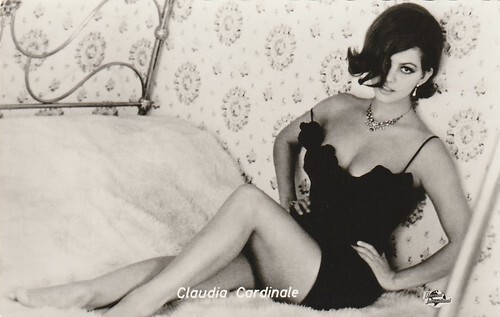
German postcard in the Kolibri Foto-Karte series by Friedrich W. Sander-Verlag, Minden-Westf., no. 2515. Photo: Universal International. Publicity still for The Hell with Heroes (Joseph Sargent, 1968). Collection: Daniël van der Aa.
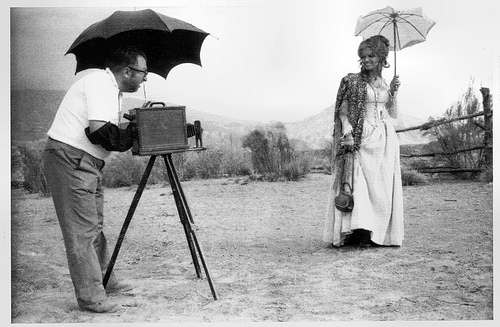
Italian postcard by Cineteca Bologna for the exhibition Un Altro West (2008). Photo: A. Novi. Sergio Leone and Claudia Cardinale on the set of C'era una volta il West / Once Upon a Time in the West (Sergio Leone, 1968).
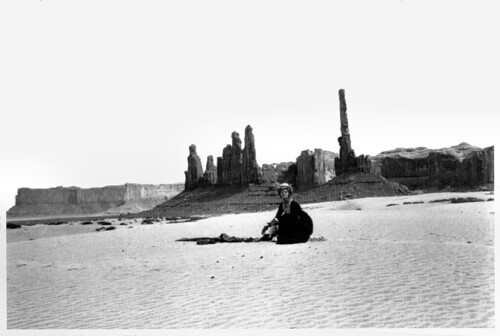
Italian postcard by Cineteca Bologna, 2007. Photo: A. Novi / Cineteca di Bologna. Claudia Cardinale in C'era una volta il West / Once Upon a Time in the West (Sergio Leone, 1968).
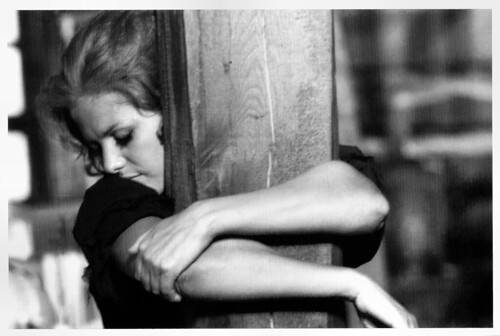
Italian postcard by Cineteca Bologna, 2007. Photo: A. Novi / Cineteca di Bologna. Claudia Cardinale in C'era una volta il West / Once Upon a Time in the West (Sergio Leone, 1968).
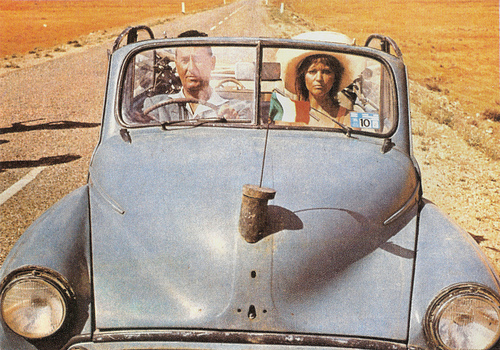
Italian postcard by Gruppo Editoriale Lo Vecchio, Genova, in the Alberto Sordi series. Photo: publicity still for Bello, onesto, emigrato in Australia sposerebbe compaesana illibata / A Girl in Australia (Luigi Zampa, 1971) with Alberto Sordi.
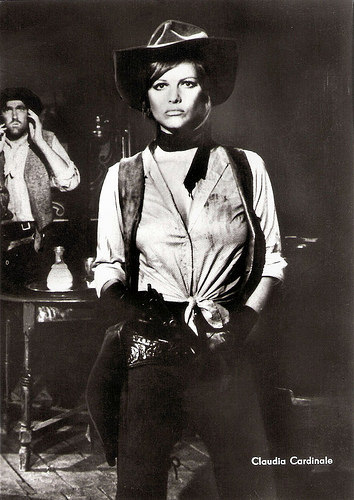
East German postcard by VEB Progress Filmvertrieb, Berlin, no. 154/73. Publicity still for Les pétroleuses / Frenchie King (Christian-Jaque, 1971). The billing of BB vs. CC in this Western didn't live up to expectations.
Strong political convictions
Claudia Cardinale was a liberal with strong political convictions. She was involved in many humanitarian causes, and pro-women and pro-gay issues, and she has frequently stated her pride in her Tunisian and Arab roots - as evidenced by her appearance as herself in the Tunisian film Un été à La Goulette / A Summer at La Goulette (Férid Boughedir, 1996).
She managed to combine her acting work with the role of goodwill ambassador for UNICEF and advocate for the work of Luchino Visconti, with whom she made four films.
She wrote an autobiography, 'Moi Claudia, Toi Claudia' (Me Claudia, You Claudia). In 2005, she also published a French-language book, 'Mes Etoiles' (My Stars), about her personal and professional relationships with many of her directors and co-stars through her over 50 years in show business.
In 2002, she won an honorary Golden Bear award of the Berlin Film Festival, and previously in 1993, she was awarded an honorary Golden Lion at the Venice Film Festival.
Cardinale worked steadily on and in more recent years, she also worked in the theatre. In the cinema, she appeared in the French-Tunisian gay drama Le fil / The String (Mehdi Ben Attia, 2009), the Algerian drama Un balcon sur la mer / A View of Love (Nicole Garcia, 2010), in which she played the mother of Jean Dujardin, and the costume drama Effie Gray (Richard Laxton, 2014) with Dakota Fanning. Claudia Cardinale has made over 135 films since 1956.
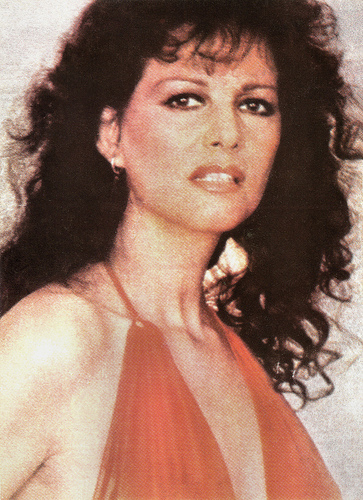
Romanian postcard by Casa Filmului Acin.
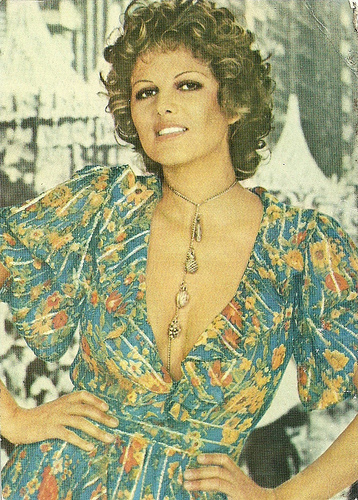
Romanian postcard by Casa Filmului Acin.
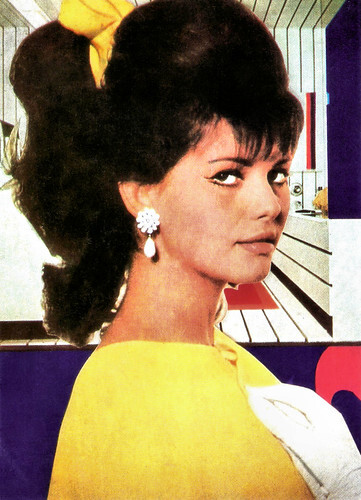
Romanian postcard by Casa Filmului Acin, no. 278.
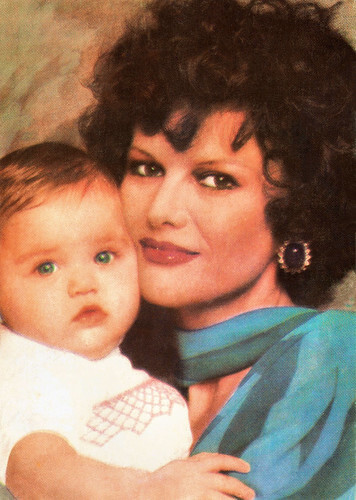
Romanian postcard by Casa Filmului Acin. Claudia Cardinale and daughter Claudia Squitieri.
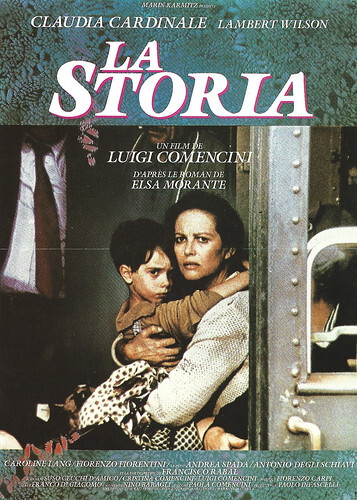
French poster postcard by Eds. F. Nugeron. Design: Yves Prince. Affiche for La Storia (Luigi Comencini, 1986), based on the novel (1974) by Elsa Morante, and starring Claudia Cardinale.
Trailer for Fitzcarraldo (1982). Source: Film Society of Lincoln Center (YouTube).
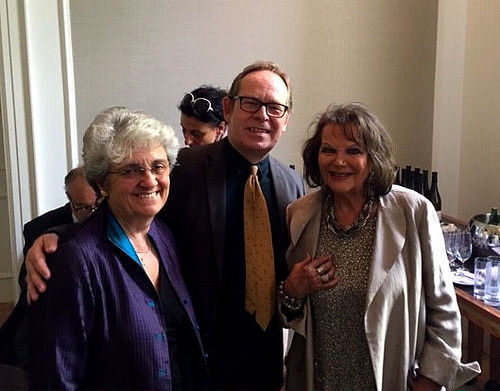
Claudia Cardinale in 2019, with Caterina D'Amico, producer and former president of the Scuola Nazionale del Cinema (Centro Sperimentale di Cinematografia) in Rome, and EFSP's Ivo Blom at the Waldorf Astoria Hotel in Amsterdam.
Sources: Lucia Bozzola (AllMovie - Post now defunct), Steve Rose (The Guardian), and Wikipedia.

French postcard by E.D.U.G., no. 459. Photo: Sam Lévin.

French postcard by E.D.U.G., no. 183. Photo: Sam Lévin.

French postcard by Edition P.I., Paris, no. 1102. Photo: Kasparian. Publicity still for Cartouche (1962).

Spanish postcard by Ediciones Raker, Barcelona. no. 1094. Photo: Claudia Cardinale in The Pink Panther (Blake Edwards, 1963).

Postcard by Moviestar 1961, no. F 73. Photo: Publicity still for Circus World (1964).

Romanian postcard by Casa Filmului Acin. Publicity still for Circus World (Henry Hathaway, 1964) with John Wayne .

Spanish postcard by Postal Oscar Color, no. 567. Holding an announcement for an award for Blindfold (Philip Dunne, 1966).
Pink Panther
In 1963, Claudia Cardinale played the princess who owned the Pink Panther diamond in The Pink Panther (Blake Edwards, 1963), which was filmed in Italy. It was the first in the series of detective comedies starring Peter Sellers as bumbling French Inspector Jacques Clouseau (the mishap-prone snoop was actually a supporting player in his debut).
The film was an enormous success and brought CC to English-speaking audiences. In 1964, she co-starred with John Wayne and Rita Hayworth in her first American production, Circus World (Henry Hathaway, 1964). It was another box-office hit.
The following year, she appeared with Rock Hudson in Blindfold (Philip Dunne, 1966), an offbeat mixture of espionage and slapstick comedy.
The Professionals (Richard Brooks, 1966) is her favourite among her Hollywood films. In this Western, she is a gutsy Mexican woman married against her will to a rich American. The film received Academy Award nominations for Best Direction (Richard Brooks), Best Screenplay (Brooks again), and Best Cinematography (Conrad L. Hall).
Claudia Cardinale continued dividing her time between Hollywood and Europe for the remainder of the decade.

Cover of Progress Film Programm, no. 16/61. Claudia Cardinale in Un maledetto imbroglio / The Facts of Murder (Pietro Germi, 1959), based on Carlo Emilio Gadda's novel 'Quer pasticciaccio brutto de via Merulana' (That Awful Mess on Via Merulana, 1957). Via Merulana is a major street in Rome. The German title of the film was: Was geschah in der Via Merulana?

Cover of Illustrierte Film-Bühne, no. 6442. Claudia Cardinale and Jean-Paul Belmondo during the shooting of La viaccia / The Lovemakers (Mauro Bolognini, 1961). Belmondo wears his outfit from this period film, set in the 1880s. Cardinale wears her modern clothes. The German title of the film was Das Haus in der Via Roma.

Cover Progress Film Programm, no. 109/65. Claudia Cardinale in La ragazza di Bube / Bebo's Girl (Luigi Comencini, 1963). The German title was Bubes Mädchen.

Small Czech collector card by Pressfoto, Praha (Prague), 1965, no. S 101/7. The retail price was Kcs 0,50. Photo: Claudia Cardinale in La ragazza di Bube / Bebo's Girl (Luigi Comencini, 1963). The film was presented at the Karlovy Vary International Film Festival in 1964.

Spanish postcard by Productos Compactos, no. 44526, 1990. Claudia Cardinale and David Niven on a publicity still for The Pink Panther (Blake Edwards, 1963).

West German by Filmbilder-Vertrieb Ernst Freihoff, Essen, no. 890. Photo: Lothar Winkler. Claudia Cardinale in Circus World (Henry Hathaway, 1964).

West German postcard by Kolibri / Friedrich W. Sander Verlag, Minden/Westf, no. 2367. Photo: Schorcht. Claudia Cardinale in Il magnifico cornuto / The Magnificent Cuckold (Antonio Pietrangeli, 1964).
The ultimate Spaghetti Western
Throughout the 1960s, Claudia Cardinale also appeared in some of the best European films. In France, she appeared in the Swashbuckler Cartouche (Philippe de Broca, 1962), featuring Jean-Paul Belmondo.
Back in Italy, she played in I Giorno della civetta / The Day of the Owl (Damiano Damiani, 1968) with Franco Nero , and Nell'anno del Signore / The Conspirators (Luigi Magni, 1969) with Nino Manfredi .
Mesmerising is her performance in Sandra / Vaghe stelle dell'Orsa... (Luchino Visconti, 1965) as a Holocaust survivor with an incestuous relationship with her brother ( Jean Sorel ).
Another highlight in her career is C'era una volta il West / Once Upon a Time in the West (Sergio Leone, 1968), the ultimate Spaghetti Western. Lucia Bozzola writes in her review at AllMovie : "In Sergio Leone's epic Western, shot partly in Monument Valley, a revenge story becomes an epic contemplation of the Western past. (...)
As in his 'Dollars' trilogy, Leone transforms the standard Western plot through the visual impact of widescreen landscapes and the figures therein. At its full length, Once Upon a Time in the West is Leone's operatic masterwork, worthy of its legend-making title."

Vintage still. Claudia Cardinale, Michael Craig and Jean Sorel in Vaghe stelle dell'Orsa / Sandra (Luchino Visconti, 1965).

East German postcard by VEB Progress Filmvertrieb, Berlin, no. 225/69, 1969. Photo: publicity still for Il giorno della civetta / The Day of the Owl (Damiano Damiani, 1968).

East German postcard by VEB Progress Filmvertrieb, Berlin, no. 20/70, 1970. Photo: publicity still for Il giorno della civetta / The Day of the Owl (Damiano Damiani, 1968).

Romanian postcard by Casa Filmului Acin, no. 427. Photo: publicity still for Il giorno della civetta / The Day of the Owl (Damiano Damiani, 1968) with Franco Nero .

German postcard by Krüger, no. 902/47.

German postcard by Krüger, no. 902/115.

Spanish postcard by Postal Oscarcolor, no. 343. With Alain Delon.
International arthouse hit
In the following decades, Claudia Cardinale remained mainly active in European cinema. She played a small part for Visconti in Gruppo di famiglia in un interno / Conversation Piece (Luchino Visconti, 1974) starring Burt Lancaster and Silvana Mangano .
She worked with other major Italian directors at Goodbye e amen (Damiano Damiani, 1977), the TV mini-series Jesus of Nazareth (Franco Zeffirelli, 1977) as the adulteress, and La Pelle / The Skin (Liliana Cavani, 1981) starring Marcello Mastroianni and based on the bitter novel by Curzio Malaparte concerning the Allied liberation of Naples.
An international arthouse hit was Fitzcarraldo (Werner Herzog, 1982), the story of an obsessed impresario ( Klaus Kinski ) whose foremost desire in life is to bring both Enrico Caruso and an opera house to the deepest jungles of South America. In his diary of the making of Fitzcarraldo, Werner Herzog writes: "Claudia Cardinale is a great help because she is such a good sport, a real trouper, and has a special radiance before the camera. In her presence, [ Klaus Kinski ] usually acts like a gentleman."
Other interesting films include the Luigi Pirandello adaptation Enrico IV / Henry IV (Marco Bellocchio, 1984) with Marcello Mastroianni , the epic La révolution française / The French Revolution (Robert Enrico, Richard T. Heffron, 1989), the nostalgic drama Mayrig / Mother (Henri Verneuil, 1991), and the romantic thriller And now... Ladies and Gentlemen (Claude Lelouch, 2002) starring Jeremy Irons .
On Television, she gave another well-received performance in the TV drama La storia / History (Luigi Comencini, 1986), in which she plays a widow raising a son during World War II.

French postcard by E.D.U.G., no. 229. Photo: Sam Lévin.

German postcard in the Kolibri Foto-Karte series by Friedrich W. Sander-Verlag, Minden-Westf., no. 2515. Photo: Universal International. Publicity still for The Hell with Heroes (Joseph Sargent, 1968). Collection: Daniël van der Aa.

Italian postcard by Cineteca Bologna for the exhibition Un Altro West (2008). Photo: A. Novi. Sergio Leone and Claudia Cardinale on the set of C'era una volta il West / Once Upon a Time in the West (Sergio Leone, 1968).

Italian postcard by Cineteca Bologna, 2007. Photo: A. Novi / Cineteca di Bologna. Claudia Cardinale in C'era una volta il West / Once Upon a Time in the West (Sergio Leone, 1968).

Italian postcard by Cineteca Bologna, 2007. Photo: A. Novi / Cineteca di Bologna. Claudia Cardinale in C'era una volta il West / Once Upon a Time in the West (Sergio Leone, 1968).

Italian postcard by Gruppo Editoriale Lo Vecchio, Genova, in the Alberto Sordi series. Photo: publicity still for Bello, onesto, emigrato in Australia sposerebbe compaesana illibata / A Girl in Australia (Luigi Zampa, 1971) with Alberto Sordi.

East German postcard by VEB Progress Filmvertrieb, Berlin, no. 154/73. Publicity still for Les pétroleuses / Frenchie King (Christian-Jaque, 1971). The billing of BB vs. CC in this Western didn't live up to expectations.
Strong political convictions
Claudia Cardinale was a liberal with strong political convictions. She was involved in many humanitarian causes, and pro-women and pro-gay issues, and she has frequently stated her pride in her Tunisian and Arab roots - as evidenced by her appearance as herself in the Tunisian film Un été à La Goulette / A Summer at La Goulette (Férid Boughedir, 1996).
She managed to combine her acting work with the role of goodwill ambassador for UNICEF and advocate for the work of Luchino Visconti, with whom she made four films.
She wrote an autobiography, 'Moi Claudia, Toi Claudia' (Me Claudia, You Claudia). In 2005, she also published a French-language book, 'Mes Etoiles' (My Stars), about her personal and professional relationships with many of her directors and co-stars through her over 50 years in show business.
In 2002, she won an honorary Golden Bear award of the Berlin Film Festival, and previously in 1993, she was awarded an honorary Golden Lion at the Venice Film Festival.
Cardinale worked steadily on and in more recent years, she also worked in the theatre. In the cinema, she appeared in the French-Tunisian gay drama Le fil / The String (Mehdi Ben Attia, 2009), the Algerian drama Un balcon sur la mer / A View of Love (Nicole Garcia, 2010), in which she played the mother of Jean Dujardin, and the costume drama Effie Gray (Richard Laxton, 2014) with Dakota Fanning. Claudia Cardinale has made over 135 films since 1956.

Romanian postcard by Casa Filmului Acin.

Romanian postcard by Casa Filmului Acin.

Romanian postcard by Casa Filmului Acin, no. 278.

Romanian postcard by Casa Filmului Acin. Claudia Cardinale and daughter Claudia Squitieri.

French poster postcard by Eds. F. Nugeron. Design: Yves Prince. Affiche for La Storia (Luigi Comencini, 1986), based on the novel (1974) by Elsa Morante, and starring Claudia Cardinale.
Trailer for Fitzcarraldo (1982). Source: Film Society of Lincoln Center (YouTube).

Claudia Cardinale in 2019, with Caterina D'Amico, producer and former president of the Scuola Nazionale del Cinema (Centro Sperimentale di Cinematografia) in Rome, and EFSP's Ivo Blom at the Waldorf Astoria Hotel in Amsterdam.
Sources: Lucia Bozzola (AllMovie - Post now defunct), Steve Rose (The Guardian), and Wikipedia.
Published on September 25, 2025 22:00
September 24, 2025
Claudia Cardinale (1938-2025) - Part 1
One of Europe's iconic and most versatile film stars, Italian actress Claudia Cardinale (1938-2025), died last Tuesday. The combination of her beauty, dark, flashing eyes, explosive sexuality and genuine acting talent virtually guaranteed her stardom. Her most notable films include the classics 8½ (Federico Fellini, 1963), Il Gattopardo (Luchino Visconti, 1963), and Once Upon a Time in the West (Sergio Leone, 1968). One post is not enough to commemorate La CC. Tomorrow follows Part 2.
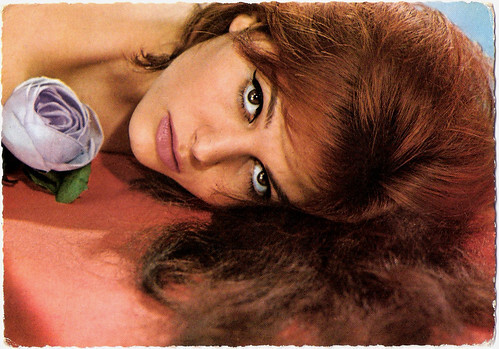
French postcard by E.D.U.G., no. 316. Photo: Sam Lévin.
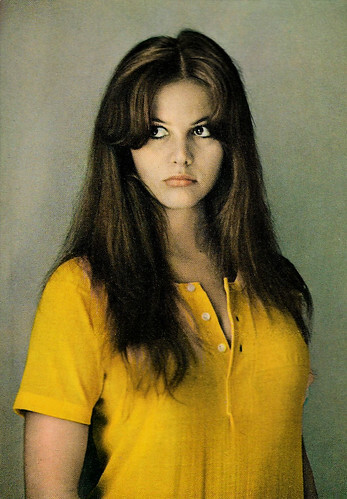
Italian postcard by Rotalfoto (Rotalcolor), Milano, no. N. 203.
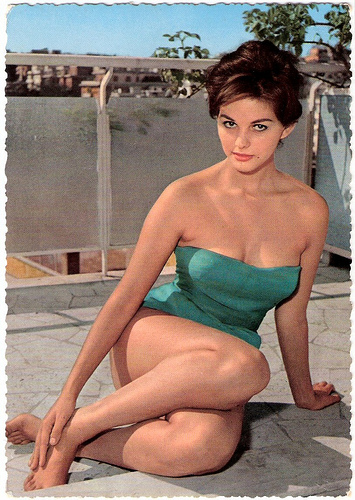
German postcard by Krüger, no. 902/164. Photo: Georg Michalke / UFA.
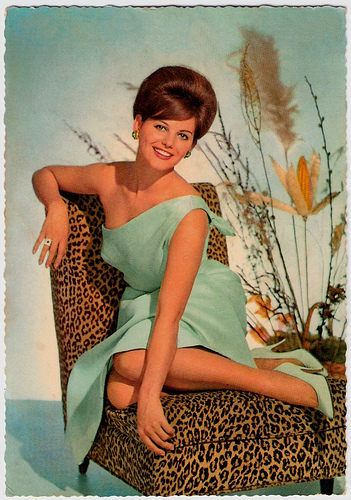
German postcard by Krüger, no. 902/132. Photo: Sam Levin / Ufa.
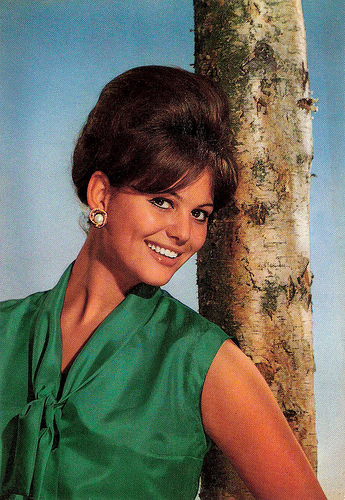
French postcard by E.D.U.G., no. 243, offered by Les Carbones Korès Carboplane. Photo: Sam Lévin.
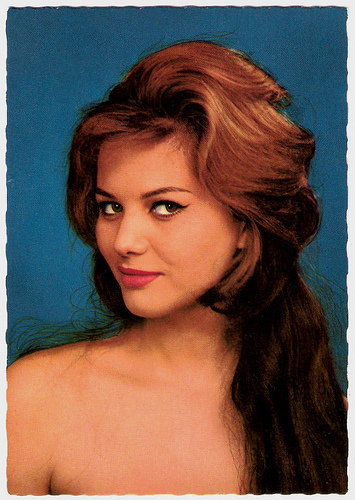
German postcard by Filmbilder-Vertrieb Ernst Freihoff, Essen, no. H 72.
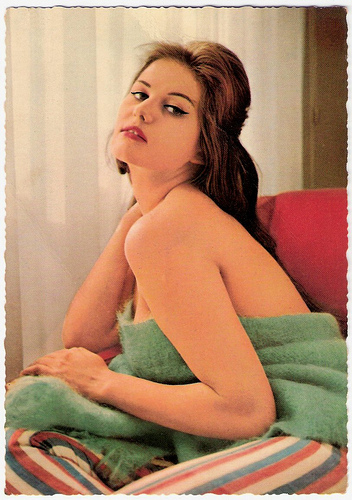
German postcard by Krüger, no. 902/115.
The most beautiful Italian girl in Tunisia
Claude Joséphine Rose Cardinale was born in La Goulette in Tunisia in 1938 (some sources claim 1939). Her mother, Yolande Greco, was born in Tunisia to Italian (Sicilian) emigrants from Trapani, Italy. Her father was an Italian (Sicilian) railway worker, born in Gela, Italy.
Her native languages were Tunisian Arabic and French. She received a French education, and she had to learn Italian once she pursued her acting career.
She had her breakthrough in films after she was voted the most beautiful Italian girl in Tunisia in 1957. The contest of the Italian embassy had as a prize a trip to the Venice Film Festival. She made her film debut in the French-Tunisian coproduction Goha (Jacques Baratier, 1958), starring Omar Sharif.
After attending the Centro Sperimentale di Cinematografia in Rome for two months, she signed a 7-year contract with the Vides studios. The contract forbade her to cut her hair, to marry or to gain weight.
Later that year, she had a role in the heist comedy I soliti ignoti / Big Deal On Madonna Street (Mario Monicelli, 1958) with Vittorio Gassman and Renato Salvatori . The film was an international success, and her film career was off and running.
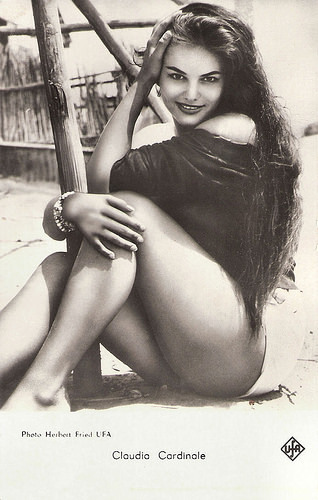
French postcard by Editions P.I., no. FK 104. Photo: Herbert Fried / Ufa.
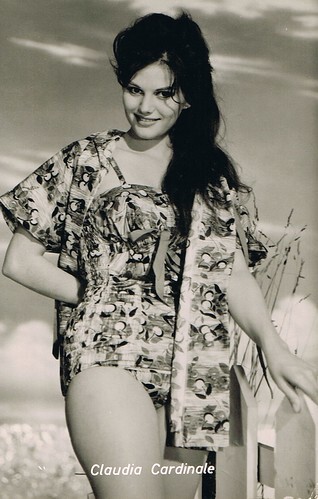
German postcard by Kolibri-Verlag. Collection: Meiter.
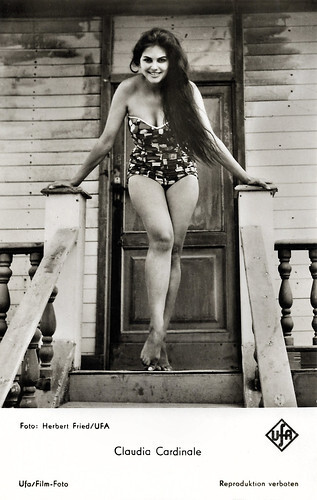
West German postcard by Ufa/Film-Foto, Berlin-Tempelhof, no. FK 5143. Photo: Herbert Fried / Ufa.
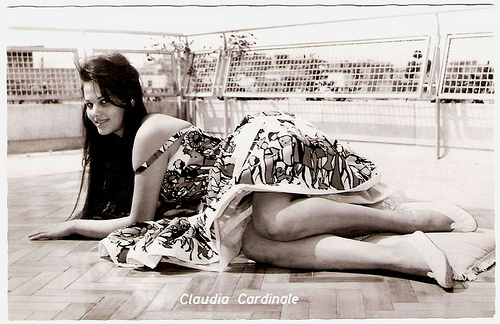
German postcard by Kolibri (W. Sander Verlag, Minden), no. 1865.
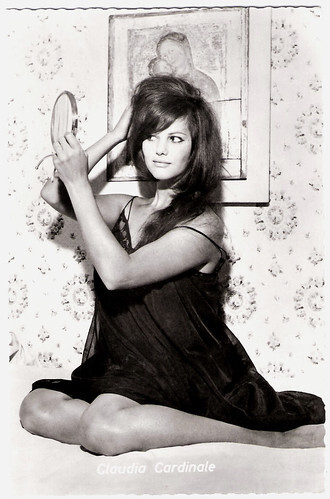
German postcard by Kolibri (W. Sander Verlag, Minden), no. 1968.
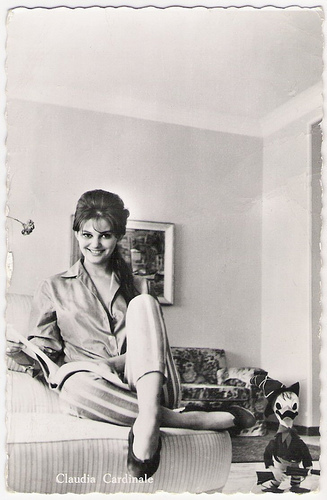
Dutch postcard.
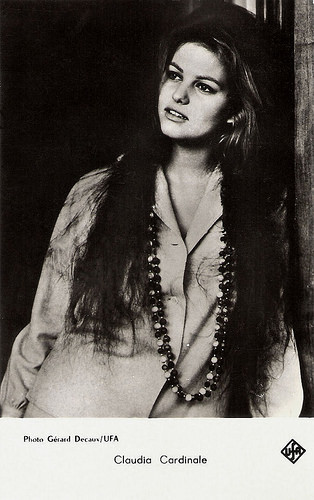
French postcard by Editions P.I., Paris, French licence holder for Ufa, presented by Les Carbones Korès 'Carboplane', no. FK 99 B. Photo: Gérard Décaux / Ufa.
After BB Comes CC
At this point, the press, noting her initials, announced that CC was the natural successor to BB ( Brigitte Bardot ), and began beating the drum on her behalf.
Dozens of alluring photographs of Claudia Cardinale were displayed in newspapers and magazines throughout the world. According to IMDb , she has appeared on more than 900 magazine covers in over 25 countries.
The contrast between these pictures and those of Marilyn Monroe or Jayne Mansfield is striking. Cardinale never appeared in a nude or fully topless scene. Her pictures promoted an image of a shy family girl who just happened to have a beautiful face and a sexy body.
A photograph of Cardinale was featured in the original gatefold artwork to Bob Dylan's album 'Blonde on Blonde' (1966), but because it was used without Cardinale's permission, the photo was removed from the cover art in later pressings.
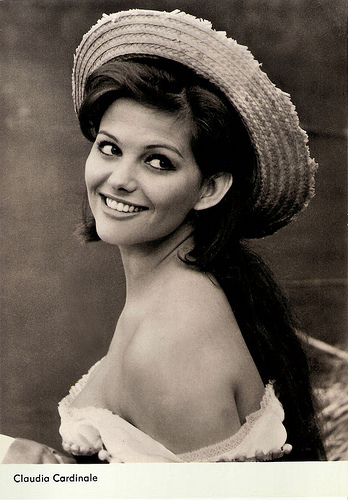
East German postcard by VEB Progress Filmvertrieb, Berlin, no. 2949, 1967.
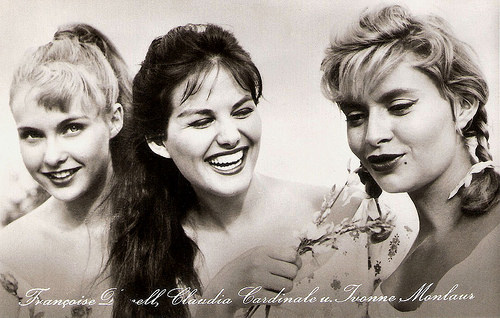
East German postcard by VEB Progress Filmvertrieb, no. 1187, 1960. Publicity still for Tre straniere a Roma / Three Strangers in Rome (Claudio Gora, 1958) with Yvonne Monlaur and Françoise Darnell.
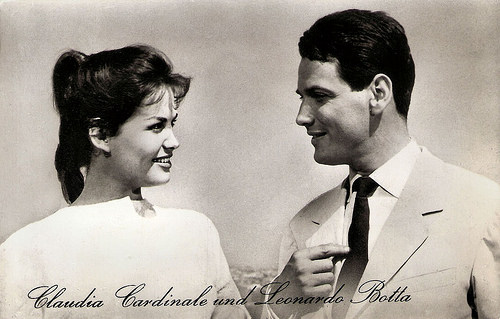
East German postcard by VEB Progress Filmvertrieb. Publicity still for Tre straniere a Roma/Three Strangers in Rome (Claudio Gora, 1958) with Leonardo Botta.
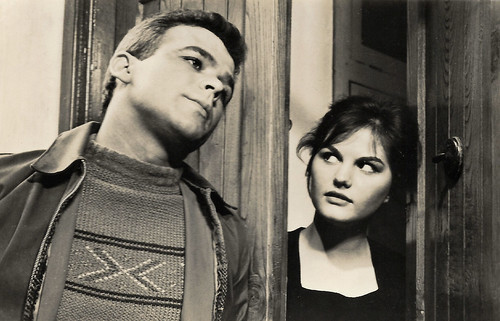
Small Czech collectors card by Pressfoto, Praha (Prague), 1965, no. S 101/3. Photo: Claudia Cardinale and Renato Salvatori in Audace colpo dei soliti ignoti / Fiasco in Milan (Nanni Loy, 1959).
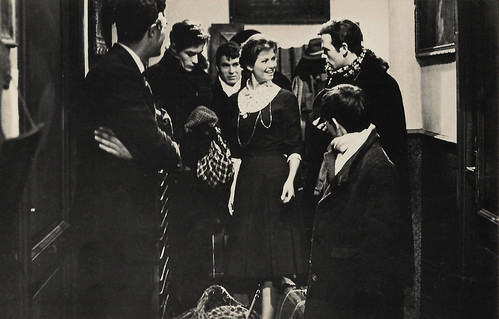
Small Czech collectors card by Pressfoto, Praha (Prague), 1965, no. S 101/5. Photo: Claudia Cardinale , Alain Delon , Max Cartier and Renato Salvatori in Rocco e i suoi fratelli/Rocco and His Brothers (Luchino Visconti, 1960).
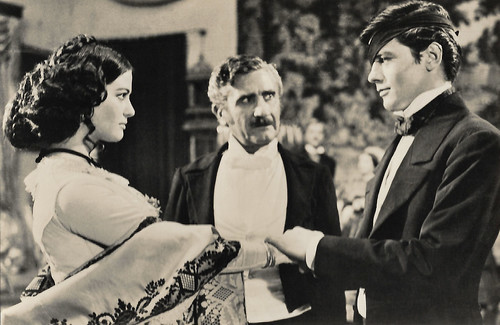
Small Czech collectors card by Pressfoto, Praha (Prague), 1965, no. S 101/6. Photo: G.B. Poletto. Claudia Cardinale , Paolo Stoppa and Alain Delon in Il gattopardo/The Leopard (Luchino Visconti, 1963).
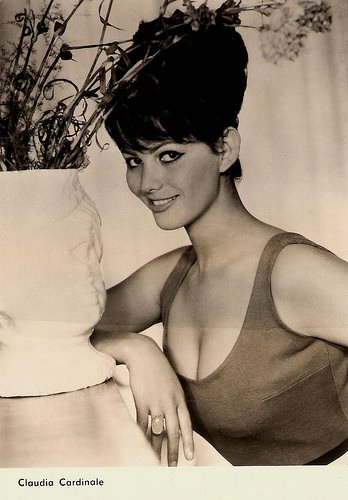
East German postcard by VEB Progress Filmvertrieb, Berlin, no. 2569, 1965.
Manager-producer-husband
Claudia Cardinale's early career was largely managed by producer Franco Cristaldi. Because of her film contract, she told everyone that her son Patrizio was her baby brother. He was born out of wedlock when she was 17. The father was a mysterious Frenchman. She did not reveal to the child that he was her son until he was 19 years old. In 1966, she married Cristaldi, who adopted Patrizio.
In only three years, she made a stream of great films. First, she made three successful comedies, Un Maledetto imbroglio / The Facts of Murder (Pietro Germi, 1959), Il Bell'Antonio / Bell'Antonio (Mauro Bolognini, 1960) featuring Marcello Mastroianni , and Audace colpo dei soliti ignoti / Fiasco in Milan (Nanni Loy, 1960).
Cardinale had a supporting part in the epic drama Rocco e i suoi fratelli / Rocco and His Brothers (Luchino Visconti, 1960) in which she played the sister-in-law of Alain Delon and Renato Salvatori.
And then followed leading parts in La Ragazza con la valigia / Girl with a Suitcase (Valerio Zurlini, 1961), La Viaccia / The Lovemakers (Mauro Bolognini, 1961) with Jean-Paul Belmondo , and Senilità / Careless (Mauro Bolognini, 1961).
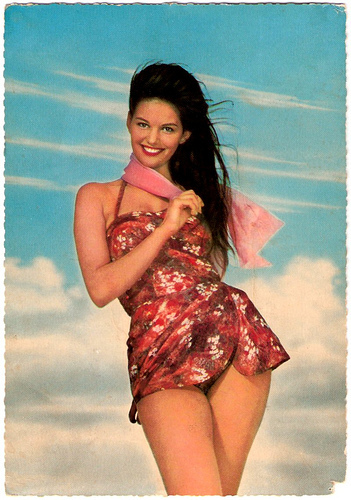
German postcard by Krüger.
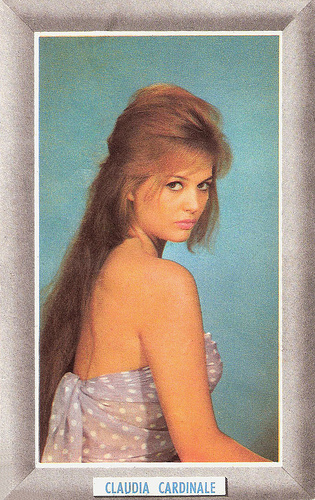
French postcard.
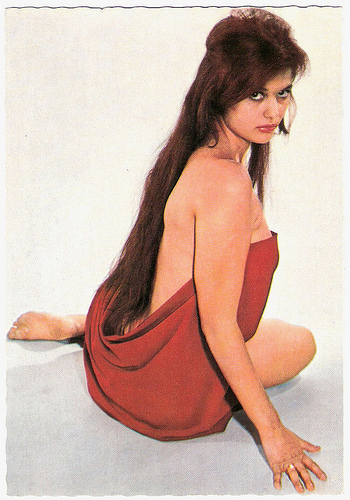
German postcard by ISV, Sort. 10/6.
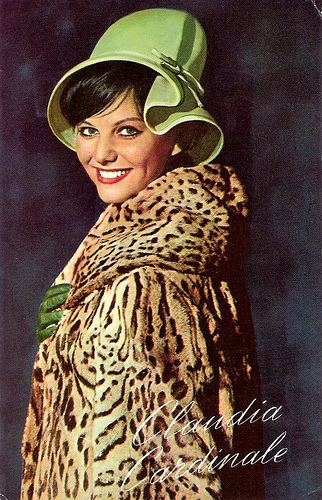
Dutch postcard, Serie 6.
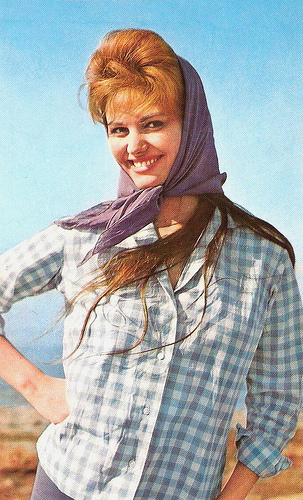
French postcard by Editions P.I., Paris, no. 1084, offered by Corvisart, Epinal. Photo: Ektachrome Anders.
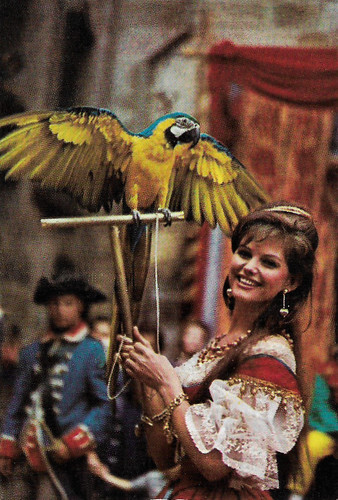
Belgian collector card no. 25 (of 26). Claudia Cardinale in Cartouche (Philippe de Broca, 1962).
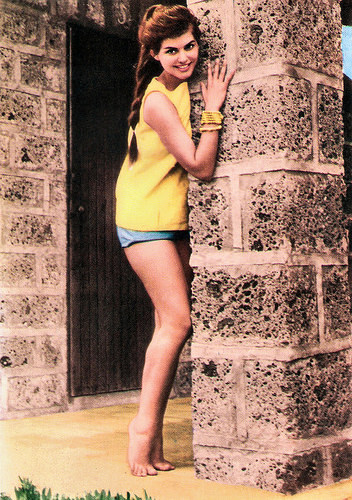
Spanish postcard by Postal Oscar Color, Hospitalet (Barcelona), no. 521, 1963.
Deep voice and heavy accent
Claudia Cardinale had a deep, sultry voice and spoke Italian with a heavy French accent, so her voice was dubbed in her early films.
In Federico Fellini 's 8½ (1963), she was finally allowed to dub her own dialogue. In the film, she plays a dream woman - a character named Claudia, who is the object of the fantasies of the director in the film, played by Marcello Mastroianni . With Fellini's surrealistic masterpiece, she received her widest exposure to date.
That same year, she also appeared in another masterpiece of Italian cinema, the epic Il Gattopardo / The Leopard (Luchino Visconti, 1963) with Burt Lancaster and Alain Delon .
The combined success of these two classic films made her rise to the front ranks of Italian cinema. And it also piqued Hollywood's interest...
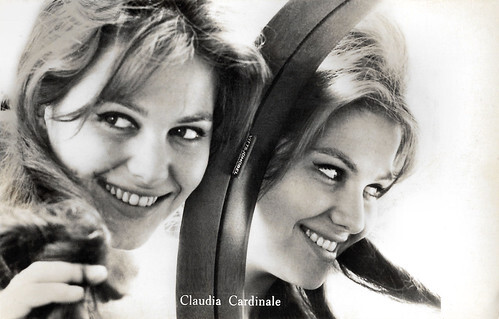
Dutch postcard by Hercules, Haarlem, no. 262.
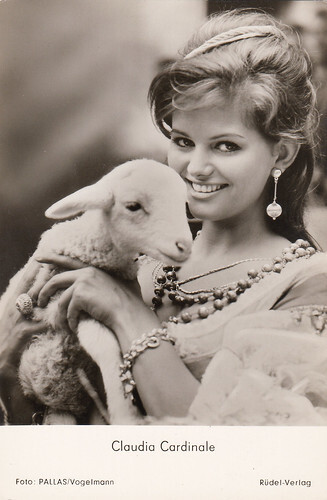
German postcard by Rüdel Verlag, no. 3561. Photo: PALLAS / Vogelmann. Claudia Cardinale in Cartouche (Philippe de Broca, 1962). Collection: Marlene Pilaete.
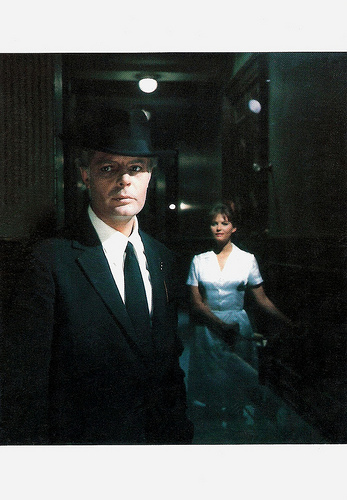
French postcard by Edition La Malibran, Paris, no. MC 38, 1990. Photo: Claude Schwartz. Publicity still for Otto e Mezzo / 8½ (Federico Fellini, 1963) with Marcello Mastroianni .
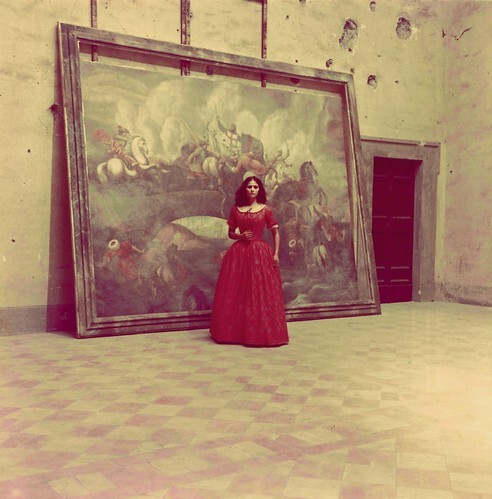
Original film still. Photo: G. B. Poletto. Claudia Cardinale in Il Gattopardo / The Leopard (Luchino Visconti, 1963).
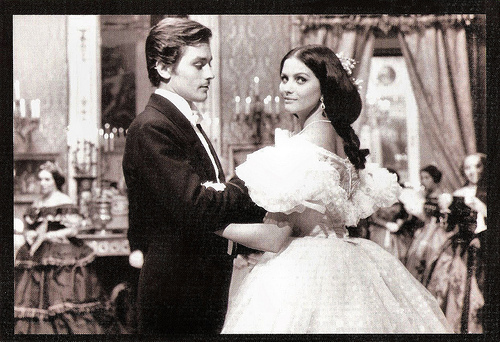
Vintage card. Photo: publicity still for Il Gattopardo / The Leopard (Luchino Visconti, 1963) with Alain Delon .
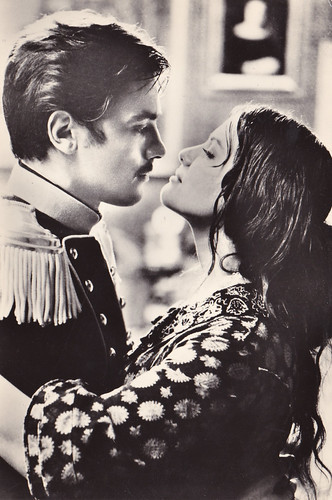
Czech postcard by Pressfoto, Praha (Prague). Photo: G.B. Poletto. Alain Delon and Claudia Cardinale in Il Gattopardo / The Leopard (Luchino Visconti, 1963). Collection: Carla Bosch.
Original Italian trailer of 8½ (1963). Source: Raúl Quintanilla (YouTube).
Original Italian trailer of Il Gattopardo / The Leopard (1963). Source: Blondinka Inoz (YouTube).
Sources: Jason Ankeny (AllMovie - Page now defunct), Roger Fristoe (TCM - now defunct), and Wikipedia.
To be continued tomorrow.

French postcard by E.D.U.G., no. 316. Photo: Sam Lévin.

Italian postcard by Rotalfoto (Rotalcolor), Milano, no. N. 203.

German postcard by Krüger, no. 902/164. Photo: Georg Michalke / UFA.

German postcard by Krüger, no. 902/132. Photo: Sam Levin / Ufa.

French postcard by E.D.U.G., no. 243, offered by Les Carbones Korès Carboplane. Photo: Sam Lévin.

German postcard by Filmbilder-Vertrieb Ernst Freihoff, Essen, no. H 72.

German postcard by Krüger, no. 902/115.
The most beautiful Italian girl in Tunisia
Claude Joséphine Rose Cardinale was born in La Goulette in Tunisia in 1938 (some sources claim 1939). Her mother, Yolande Greco, was born in Tunisia to Italian (Sicilian) emigrants from Trapani, Italy. Her father was an Italian (Sicilian) railway worker, born in Gela, Italy.
Her native languages were Tunisian Arabic and French. She received a French education, and she had to learn Italian once she pursued her acting career.
She had her breakthrough in films after she was voted the most beautiful Italian girl in Tunisia in 1957. The contest of the Italian embassy had as a prize a trip to the Venice Film Festival. She made her film debut in the French-Tunisian coproduction Goha (Jacques Baratier, 1958), starring Omar Sharif.
After attending the Centro Sperimentale di Cinematografia in Rome for two months, she signed a 7-year contract with the Vides studios. The contract forbade her to cut her hair, to marry or to gain weight.
Later that year, she had a role in the heist comedy I soliti ignoti / Big Deal On Madonna Street (Mario Monicelli, 1958) with Vittorio Gassman and Renato Salvatori . The film was an international success, and her film career was off and running.

French postcard by Editions P.I., no. FK 104. Photo: Herbert Fried / Ufa.

German postcard by Kolibri-Verlag. Collection: Meiter.

West German postcard by Ufa/Film-Foto, Berlin-Tempelhof, no. FK 5143. Photo: Herbert Fried / Ufa.

German postcard by Kolibri (W. Sander Verlag, Minden), no. 1865.

German postcard by Kolibri (W. Sander Verlag, Minden), no. 1968.

Dutch postcard.

French postcard by Editions P.I., Paris, French licence holder for Ufa, presented by Les Carbones Korès 'Carboplane', no. FK 99 B. Photo: Gérard Décaux / Ufa.
After BB Comes CC
At this point, the press, noting her initials, announced that CC was the natural successor to BB ( Brigitte Bardot ), and began beating the drum on her behalf.
Dozens of alluring photographs of Claudia Cardinale were displayed in newspapers and magazines throughout the world. According to IMDb , she has appeared on more than 900 magazine covers in over 25 countries.
The contrast between these pictures and those of Marilyn Monroe or Jayne Mansfield is striking. Cardinale never appeared in a nude or fully topless scene. Her pictures promoted an image of a shy family girl who just happened to have a beautiful face and a sexy body.
A photograph of Cardinale was featured in the original gatefold artwork to Bob Dylan's album 'Blonde on Blonde' (1966), but because it was used without Cardinale's permission, the photo was removed from the cover art in later pressings.

East German postcard by VEB Progress Filmvertrieb, Berlin, no. 2949, 1967.

East German postcard by VEB Progress Filmvertrieb, no. 1187, 1960. Publicity still for Tre straniere a Roma / Three Strangers in Rome (Claudio Gora, 1958) with Yvonne Monlaur and Françoise Darnell.

East German postcard by VEB Progress Filmvertrieb. Publicity still for Tre straniere a Roma/Three Strangers in Rome (Claudio Gora, 1958) with Leonardo Botta.

Small Czech collectors card by Pressfoto, Praha (Prague), 1965, no. S 101/3. Photo: Claudia Cardinale and Renato Salvatori in Audace colpo dei soliti ignoti / Fiasco in Milan (Nanni Loy, 1959).

Small Czech collectors card by Pressfoto, Praha (Prague), 1965, no. S 101/5. Photo: Claudia Cardinale , Alain Delon , Max Cartier and Renato Salvatori in Rocco e i suoi fratelli/Rocco and His Brothers (Luchino Visconti, 1960).

Small Czech collectors card by Pressfoto, Praha (Prague), 1965, no. S 101/6. Photo: G.B. Poletto. Claudia Cardinale , Paolo Stoppa and Alain Delon in Il gattopardo/The Leopard (Luchino Visconti, 1963).

East German postcard by VEB Progress Filmvertrieb, Berlin, no. 2569, 1965.
Manager-producer-husband
Claudia Cardinale's early career was largely managed by producer Franco Cristaldi. Because of her film contract, she told everyone that her son Patrizio was her baby brother. He was born out of wedlock when she was 17. The father was a mysterious Frenchman. She did not reveal to the child that he was her son until he was 19 years old. In 1966, she married Cristaldi, who adopted Patrizio.
In only three years, she made a stream of great films. First, she made three successful comedies, Un Maledetto imbroglio / The Facts of Murder (Pietro Germi, 1959), Il Bell'Antonio / Bell'Antonio (Mauro Bolognini, 1960) featuring Marcello Mastroianni , and Audace colpo dei soliti ignoti / Fiasco in Milan (Nanni Loy, 1960).
Cardinale had a supporting part in the epic drama Rocco e i suoi fratelli / Rocco and His Brothers (Luchino Visconti, 1960) in which she played the sister-in-law of Alain Delon and Renato Salvatori.
And then followed leading parts in La Ragazza con la valigia / Girl with a Suitcase (Valerio Zurlini, 1961), La Viaccia / The Lovemakers (Mauro Bolognini, 1961) with Jean-Paul Belmondo , and Senilità / Careless (Mauro Bolognini, 1961).

German postcard by Krüger.

French postcard.

German postcard by ISV, Sort. 10/6.

Dutch postcard, Serie 6.

French postcard by Editions P.I., Paris, no. 1084, offered by Corvisart, Epinal. Photo: Ektachrome Anders.

Belgian collector card no. 25 (of 26). Claudia Cardinale in Cartouche (Philippe de Broca, 1962).

Spanish postcard by Postal Oscar Color, Hospitalet (Barcelona), no. 521, 1963.
Deep voice and heavy accent
Claudia Cardinale had a deep, sultry voice and spoke Italian with a heavy French accent, so her voice was dubbed in her early films.
In Federico Fellini 's 8½ (1963), she was finally allowed to dub her own dialogue. In the film, she plays a dream woman - a character named Claudia, who is the object of the fantasies of the director in the film, played by Marcello Mastroianni . With Fellini's surrealistic masterpiece, she received her widest exposure to date.
That same year, she also appeared in another masterpiece of Italian cinema, the epic Il Gattopardo / The Leopard (Luchino Visconti, 1963) with Burt Lancaster and Alain Delon .
The combined success of these two classic films made her rise to the front ranks of Italian cinema. And it also piqued Hollywood's interest...

Dutch postcard by Hercules, Haarlem, no. 262.

German postcard by Rüdel Verlag, no. 3561. Photo: PALLAS / Vogelmann. Claudia Cardinale in Cartouche (Philippe de Broca, 1962). Collection: Marlene Pilaete.

French postcard by Edition La Malibran, Paris, no. MC 38, 1990. Photo: Claude Schwartz. Publicity still for Otto e Mezzo / 8½ (Federico Fellini, 1963) with Marcello Mastroianni .

Original film still. Photo: G. B. Poletto. Claudia Cardinale in Il Gattopardo / The Leopard (Luchino Visconti, 1963).

Vintage card. Photo: publicity still for Il Gattopardo / The Leopard (Luchino Visconti, 1963) with Alain Delon .

Czech postcard by Pressfoto, Praha (Prague). Photo: G.B. Poletto. Alain Delon and Claudia Cardinale in Il Gattopardo / The Leopard (Luchino Visconti, 1963). Collection: Carla Bosch.
Original Italian trailer of 8½ (1963). Source: Raúl Quintanilla (YouTube).
Original Italian trailer of Il Gattopardo / The Leopard (1963). Source: Blondinka Inoz (YouTube).
Sources: Jason Ankeny (AllMovie - Page now defunct), Roger Fristoe (TCM - now defunct), and Wikipedia.
To be continued tomorrow.
Published on September 24, 2025 22:00
September 23, 2025
Ralph Bellamy
American actor Ralph Bellamy (1904 -1991) was best known for his work in screwball comedies and dramatic stage productions. He never became a major star, but he made a career out of playing second leads in major productions before developing into a character actor.
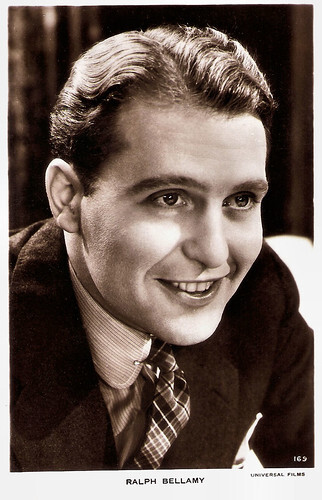
British postcard, no. 169. Photo: Universal Films.
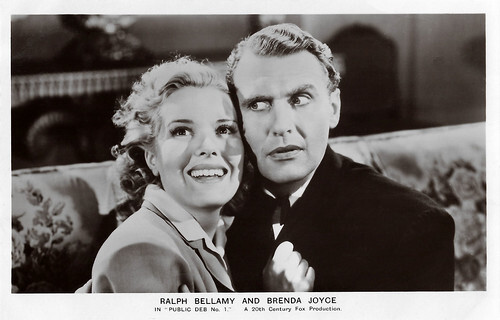
British postcard in the Film Partners Series, London, no. P322. Photo: 20th Century Fox. Ralph Bellamy and Brenda Joyce in Public Deb No. 1 (Gregory Ratoff, 1940).
A master of sophisticated comedy
Ralph Rexford Bellamy was born in 1904 in Chicago, Illinois, and grew up in the Chicago suburb of Winnetka. Ralph was the son of Lilla Louise (Smith) and Charles Rexford Bellamy.
He began his involvement with theatre as a teen. He attended New Trier High School in Winnetka and was president of the Drama Club there. Ralph ran away from home at age 17 to join a travelling band of Shakespearean players. In 1922, he formed his own troupe of actors, the North Shore Players, in the Chicago area.
Later, he performed in repertory, in touring companies, and in multiple roles with his repertory troupe, the Ralph Bellamy Players (1926–1929), which he formed in Des Moines, Iowa. He appeared in two unsuccessful Broadway plays in 1929 and 1930, but this was enough to secure him a film contract in 1930. Overall, he spent nine years in repertory and touring companies, playing over 400 roles, including an average of two or three in each play.
Bellamy’s first film role was as a gangster in the crime picture The Secret 6 (George W. Hill, 1931) starring Wallace Beery . In dozens of films over the coming years, he became a master of sophisticated comedy, often cast as a sympathetic yet naive character who loses the girl to the leading man. Typical films from this period included Hands Across the Table (Mitchell Leisen, 1935), in which he lost Carole Lombard to Fred MacMurray .
Bellamy drew particular praise for The Awful Truth (Leo McCarey, 1937), in which he appeared as an oil baron whom Irene Dunne toys with before returning to Cary Grant . For his performance, Bellamy received his first and only Academy Award nomination. After losing Ginger Rogers to Fred Astaire in Carefree (Mark Sandrich, 1938), he again was bested by Grant in His Girl Friday (Howard Hawks, 1940) with Rosalind Russell . Bellamy also starred as the wealthy detective in four Ellery Queen mystery movies. He also appeared in the Horror films The Wolf Man (George Waggner, 1941) with Lon Chaney Jr. and The Ghost of Frankenstein (Erle C. Kenton, 1942) with Chaney and Bela Lugosi .
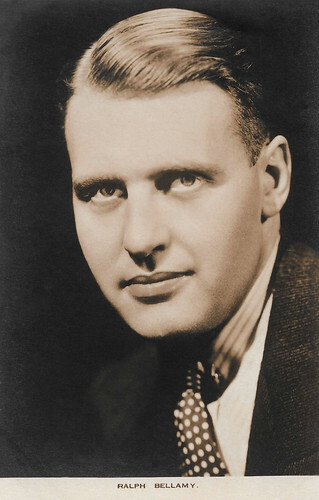
British postcard in the Film Weekly Series, London.
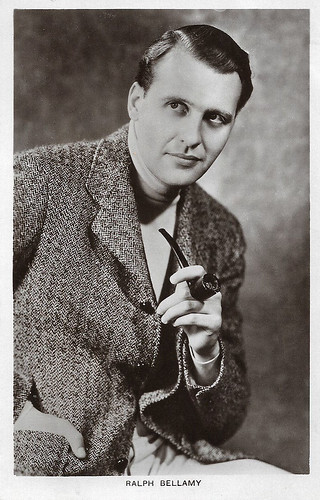
British postcard in the Picturegoer Series, London, no. 683.
A brilliant, emotionally charged portrayal of Franklin D. Roosevelt
By the 1940s, Ralph Bellamy had come to favour acting on Broadway and in 1943 secured his stage reputation as an antifascist professor in 'Tomorrow the World'. He also had a successful run (1945–1947) as the star of the comedy 'State of the Union'. He achieved his greatest acclaim on Broadway with his dramatic, emotionally charged portrayal of Franklin D. Roosevelt as he battled polio in Dore Schary's play 'Sunrise at Campobello' (1958), for which he won a Tony Award.
He reprised his brilliant portrayal of Roosevelt in the film version Sunrise at Campobello (Vincent J. Donehue, 1960) with Greer Garson as Eleanor Roosevelt and again in 1983 for the television miniseries The Winds of War (Dan Curtis, 1983). He also appeared in numerous anthology television shows during the 1950s.
Bellamy later played the satanic doctor in the Horror classic Rosemary’s Baby (Roman Polanski, 1968), and he won a new generation of fans with his performance as one of the wealthy Duke brothers, the other being Don Ameche , in Trading Places (John Landis, 1983), starring Eddie Murphy and Dan Aykroyd .
His last performance was in Pretty Woman (Garry Marshall, 1990) starring Julia Roberts and Richard Gere . Bellamy made more than 100 films during his career, and he also served as president of Actors’ Equity (1952–1964) and was a founder and board member of the Screen Actors Guild. He wrote an autobiography, 'When the Smoke Hit the Fan' (1979), and received an honorary Academy Award in 1987 for the body of his film work.
Ralph Bellamy died in 1991 in Santa Monica, California. He was 87 years old. He was interred at Forest Lawn Memorial Park (Hollywood Hills) in Los Angeles, California. Bellamy was married four times: first to Alice Delbridge (1927–1930), then to Catherine Willard (1931–1945), and to organist Ethel Smith (1945–1947). Bellamy's fourth wife was Alice Murphy (1949–1991; his death). The actor had two children: Lynn Bellamy and Willard Bellamy.
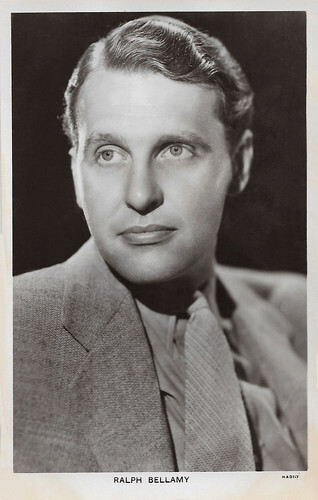
British postcard in the Picturegoer Series, London, no. 683a. Photo: Radio.
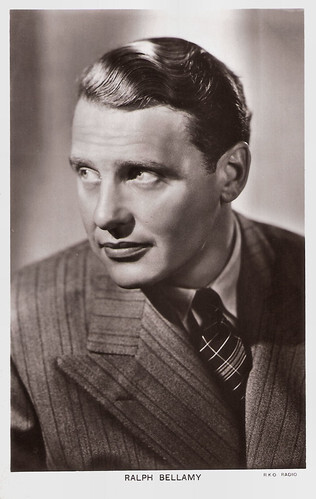
British postcard in the Picturegoer Series, London, no. 683b. Photo: R.K.O. Radio.
Sources: (IMDb), Encyclopaedia Britannica, Wikipedia and .

British postcard, no. 169. Photo: Universal Films.

British postcard in the Film Partners Series, London, no. P322. Photo: 20th Century Fox. Ralph Bellamy and Brenda Joyce in Public Deb No. 1 (Gregory Ratoff, 1940).
A master of sophisticated comedy
Ralph Rexford Bellamy was born in 1904 in Chicago, Illinois, and grew up in the Chicago suburb of Winnetka. Ralph was the son of Lilla Louise (Smith) and Charles Rexford Bellamy.
He began his involvement with theatre as a teen. He attended New Trier High School in Winnetka and was president of the Drama Club there. Ralph ran away from home at age 17 to join a travelling band of Shakespearean players. In 1922, he formed his own troupe of actors, the North Shore Players, in the Chicago area.
Later, he performed in repertory, in touring companies, and in multiple roles with his repertory troupe, the Ralph Bellamy Players (1926–1929), which he formed in Des Moines, Iowa. He appeared in two unsuccessful Broadway plays in 1929 and 1930, but this was enough to secure him a film contract in 1930. Overall, he spent nine years in repertory and touring companies, playing over 400 roles, including an average of two or three in each play.
Bellamy’s first film role was as a gangster in the crime picture The Secret 6 (George W. Hill, 1931) starring Wallace Beery . In dozens of films over the coming years, he became a master of sophisticated comedy, often cast as a sympathetic yet naive character who loses the girl to the leading man. Typical films from this period included Hands Across the Table (Mitchell Leisen, 1935), in which he lost Carole Lombard to Fred MacMurray .
Bellamy drew particular praise for The Awful Truth (Leo McCarey, 1937), in which he appeared as an oil baron whom Irene Dunne toys with before returning to Cary Grant . For his performance, Bellamy received his first and only Academy Award nomination. After losing Ginger Rogers to Fred Astaire in Carefree (Mark Sandrich, 1938), he again was bested by Grant in His Girl Friday (Howard Hawks, 1940) with Rosalind Russell . Bellamy also starred as the wealthy detective in four Ellery Queen mystery movies. He also appeared in the Horror films The Wolf Man (George Waggner, 1941) with Lon Chaney Jr. and The Ghost of Frankenstein (Erle C. Kenton, 1942) with Chaney and Bela Lugosi .

British postcard in the Film Weekly Series, London.

British postcard in the Picturegoer Series, London, no. 683.
A brilliant, emotionally charged portrayal of Franklin D. Roosevelt
By the 1940s, Ralph Bellamy had come to favour acting on Broadway and in 1943 secured his stage reputation as an antifascist professor in 'Tomorrow the World'. He also had a successful run (1945–1947) as the star of the comedy 'State of the Union'. He achieved his greatest acclaim on Broadway with his dramatic, emotionally charged portrayal of Franklin D. Roosevelt as he battled polio in Dore Schary's play 'Sunrise at Campobello' (1958), for which he won a Tony Award.
He reprised his brilliant portrayal of Roosevelt in the film version Sunrise at Campobello (Vincent J. Donehue, 1960) with Greer Garson as Eleanor Roosevelt and again in 1983 for the television miniseries The Winds of War (Dan Curtis, 1983). He also appeared in numerous anthology television shows during the 1950s.
Bellamy later played the satanic doctor in the Horror classic Rosemary’s Baby (Roman Polanski, 1968), and he won a new generation of fans with his performance as one of the wealthy Duke brothers, the other being Don Ameche , in Trading Places (John Landis, 1983), starring Eddie Murphy and Dan Aykroyd .
His last performance was in Pretty Woman (Garry Marshall, 1990) starring Julia Roberts and Richard Gere . Bellamy made more than 100 films during his career, and he also served as president of Actors’ Equity (1952–1964) and was a founder and board member of the Screen Actors Guild. He wrote an autobiography, 'When the Smoke Hit the Fan' (1979), and received an honorary Academy Award in 1987 for the body of his film work.
Ralph Bellamy died in 1991 in Santa Monica, California. He was 87 years old. He was interred at Forest Lawn Memorial Park (Hollywood Hills) in Los Angeles, California. Bellamy was married four times: first to Alice Delbridge (1927–1930), then to Catherine Willard (1931–1945), and to organist Ethel Smith (1945–1947). Bellamy's fourth wife was Alice Murphy (1949–1991; his death). The actor had two children: Lynn Bellamy and Willard Bellamy.

British postcard in the Picturegoer Series, London, no. 683a. Photo: Radio.

British postcard in the Picturegoer Series, London, no. 683b. Photo: R.K.O. Radio.
Sources: (IMDb), Encyclopaedia Britannica, Wikipedia and .
Published on September 23, 2025 22:00
September 22, 2025
Werner Hinz
Werner Hinz (1903-1985) was a German film actor who appeared in 70 films between 1935 and 1984. During the Second World War, he appeared in several Nazi propaganda films, such as Bismarck (1940), with Paul Hartmann in the title role.
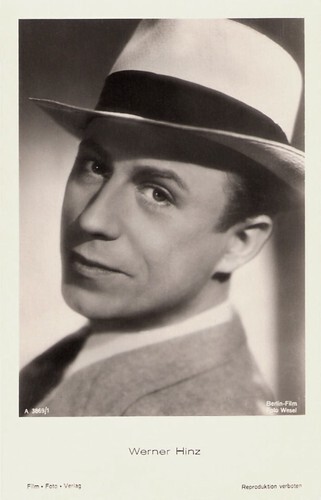
German postcard by Film-Foto-Verlag, no. A 3869/1, 1941-1944. Photo: Wesel / Berlin-Film.
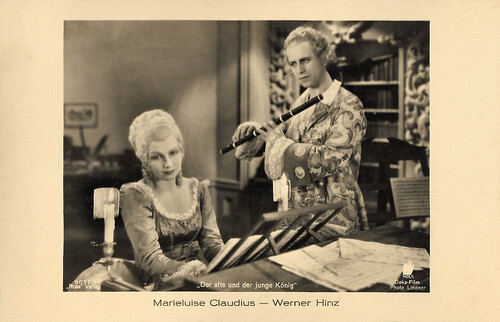
German postcard by Ross Verlag, no. 9052/1, 1935-1936. Photo: Lindner / Deka-Film / NDLS. Marieluise Claudius and Werner Hinz in Der alte und der junge König / The Making of a King (Hans Steinhoff, 1935).
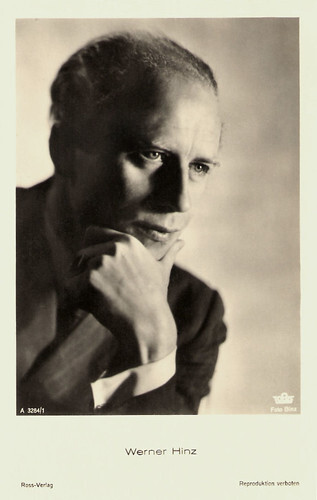
German postcard by Ross Verlag, no. A 3284/1, 1941-1944. Photo: Binz / Tobis.
A man without qualities, who had all the qualities at his disposal
Werner Heinz Alfons Hinz was born in 1903 in Berlin in the German Empire. His parents were the authorised signatory Oskar Hinz and his wife Hedwig Hinz, née Abel. He studied drama in his home town, at the school created by Max Reinhardt as part of the Deutsches Theater. He made his stage debut in 1922, in Frank Wedekind's 'Frühlings Erwachen' (Spring Awakening).
Throughout his career, he remained active in the theatre. He played at the Hamburg Kammerspiele in 1924/1925, at the Schauspielhaus Zürich in 1928/1929, in Darmstadt from 1929 to 1932, at the Deutsches Schauspielhaus Hamburg from 1932 to 1939 and at the Volksbühne Berlin from 1939 to 1944, before returning to the Deutsches Theater from 1947 to 1950. He had a wide range of roles at his disposal, Georg Hensel described him in his obituary in 1985 as a ‘man without qualities, who had all the qualities at his disposal.’
Werner Hinz made his first film appearance in 1929 in the Swiss short film Hallo Switzerland! In 1935, he made his actual film debut opposite Emil Jannings in the Prussian film Der alte und der junge König / The Old and the Young King (Hans Steinhoff, 1935). The film is a historical drama about the intense conflict between Prussian King Friedrich Wilhelm I and his son and heir, Crown Prince Friedrich (Hinz) – the future King Friedrich II "The Great".
Between 1935 and 1945, Hinz had roles in 17 films that were mostly praised by Joseph Goebbels, the head of the Ministry of Public Enlightenment and Propaganda. He appeared in the anti-Soviet propaganda film Weisse Sklaven / White Slaves (Karl Anton, 1937). The film, also known as Panzerkreuzer Sebastopol: Weisse Sklaven / Battleship Sevastopol: White Slaves, was designed as a response to Sergei Eisenstein 's Bronenosets Potyomkin / Battleship Potemkin (1925).
He also appeared in the anti-British propaganda dramas Der Fuchs von Glenarvon / The Fox of Glenarvon (Max W. Kimmich, 1940), portraying the Irish fight for independence during World War I, and Mein Leben für Irland / My Life for Ireland (Max W. Kimmich, 1941). Another propaganda film attacking the United Kingdom was the German biographical film Ohm Krüger / Uncle Krüger (Hans Steinhoff, 1941) starring Emil Jannings as the South African politician Paul Kruger, who was eventually defeated by the British during the Boer War. In 1944, Werner Hinz was included on the Gottbegnadeten list (list of artists considered crucial to National Socialist culture) created by Goebbels.
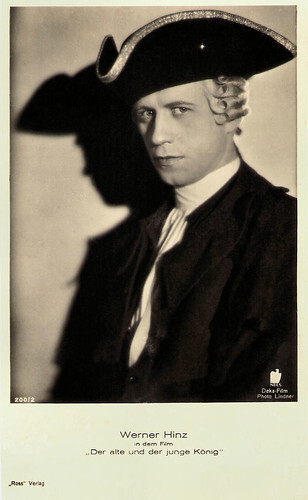
German postcard by Ross Verlag, no. 200/2. Photo: Lindner / Deka-Film. Werner Hinz in Der alte und der junge König / The Old and the Young King (Hans Steinhoff, 1935).
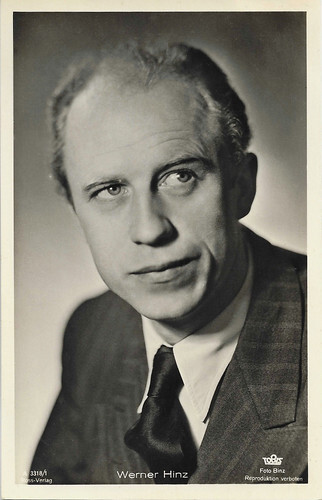
German postcard by Ross Verlag, no. A 3318/1, 1941-1944. Photo: Binz / Tobis.
Regularly serious and sometimes arrogant or calculating characters
After the war, Werner Hinz continued his career in the German cinema. A notable exception was his contribution to the American War film The Longest Day (Ken Annakin, a.o., 1962), starring John Wayne and Henry Fonda . Hinz played Erwin Rommel.
His other post-war films included Feuerwerk / Fireworks (Kurt Hoffmann, 1954), with Lilli Palmer and Romy Schneider , and Bekenntnisse des Hochstaplers Felix Krull / The Confessions of Felix Krull (Kurt Hoffmann, 1957), with Horst Buchholz and Liselotte Pulver .
Hinz's characters are regularly serious and sometimes arrogant, such as Kaiser Wilhelm in Die Entlassung / The Dismissal (Wolfgang Liebeneiner, 1942), calculating, such as Zaharoff in Herz der Welt / No Greater Love (Harald Braun, 1952), dignified, such as Consul Buddenbrook in Buddenbrooks (Alfred Weidenmann, 1959), and repeatedly military, such as Colonel General Beck in Der 20. Juli / The Plot to Assassinate Hitler (Falk Harnack, 1955).
Between 1960 and 1985, Werner Hinz appeared in twenty-seven TV films. He also acted in eight series, including episodes of the popular Krimis Tatort / Crime Scene (1971), Der Kommissar / The Commissioner (1974) and Derrick (1977).
Hinz's first marriage was to the writer and translator Ilona Koenig in 1926, and after their divorce in 1934, to the actress Ehmi Bessel. Their two children, Knut and Michael, also became actors. Their daughter Dinah, who came from a relationship between Ehmi and the aviator general Ernst Udet, also became an actress. Werner Hinz died in 1985 in Hamburg, West Germany. He was 82. He is buried in Berlin's Dahlem cemetery.
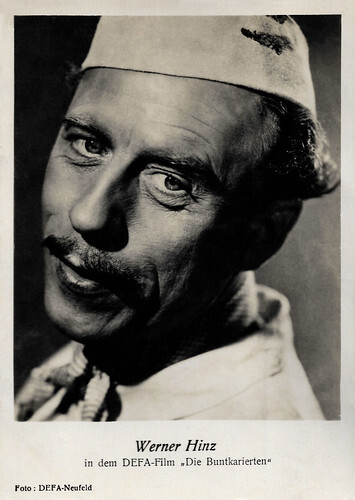
East German postcard by Deutscher Filmverlag G.m.b.H., Berlin, no. 105. Photo: DEFA / Neufeld. Photo: Werner Hinz in Die Buntkarierten / The Girls in Gingham (Kurt Maetzig, 1949).
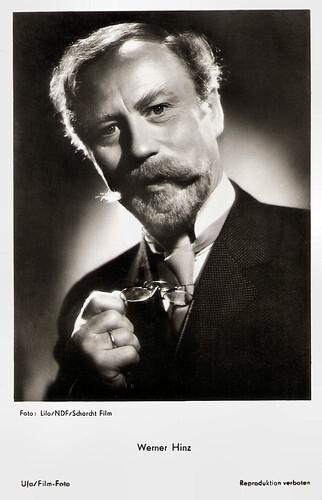
West-German postcard by Ufa/Film-Foto, Berlin-Tempelhof, no. FK 1087. Photo: Lilo / NDF Film / Schorcht Film. Werner Hinz in Feuerwerk / Fireworks (Kurt Hoffmann, 1954).
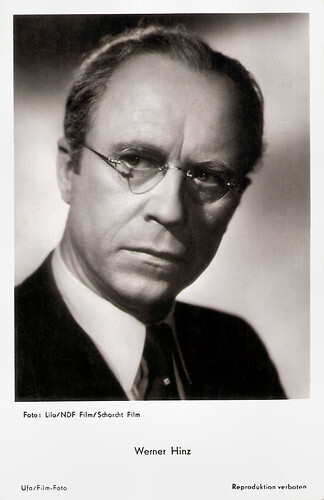
West-German postcard by Ufa/Film-Foto. Photo: Lilo / NDF Film / Schorcht Film. Werner Hinz in Der letzte Sommer / The Last Summer (Harald Braun, 1954).
Sources: Wikipedia (English and German) and .

German postcard by Film-Foto-Verlag, no. A 3869/1, 1941-1944. Photo: Wesel / Berlin-Film.

German postcard by Ross Verlag, no. 9052/1, 1935-1936. Photo: Lindner / Deka-Film / NDLS. Marieluise Claudius and Werner Hinz in Der alte und der junge König / The Making of a King (Hans Steinhoff, 1935).

German postcard by Ross Verlag, no. A 3284/1, 1941-1944. Photo: Binz / Tobis.
A man without qualities, who had all the qualities at his disposal
Werner Heinz Alfons Hinz was born in 1903 in Berlin in the German Empire. His parents were the authorised signatory Oskar Hinz and his wife Hedwig Hinz, née Abel. He studied drama in his home town, at the school created by Max Reinhardt as part of the Deutsches Theater. He made his stage debut in 1922, in Frank Wedekind's 'Frühlings Erwachen' (Spring Awakening).
Throughout his career, he remained active in the theatre. He played at the Hamburg Kammerspiele in 1924/1925, at the Schauspielhaus Zürich in 1928/1929, in Darmstadt from 1929 to 1932, at the Deutsches Schauspielhaus Hamburg from 1932 to 1939 and at the Volksbühne Berlin from 1939 to 1944, before returning to the Deutsches Theater from 1947 to 1950. He had a wide range of roles at his disposal, Georg Hensel described him in his obituary in 1985 as a ‘man without qualities, who had all the qualities at his disposal.’
Werner Hinz made his first film appearance in 1929 in the Swiss short film Hallo Switzerland! In 1935, he made his actual film debut opposite Emil Jannings in the Prussian film Der alte und der junge König / The Old and the Young King (Hans Steinhoff, 1935). The film is a historical drama about the intense conflict between Prussian King Friedrich Wilhelm I and his son and heir, Crown Prince Friedrich (Hinz) – the future King Friedrich II "The Great".
Between 1935 and 1945, Hinz had roles in 17 films that were mostly praised by Joseph Goebbels, the head of the Ministry of Public Enlightenment and Propaganda. He appeared in the anti-Soviet propaganda film Weisse Sklaven / White Slaves (Karl Anton, 1937). The film, also known as Panzerkreuzer Sebastopol: Weisse Sklaven / Battleship Sevastopol: White Slaves, was designed as a response to Sergei Eisenstein 's Bronenosets Potyomkin / Battleship Potemkin (1925).
He also appeared in the anti-British propaganda dramas Der Fuchs von Glenarvon / The Fox of Glenarvon (Max W. Kimmich, 1940), portraying the Irish fight for independence during World War I, and Mein Leben für Irland / My Life for Ireland (Max W. Kimmich, 1941). Another propaganda film attacking the United Kingdom was the German biographical film Ohm Krüger / Uncle Krüger (Hans Steinhoff, 1941) starring Emil Jannings as the South African politician Paul Kruger, who was eventually defeated by the British during the Boer War. In 1944, Werner Hinz was included on the Gottbegnadeten list (list of artists considered crucial to National Socialist culture) created by Goebbels.

German postcard by Ross Verlag, no. 200/2. Photo: Lindner / Deka-Film. Werner Hinz in Der alte und der junge König / The Old and the Young King (Hans Steinhoff, 1935).

German postcard by Ross Verlag, no. A 3318/1, 1941-1944. Photo: Binz / Tobis.
Regularly serious and sometimes arrogant or calculating characters
After the war, Werner Hinz continued his career in the German cinema. A notable exception was his contribution to the American War film The Longest Day (Ken Annakin, a.o., 1962), starring John Wayne and Henry Fonda . Hinz played Erwin Rommel.
His other post-war films included Feuerwerk / Fireworks (Kurt Hoffmann, 1954), with Lilli Palmer and Romy Schneider , and Bekenntnisse des Hochstaplers Felix Krull / The Confessions of Felix Krull (Kurt Hoffmann, 1957), with Horst Buchholz and Liselotte Pulver .
Hinz's characters are regularly serious and sometimes arrogant, such as Kaiser Wilhelm in Die Entlassung / The Dismissal (Wolfgang Liebeneiner, 1942), calculating, such as Zaharoff in Herz der Welt / No Greater Love (Harald Braun, 1952), dignified, such as Consul Buddenbrook in Buddenbrooks (Alfred Weidenmann, 1959), and repeatedly military, such as Colonel General Beck in Der 20. Juli / The Plot to Assassinate Hitler (Falk Harnack, 1955).
Between 1960 and 1985, Werner Hinz appeared in twenty-seven TV films. He also acted in eight series, including episodes of the popular Krimis Tatort / Crime Scene (1971), Der Kommissar / The Commissioner (1974) and Derrick (1977).
Hinz's first marriage was to the writer and translator Ilona Koenig in 1926, and after their divorce in 1934, to the actress Ehmi Bessel. Their two children, Knut and Michael, also became actors. Their daughter Dinah, who came from a relationship between Ehmi and the aviator general Ernst Udet, also became an actress. Werner Hinz died in 1985 in Hamburg, West Germany. He was 82. He is buried in Berlin's Dahlem cemetery.

East German postcard by Deutscher Filmverlag G.m.b.H., Berlin, no. 105. Photo: DEFA / Neufeld. Photo: Werner Hinz in Die Buntkarierten / The Girls in Gingham (Kurt Maetzig, 1949).

West-German postcard by Ufa/Film-Foto, Berlin-Tempelhof, no. FK 1087. Photo: Lilo / NDF Film / Schorcht Film. Werner Hinz in Feuerwerk / Fireworks (Kurt Hoffmann, 1954).

West-German postcard by Ufa/Film-Foto. Photo: Lilo / NDF Film / Schorcht Film. Werner Hinz in Der letzte Sommer / The Last Summer (Harald Braun, 1954).
Sources: Wikipedia (English and German) and .
Published on September 22, 2025 22:00
September 21, 2025
Duke Ellington
American pianist, bandleader and songwriter Duke Ellington (1899–1974) was an originator of Big-Band Jazz, and created one of the most distinctive ensemble sounds in western music. He composed thousands of scores over his 50-year career and continued to play until shortly before he died in 1974.
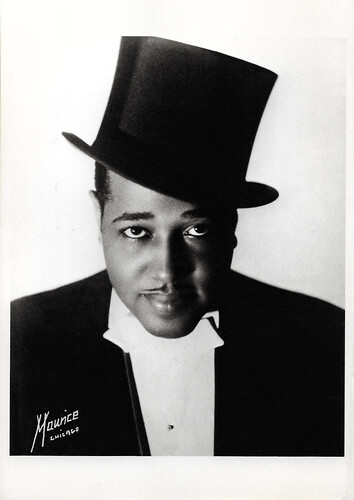
American postcard by Fotofolio, NY, NY, no. M116. Photo: Maurice Seymour, Chicago / Frank Driggs Collection. Caption: Duke Ellington, 1934.
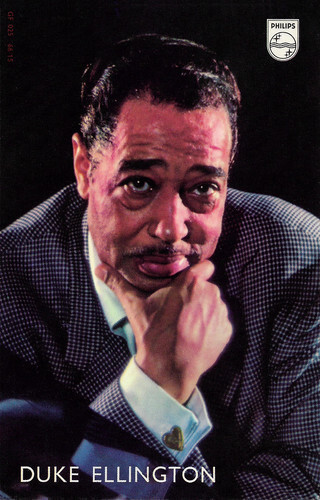
Dutch promotion card by Philips, no. GF 025 66 15.
Part of the Harlem Renaissance
Duke Ellington was born in 1899, in Washington, D.C., where he was raised by two talented, musical parents in a middle-class neighbourhood. At the age of 7, he began studying piano and earned the nickname 'Duke' for his gentlemanly ways. Inspired by his job as a soda jerk at the Poodle Dog Cafe, he wrote his first composition, 'Soda Fountain Rag', at the age of 15. He created it by ear because he had not yet learned to read and write music.
Despite being awarded an art scholarship to the Pratt Institute in Brooklyn, New York, Ellington followed his passion for Ragtime and began to play professionally at age 17. In late 1917, he formed his first group, 'The Duke's Serenaders'.
He moved to Harlem, ultimately becoming part of the Harlem Renaissance. New dance crazes like the Charleston emerged in Harlem, as well as African-American musical theatre. From 1924 on, Ellington performed in Broadway nightclubs as the bandleader of a sextet, a group which in time grew to a 10-piece ensemble.
From 1927 on, he gained a national profile through his orchestra's appearances at the legendary Cotton Club in Harlem. With a weekly radio broadcast, the Cotton Club's exclusively white and wealthy clientele poured in nightly to see them. At the Cotton Club, Ellington's group performed all the music for the revues, which mixed comedy, dance numbers, vaudeville, burlesque, music, and illegal alcohol.
In 1929, the Cotton Club Orchestra appeared on stage for several months in 'Florenz Ziegfeld's Show Girl', along with vaudeville stars Jimmy Durante , Eddie Foy, Jr., Ruby Keeler, and with music and lyrics by George Gershwin and Gus Kahn.
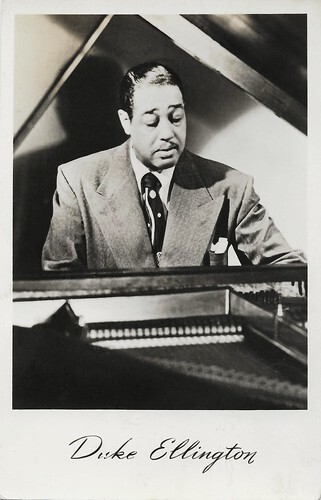
Dutch postcard by Takken, no. 2096.
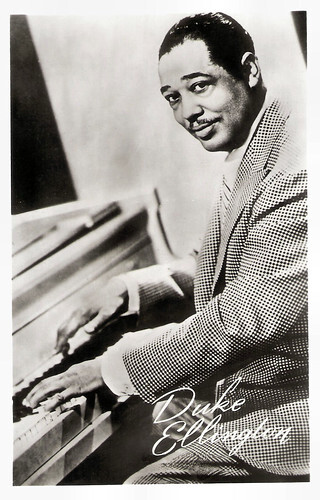
Dutch postcard by Takken, no. 3009.
Complex yet accessible jazz that made the heart swing
Duke Ellington made hundreds of recordings with his bands, appeared in films and on the radio, and toured Europe on two occasions in the 1930s. Ellington's film work began with Black and Tan (Dudley Murphy, 1929), a nineteen-minute all-African-American RKO short in which he played the hero Duke. He also appeared in the Amos 'n' Andy film Check and Double Check (Melville W. Brown, 1930). Ivie Anderson was hired as his orchestra's featured vocalist in 1931. She is the vocalist on 'It Don't Mean a Thing (If It Ain't Got That Swing)' (1932) among other recordings.
Ellington and his Orchestra also appeared in the films Murder at the Vanities (Mitchell Leisen, 1934) and Belle of the Nineties (Leo McCarey, 1934), featuring Mae West . The short film Symphony in Black (Fred Waller, 1935) featured his extended piece 'A Rhapsody of Negro Life'. It introduced Billie Holiday and won an Academy Award as the best musical short subject. While the band's United States audience remained mainly African-American in this period, the Ellington orchestra had a huge following overseas, exemplified by the success of their trip to England in 1933 and their 1934 visit to the European mainland.
Ellington's fame rose to the rafters in the 1940s when he composed several masterworks, including 'Concerto for Cootie', 'Cotton Tail' and 'Ko-Ko'. His blend of melodies, rhythms and subtle sonic movements gave audiences a new experience — complex yet accessible jazz that made the heart swing. He preferred to call it 'American Music'. During the early 1950s, Ellington's career was at a low point, with his style being generally seen as outmoded. Ellington's appearance at the Newport Jazz Festival in 1956 returned him to wider prominence and introduced him to a new generation of fans.
Ellington began to work directly on scoring for film soundtracks, in particular Anatomy of a Murder (Otto Preminger, 1959), with James Stewart , in which Ellington appeared fronting a roadhouse combo, and Paris Blues (Martin Ritt, 1961), which featured Paul Newman and Sidney Poitier as jazz musicians. Ellington earned 12 Grammy awards from 1959 to 2000, nine while he was alive.
At the age of 19, Duke Ellington married Edna Thompson, who had been his girlfriend since high school, and soon after their marriage, she gave birth to their only child, Mercer Kennedy Ellington. In 1928, Ellington became the companion of Mildred Dixon, who travelled with him, managed Tempo Music, inspired songs at the peak of his career and raised his son Mercer. In 1938, he left his family and moved in with Cotton Club employee Beatrice 'Evie' Ellis. The relationship with Ellis, though stormy, continued after Ellington met Fernanda de Castro Monte in the early 1960s. Ellington supported both women for the rest of his life. In 1974, at the age of 75, Duke Ellington died of lung cancer and pneumonia. His last words were, "Music is how I live, why I live and how I will be remembered." Following Duke's death, his son Mercer took over leadership of the orchestra, continuing until his own death in 1996.
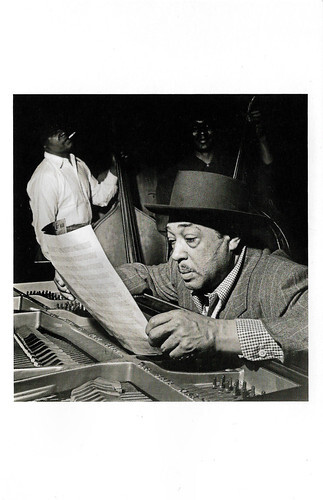
Vintage postcard. Photo: Wayne Miller / Magnum Photos. Caption: Duke Ellington rehearsing on stage at the Savoy, Chicago, Illinois, USA, 1948.
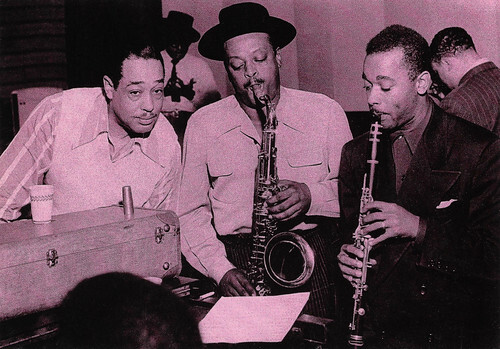
French postcard by Éditions du Désastre, no. FD05, 1992. Photo: F. Driggs Collection / Magnum/ Éditions du Désastre, Paris. Caption: Duke Ellington, Ben Webster & Jimmy Hamilton, 1948.
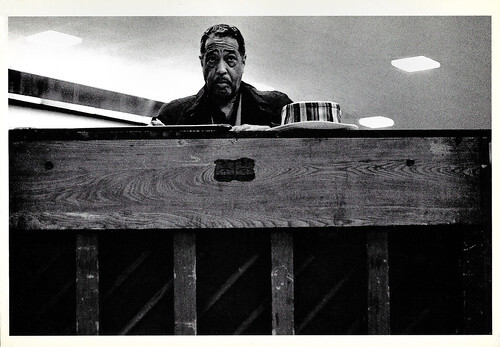
French postcard by Éditions du Désastre, Paris, no. WC 13, 1989. Photo: William Claxton. Caption: Duke Ellington, Monterey Jazz Festival 1958.
Source: Bio., and Wikipedia.

American postcard by Fotofolio, NY, NY, no. M116. Photo: Maurice Seymour, Chicago / Frank Driggs Collection. Caption: Duke Ellington, 1934.

Dutch promotion card by Philips, no. GF 025 66 15.
Part of the Harlem Renaissance
Duke Ellington was born in 1899, in Washington, D.C., where he was raised by two talented, musical parents in a middle-class neighbourhood. At the age of 7, he began studying piano and earned the nickname 'Duke' for his gentlemanly ways. Inspired by his job as a soda jerk at the Poodle Dog Cafe, he wrote his first composition, 'Soda Fountain Rag', at the age of 15. He created it by ear because he had not yet learned to read and write music.
Despite being awarded an art scholarship to the Pratt Institute in Brooklyn, New York, Ellington followed his passion for Ragtime and began to play professionally at age 17. In late 1917, he formed his first group, 'The Duke's Serenaders'.
He moved to Harlem, ultimately becoming part of the Harlem Renaissance. New dance crazes like the Charleston emerged in Harlem, as well as African-American musical theatre. From 1924 on, Ellington performed in Broadway nightclubs as the bandleader of a sextet, a group which in time grew to a 10-piece ensemble.
From 1927 on, he gained a national profile through his orchestra's appearances at the legendary Cotton Club in Harlem. With a weekly radio broadcast, the Cotton Club's exclusively white and wealthy clientele poured in nightly to see them. At the Cotton Club, Ellington's group performed all the music for the revues, which mixed comedy, dance numbers, vaudeville, burlesque, music, and illegal alcohol.
In 1929, the Cotton Club Orchestra appeared on stage for several months in 'Florenz Ziegfeld's Show Girl', along with vaudeville stars Jimmy Durante , Eddie Foy, Jr., Ruby Keeler, and with music and lyrics by George Gershwin and Gus Kahn.

Dutch postcard by Takken, no. 2096.

Dutch postcard by Takken, no. 3009.
Complex yet accessible jazz that made the heart swing
Duke Ellington made hundreds of recordings with his bands, appeared in films and on the radio, and toured Europe on two occasions in the 1930s. Ellington's film work began with Black and Tan (Dudley Murphy, 1929), a nineteen-minute all-African-American RKO short in which he played the hero Duke. He also appeared in the Amos 'n' Andy film Check and Double Check (Melville W. Brown, 1930). Ivie Anderson was hired as his orchestra's featured vocalist in 1931. She is the vocalist on 'It Don't Mean a Thing (If It Ain't Got That Swing)' (1932) among other recordings.
Ellington and his Orchestra also appeared in the films Murder at the Vanities (Mitchell Leisen, 1934) and Belle of the Nineties (Leo McCarey, 1934), featuring Mae West . The short film Symphony in Black (Fred Waller, 1935) featured his extended piece 'A Rhapsody of Negro Life'. It introduced Billie Holiday and won an Academy Award as the best musical short subject. While the band's United States audience remained mainly African-American in this period, the Ellington orchestra had a huge following overseas, exemplified by the success of their trip to England in 1933 and their 1934 visit to the European mainland.
Ellington's fame rose to the rafters in the 1940s when he composed several masterworks, including 'Concerto for Cootie', 'Cotton Tail' and 'Ko-Ko'. His blend of melodies, rhythms and subtle sonic movements gave audiences a new experience — complex yet accessible jazz that made the heart swing. He preferred to call it 'American Music'. During the early 1950s, Ellington's career was at a low point, with his style being generally seen as outmoded. Ellington's appearance at the Newport Jazz Festival in 1956 returned him to wider prominence and introduced him to a new generation of fans.
Ellington began to work directly on scoring for film soundtracks, in particular Anatomy of a Murder (Otto Preminger, 1959), with James Stewart , in which Ellington appeared fronting a roadhouse combo, and Paris Blues (Martin Ritt, 1961), which featured Paul Newman and Sidney Poitier as jazz musicians. Ellington earned 12 Grammy awards from 1959 to 2000, nine while he was alive.
At the age of 19, Duke Ellington married Edna Thompson, who had been his girlfriend since high school, and soon after their marriage, she gave birth to their only child, Mercer Kennedy Ellington. In 1928, Ellington became the companion of Mildred Dixon, who travelled with him, managed Tempo Music, inspired songs at the peak of his career and raised his son Mercer. In 1938, he left his family and moved in with Cotton Club employee Beatrice 'Evie' Ellis. The relationship with Ellis, though stormy, continued after Ellington met Fernanda de Castro Monte in the early 1960s. Ellington supported both women for the rest of his life. In 1974, at the age of 75, Duke Ellington died of lung cancer and pneumonia. His last words were, "Music is how I live, why I live and how I will be remembered." Following Duke's death, his son Mercer took over leadership of the orchestra, continuing until his own death in 1996.

Vintage postcard. Photo: Wayne Miller / Magnum Photos. Caption: Duke Ellington rehearsing on stage at the Savoy, Chicago, Illinois, USA, 1948.

French postcard by Éditions du Désastre, no. FD05, 1992. Photo: F. Driggs Collection / Magnum/ Éditions du Désastre, Paris. Caption: Duke Ellington, Ben Webster & Jimmy Hamilton, 1948.

French postcard by Éditions du Désastre, Paris, no. WC 13, 1989. Photo: William Claxton. Caption: Duke Ellington, Monterey Jazz Festival 1958.
Source: Bio., and Wikipedia.
Published on September 21, 2025 22:00
September 20, 2025
Andrée Mégard
Andrée Mégard (1869–1952) was a French actress and stage beauty. She also appeared in three silent films, worked as a theatre director and was known as a fashion icon and the muse of the Redfern company.
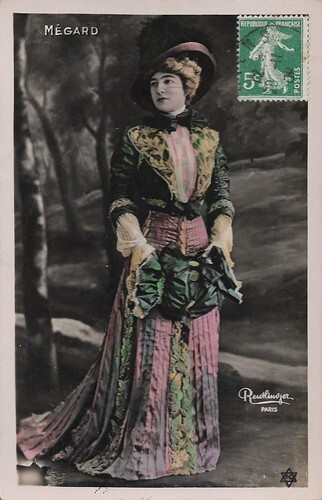
French postcard by PC. Photo: Reutlinger, Paris.
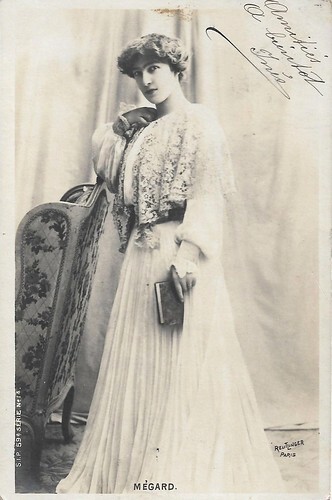
French postcard by S.I.P., 59e Série, no. 14. Photo: Reutlinger, Paris.
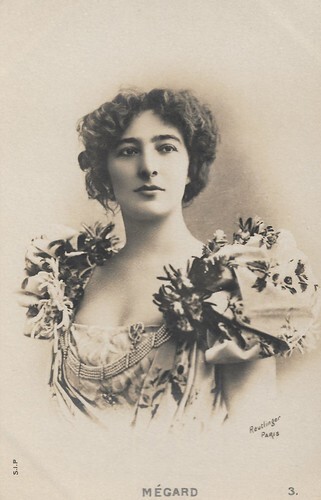
French postcard by S.I.P., no. 3. Photo: Reutlinger, Paris.
A reckless car driver
Andrée Mégard was born Marie Adélaïde Alexandrine Chamonal in 1869 in Saint-Amour, in the Jura Mountains. She was the daughter of Jules Chamonal and Marie Rose Florentine Mégard. Her parents were 'well-off peasants' who apprenticed her to an aunt who ran a dry good store.
Andrée ran away from the aunt at fifteen, and landed alone in Paris. She worked in the Printemps department store, gluing labels. As a young woman, Mégard worked as an artist's model in Paris, especially for the artist Auguste Toulmouche.
Rejected by the Conservatoire, she played in Brussels where she was a pupil of Marie Samary. She was on the Paris stage from 1896 to 1925, appearing in shows including Shakespearean tragedies, comedies, and plays directed by her husband, Firmin Gémier .
She starred in a stage adaptation of 'Anna Karenina' in Paris in 1907. In 1908, she knocked herself unconscious on stage during an emotional scene, and she was also a enthusiastic and reckless car driver, according to a newspaper report in 1909, after she and her sister were injured in a road accident in Brittany.
Mégard played the love interest, Roxane, in a 1913 revival of Edmond Rostand's 'Cyrano de Bergerac', while she was having an affair with Rostand himself.
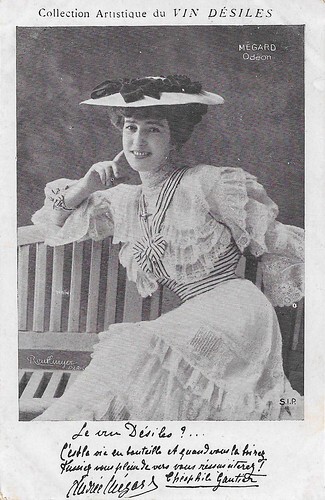
French postcard in the Collection artistique du Vin Désiles by S.I.P. Photo: Reutlinger. Caption: Le vin Desiles? C'est la vie en bouteille et quand vous le buvez, ... vous plein de vers vous réssusciterez! Theophile Gautier. (The Désiles wine? It is life in a bottle and when you drink it, ... you will be full of worms! Theophile Gautier.)
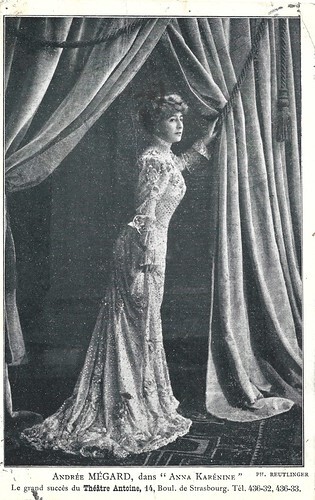
French postcard. Photo: Reutlinger. Andrée Mégard in 'Anna Karénine', performed in 1907 under the direction of Firmin Gémier at the Théâtre Antoine.
Tall, graceful, and distinguished looking
Andrée Mégard appeared in three silent films. First, as the murderous Queen Marguerite de Bourgogne opposite Henry Krauss as Buridan and René Alexandre as Gaultier in the Pathé production La tour de Nesle / The Tower of Nesle (1909) by Albert Capellani, based on the historical novel by Alexandre Dumas .
She acted as 'the wife' in La Petite amie / The Girlfriend (1917) by Marcel Simon opposite Roger Gaillard as the son, Félix Huguenet as the husband and Jane Renouardt as the 'petite amie'.
Her last part was in a second film by Simon, with Jane Renouardt, Roger Gaillard and Félix Huguenet: En quatrième vitesse / In Fourth Gear (Marcel Simon, 1919).
Mégard was considered "tall, graceful, and distinguished looking." Her hairstyles and the designs of her costumes, hats, and gowns were reported in detail in the French and international fashion press, often with photographs or drawings showing their features. She is best known for wearing the designs of the English fashion house Redfern.
In 1928, she took over the management of the Théâtre Antoine and chose René Rocher as director. Andrée Mégard died in 1952 in her birthplace, Saint-Amour in the Jura. She was 86.
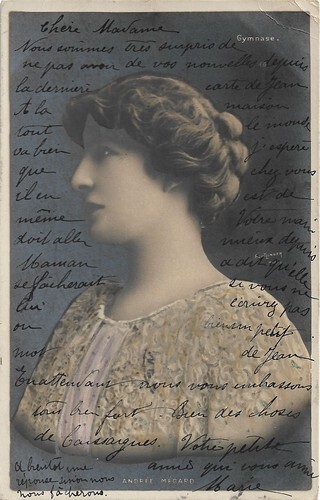
French postcard. Photo: Reutlinger, Paris. Caption: Théâtre du Gymnase, Paris. Andrée Mégard performed at the Gymnase between 1897 and 1906 in plays such as 'Les Trois filles de M. Dupont' (1897), 'Mariage bourgeois' (1898), 'Marraine' (1898), 'Le Retour de Jérusalem' (1903), 'Ces messieurs' (1905) and 'Sacha' (1906).
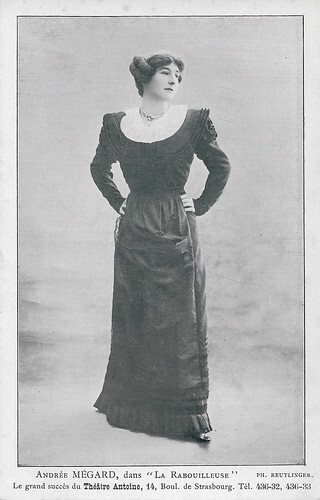
French postcard. Photo: Reutlinger. Caption: Théâtre Antoine. According to the site Les Archives du Spectacle, Andrée Mégard acted in Emile Fabre's play 'La Rabouilleuse' in 1903, but at the Théâtre national de l'Odéon. The play was based on Honoré de Balzac's 'La Comédie humaine'. Firmin Gémier had the male lead in this play as Philippe Bridau, while Mégard played Flore Brazier.
Sources: Les Archives du Spectacle (French), Wikipedia (French and English) and .

French postcard by PC. Photo: Reutlinger, Paris.

French postcard by S.I.P., 59e Série, no. 14. Photo: Reutlinger, Paris.

French postcard by S.I.P., no. 3. Photo: Reutlinger, Paris.
A reckless car driver
Andrée Mégard was born Marie Adélaïde Alexandrine Chamonal in 1869 in Saint-Amour, in the Jura Mountains. She was the daughter of Jules Chamonal and Marie Rose Florentine Mégard. Her parents were 'well-off peasants' who apprenticed her to an aunt who ran a dry good store.
Andrée ran away from the aunt at fifteen, and landed alone in Paris. She worked in the Printemps department store, gluing labels. As a young woman, Mégard worked as an artist's model in Paris, especially for the artist Auguste Toulmouche.
Rejected by the Conservatoire, she played in Brussels where she was a pupil of Marie Samary. She was on the Paris stage from 1896 to 1925, appearing in shows including Shakespearean tragedies, comedies, and plays directed by her husband, Firmin Gémier .
She starred in a stage adaptation of 'Anna Karenina' in Paris in 1907. In 1908, she knocked herself unconscious on stage during an emotional scene, and she was also a enthusiastic and reckless car driver, according to a newspaper report in 1909, after she and her sister were injured in a road accident in Brittany.
Mégard played the love interest, Roxane, in a 1913 revival of Edmond Rostand's 'Cyrano de Bergerac', while she was having an affair with Rostand himself.

French postcard in the Collection artistique du Vin Désiles by S.I.P. Photo: Reutlinger. Caption: Le vin Desiles? C'est la vie en bouteille et quand vous le buvez, ... vous plein de vers vous réssusciterez! Theophile Gautier. (The Désiles wine? It is life in a bottle and when you drink it, ... you will be full of worms! Theophile Gautier.)

French postcard. Photo: Reutlinger. Andrée Mégard in 'Anna Karénine', performed in 1907 under the direction of Firmin Gémier at the Théâtre Antoine.
Tall, graceful, and distinguished looking
Andrée Mégard appeared in three silent films. First, as the murderous Queen Marguerite de Bourgogne opposite Henry Krauss as Buridan and René Alexandre as Gaultier in the Pathé production La tour de Nesle / The Tower of Nesle (1909) by Albert Capellani, based on the historical novel by Alexandre Dumas .
She acted as 'the wife' in La Petite amie / The Girlfriend (1917) by Marcel Simon opposite Roger Gaillard as the son, Félix Huguenet as the husband and Jane Renouardt as the 'petite amie'.
Her last part was in a second film by Simon, with Jane Renouardt, Roger Gaillard and Félix Huguenet: En quatrième vitesse / In Fourth Gear (Marcel Simon, 1919).
Mégard was considered "tall, graceful, and distinguished looking." Her hairstyles and the designs of her costumes, hats, and gowns were reported in detail in the French and international fashion press, often with photographs or drawings showing their features. She is best known for wearing the designs of the English fashion house Redfern.
In 1928, she took over the management of the Théâtre Antoine and chose René Rocher as director. Andrée Mégard died in 1952 in her birthplace, Saint-Amour in the Jura. She was 86.

French postcard. Photo: Reutlinger, Paris. Caption: Théâtre du Gymnase, Paris. Andrée Mégard performed at the Gymnase between 1897 and 1906 in plays such as 'Les Trois filles de M. Dupont' (1897), 'Mariage bourgeois' (1898), 'Marraine' (1898), 'Le Retour de Jérusalem' (1903), 'Ces messieurs' (1905) and 'Sacha' (1906).

French postcard. Photo: Reutlinger. Caption: Théâtre Antoine. According to the site Les Archives du Spectacle, Andrée Mégard acted in Emile Fabre's play 'La Rabouilleuse' in 1903, but at the Théâtre national de l'Odéon. The play was based on Honoré de Balzac's 'La Comédie humaine'. Firmin Gémier had the male lead in this play as Philippe Bridau, while Mégard played Flore Brazier.
Sources: Les Archives du Spectacle (French), Wikipedia (French and English) and .
Published on September 20, 2025 22:00
September 19, 2025
Kim Novak
American film and television actress Kim Novak (1933) starred in such popular successes as Picnic (1955), The Man with the Golden Arm (1955) and Pal Joey (1957). However, she is perhaps best known today for her ‘dual role’ as both Judy Barton and Madeleine Elster in Alfred Hitchcock's classic thriller Vertigo (1958). She withdrew from acting in 1966, but returned sporadically in European films.
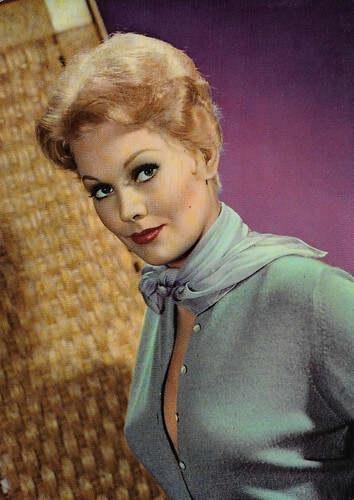
Italian postcard by Rotalcolor, no. 4.
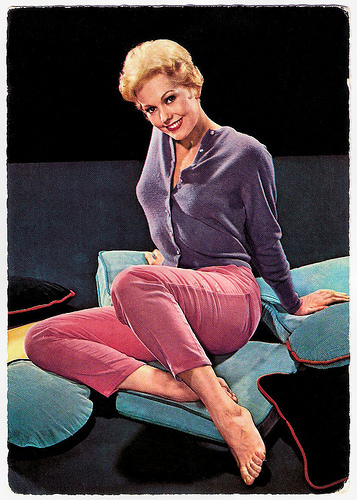
German postcard by Krüger, no. 902/29.
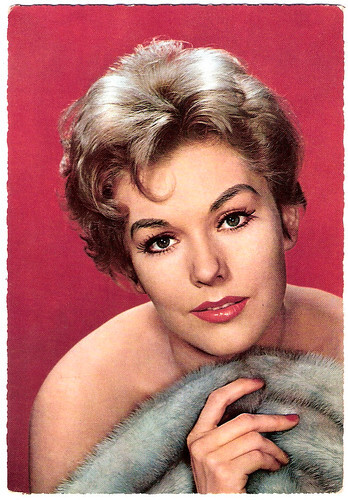
German postcard by Krüger, no. 902/26. Sent by mail in the Netherlands in 1963. Collection: Geoffrey Donaldson Institute.
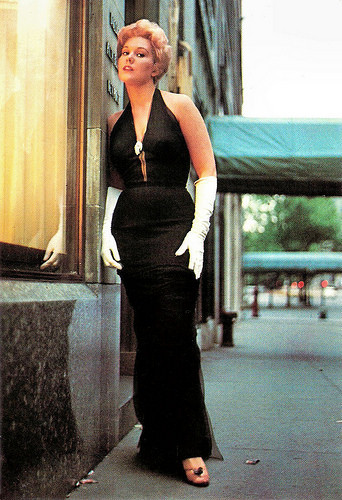
Spanish postcard by Postal Oscarcolor, no. 372.
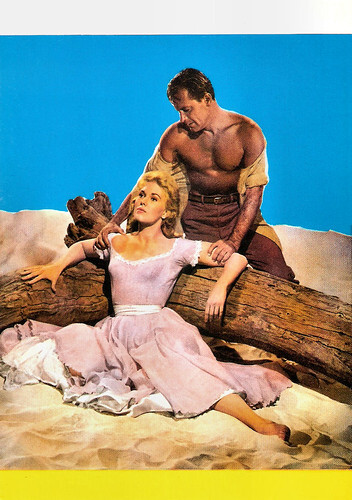
French postcard by Edition Erving, Paris, no. 757. Photo: Robert Coburn. Kim Novak and William Holden in Picnic (Joshua Logan, 1955).
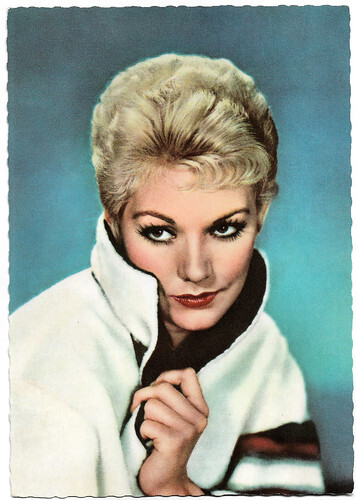
West-German postcard by Universum-Aktiengesellschaft, Berlin-Tempelhof, no. CK-279. Photo: Maudial Agency.
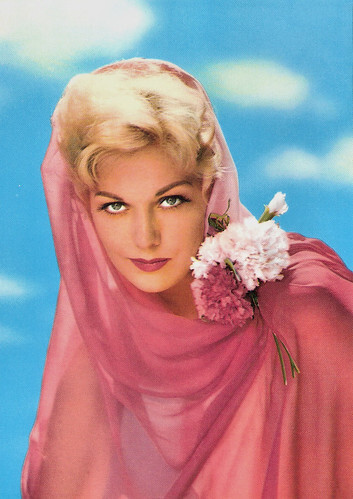
Italian postcard by Rotalcolor / Rotalfoto, Milano, no. N. 144.
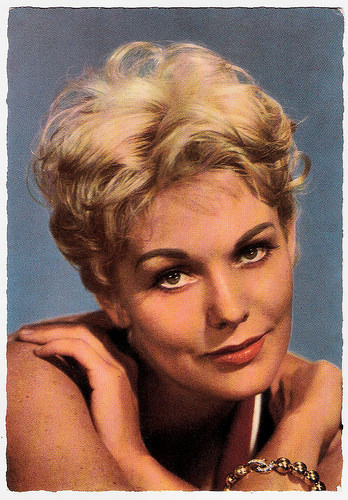
French postcard by E.D.U.G., no. 128.
Miss Deepfreeze
Kim Novak was born as Marilyn Pauline Novak, professionally in Chicago, Illinois, in 1933. She is the daughter of history teacher Joseph Novak and factory worker Blanche (née Kral) Novak. She won two scholarships to the School of the Art Institute of Chicago, and during the summer break in her last semester of junior college, Novak went on a cross-country tour modelling for a refrigerator company at trade shows. While stopping by Los Angeles, Novak was crowned Miss Deepfreeze by the refrigerator company.
While there, she and two other models stood in line to be extras in The French Line (Lloyd Bacon, 1954), a film starring Jane Russell . It was here that she was discovered by an agent, who signed her to a long-term contract with Columbia Pictures. Columbia intended for Novak to be their successor to Rita Hayworth , their biggest star of the 1940s, whose career had declined. The studio also hoped that Novak would bring them the same success 20th Century-Fox was having with Marilyn Monroe .
Her first role for the studio was in the film noir Pushover (Richard Quine, 1954). She then co-starred in the romantic comedy Phffft! (Mark Robson, 1954) as Janis, a Monroe-type character who finds Jack Lemmon 's character, Robert Tracey, "real cute". Both films were reasonably successful at the box office, and Novak received favourable reviews for her performances.
The film version of Picnic (Joshua Logan, 1955), co-starring William Holden , was a resounding critical and box office triumph. Novak won a Golden Globe Award for Most Promising Newcomer. She was also nominated for the BAFTA Film Award for Best Foreign Actress, but did not win. Director Otto Preminger then cast her in The Man with the Golden Arm (1955), in which she played Frank Sinatra 's sultry ex-girlfriend. The film was a box office triumph.
After appearing in a series of successful movies, Novak became one of the biggest box office draws. Columbia placed her in a film adaptation of Pal Joey (George Sidney, 1957). She played Linda English, a naive showgirl, opposite Frank Sinatra and Rita Hayworth . The movie was a box office hit and has been considered one of Novak's better performances.
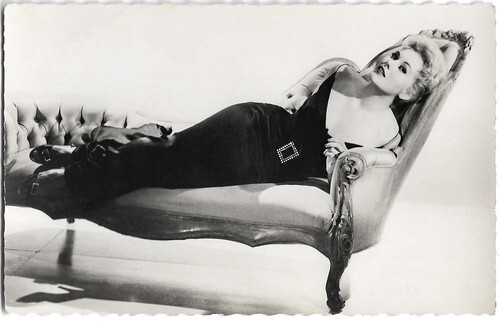
French postcard by Editions P.I., Paris, offered by Les Carbones Korès "Carboplane", no. 834. Photo: Browning Studio / H.P.S.
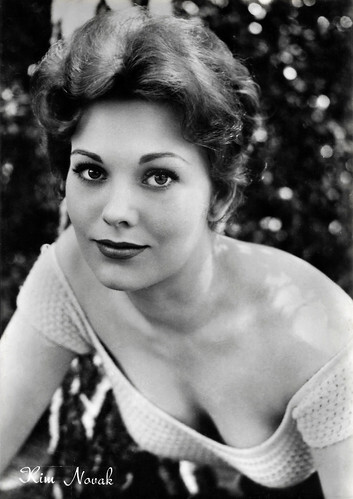
Italian postcard by Rotalfoto, Milano, no. 502.
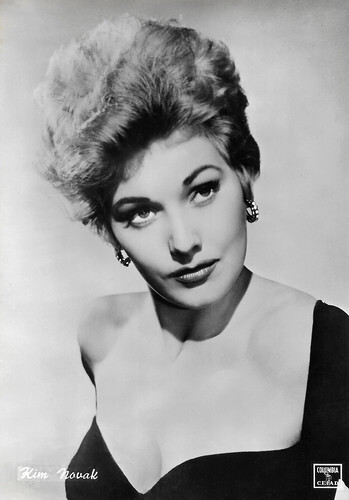
Italian postcard by Bromofoto, Milano, no. 962. Photo: Columbia CEIAD. Kim Novak in Phffft (Mark Robson, 1954).
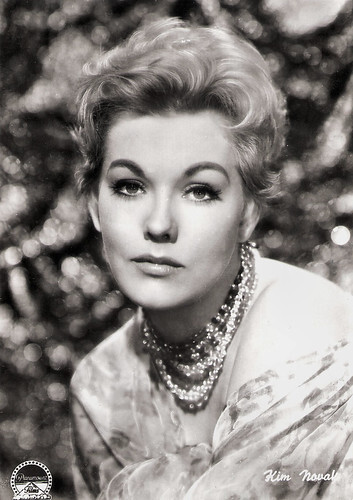
Italian postcard by Bromofoto, Milano, no. 1503. Photo: Paramount Films.
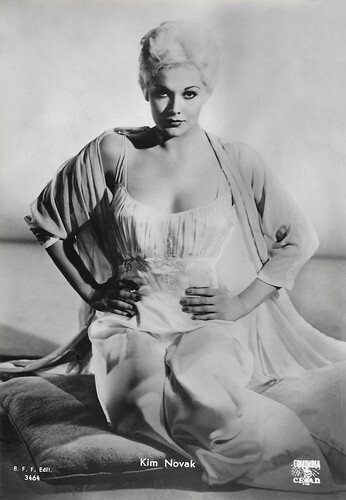
Italian postcard by B.F.F. Edit, no. 3464. Photo: Columbia / CEIAD.
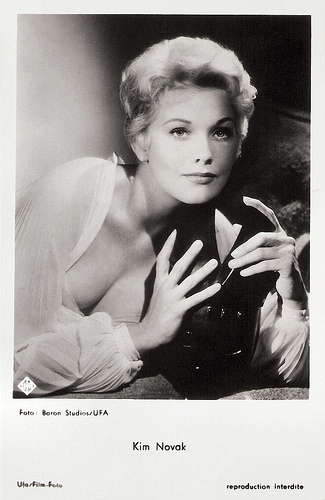
French postcard by Editions P.I., Paris, no. FK 3287. Photo: Baron Studios / Ufa.
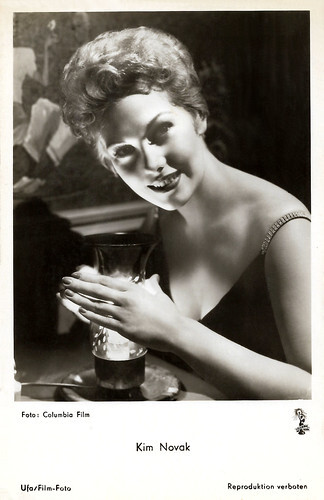
West German postcard by Ufa/Film-Foto, Berlin-Tempelhof, no. FK 3579. Photo: Columbia Film.
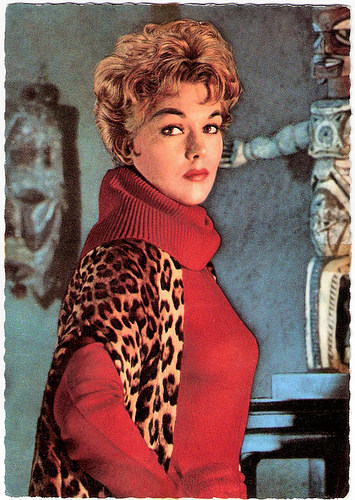
German postcard by Ufa, Berlin-Tempelhof, no. CK 280. Photo: Terb Agency.
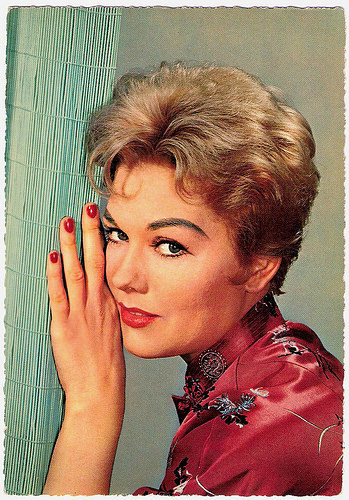
German postcard by Krüger, no. 902/27.
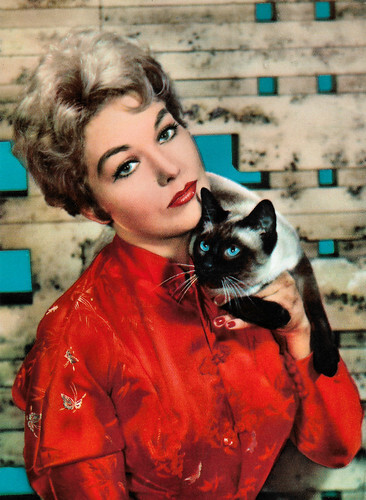
French postcard by Editions P.I., Paris, offered by Les Carbones Korès 'Carboplane', no. 278. Photo: Mondial Agency.
Vertigo
Kim Novak is best known today for the classic thriller Vertigo (Alfred Hitchcock, 1958), opposite James Stewart . During the production, Novak was striking for more money from Columbia, and refused to show up for work on the Vertigo set to protest her salary of $1,250 a week. Novak hired new agents to represent her and demanded an adjustment in her contract. Harry Cohn of Columbia suspended her, but after a few weeks of negotiations, he relented and offered her a new contract worthy of a major star. Vertigo was poorly received at the time of its release in 1958 and failed at the box office, but has since been re-evaluated and is widely considered one of the director's best works.
Sandra Brennan at AllMovie: "In 1958, Novak appeared in her most famous role, that of enigmatic Madeleine in Alfred Hitchcock 's masterpiece Vertigo. It was a difficult role, but one she rose to admirably. She did have one conflict with Hitchcock on the set concerning the stiff grey suit and black shoes she would be required to wear for most of the picture. When she saw costume designer Edith Head's original plans for the suit, Novak, fearing the suit would be distracting and uncomfortable and believing that grey is seldom a blonde's best colour, voiced her concerns directly to Hitchcock, who listened patiently and then insisted she wear the prescribed garb. Novak obeyed and, to her surprise, discovered that the starchy outfit enhanced rather than hindered her ability to play Madeleine."
In 1958, Novak again worked with Stewart in Richard Quine's Bell, Book and Candle, a comedy tale of modern-day witchcraft, which proved to be a box office success. The following year, she starred opposite Fredric March in the acclaimed drama Middle of the Night (Delbert Mann, 1959), and opposite Kirk Douglas in Strangers When We Meet (Richard Quine, 1960).
Although still young, her career declined in the early 1960s, and after several years in a series of lacklustre films, she withdrew from acting in 1966. She has only sporadically returned since. She returned to the screen in the West-German film Schöner Gigolo, armer Gigolo / Just a Gigolo (David Hemmings, 1978), starring David Bowie , and the British mystery The Mirror Crack'd (Guy Hamilton, 1980), based on the story by Agatha Christie. She also had a regular role on the prime time TV series Falcon Crest (1986–1987).
After a disappointing experience during the filming of the mystery Liebestraum (Mike Figgis, 1991), Kim Novak permanently retired from acting, citing that she had no desire to return. In 2013, she attended the 2013 Cannes Film Festival, where she introduced a new restored version of Vertigo. Audiences gave Novak a standing ovation. Denny Jackson at IMDb: "Today she lives in Eagle Point, Oregon, with her husband Bob, on a ranch where they raise horses and llamas. Kim is also an accomplished artist and has exhibited her paintings in galleries around the country."
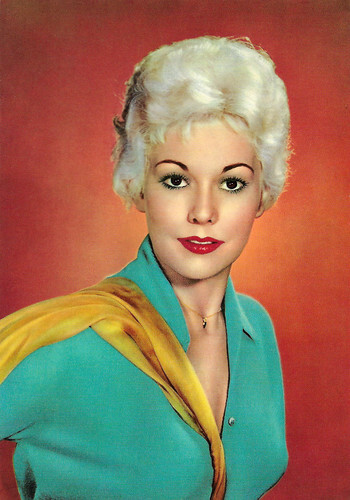
Italian postcard by Rotalcolor / Rotalfoto, Milano, no. N. 50.
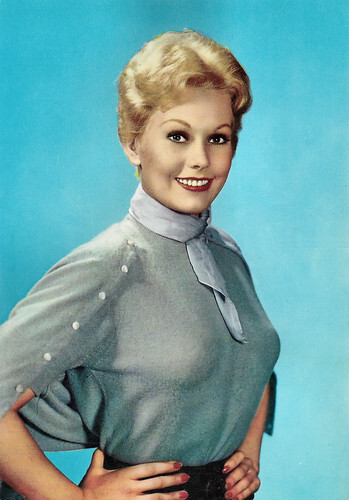
Italian postcard by Rotalcolor / Rotalfoto, Milano, no. N. 55.
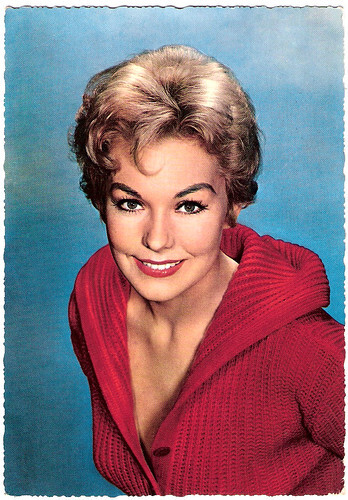
German postcard by Krüger. Sent by mail in the Netherlands in 1961. Collection: Geoffrey Donaldson Institute.
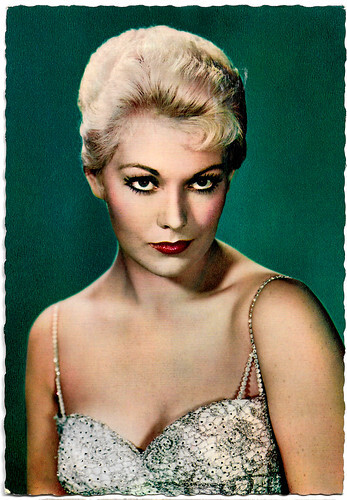
French postcard by EDUG, no. 118.
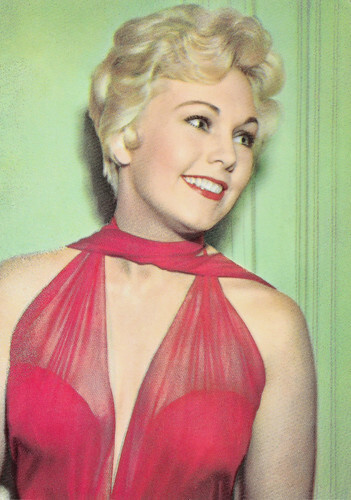
French postcard by Edition P.I., Paris, licence holder for France for UFA postcards, no. CK 99. Photo: UFA.
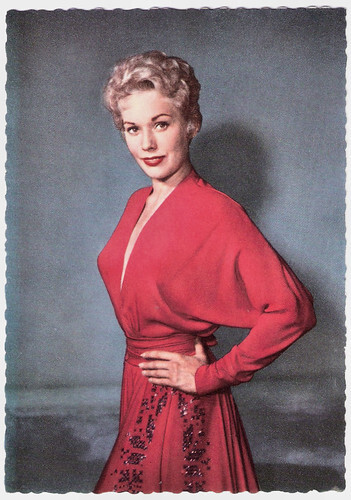
West-German postcard by Universum-Aktiengesellschaft, Berlin-Tempelhof, no. CK-21. Photo: Baron Studios / UFA.
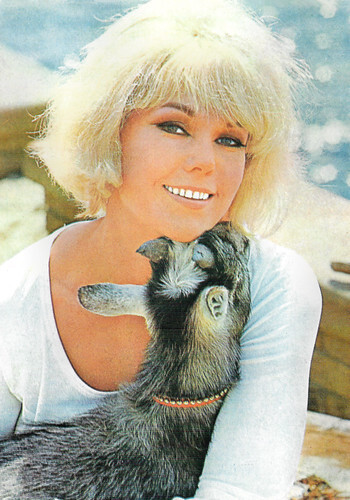
Romanian postcard by Casa Filmului Acin.
Trailer Picnic (Joshua Logan, 1955). Sources: Craig Steves (YouTube).
Trailer Vertigo (Alfred Hitchcock, 1958). Sources: Universal Pictues UK (YouTube).
Trailer The Mirror Crack'd (Guy Hamilton, 1980). Source: Mr 80s Movies (YouTube).
Sources: (IMDb), Sandra Brennan (AllMovie - Page now defunct), Wikipedia and .

Italian postcard by Rotalcolor, no. 4.

German postcard by Krüger, no. 902/29.

German postcard by Krüger, no. 902/26. Sent by mail in the Netherlands in 1963. Collection: Geoffrey Donaldson Institute.

Spanish postcard by Postal Oscarcolor, no. 372.

French postcard by Edition Erving, Paris, no. 757. Photo: Robert Coburn. Kim Novak and William Holden in Picnic (Joshua Logan, 1955).

West-German postcard by Universum-Aktiengesellschaft, Berlin-Tempelhof, no. CK-279. Photo: Maudial Agency.

Italian postcard by Rotalcolor / Rotalfoto, Milano, no. N. 144.

French postcard by E.D.U.G., no. 128.
Miss Deepfreeze
Kim Novak was born as Marilyn Pauline Novak, professionally in Chicago, Illinois, in 1933. She is the daughter of history teacher Joseph Novak and factory worker Blanche (née Kral) Novak. She won two scholarships to the School of the Art Institute of Chicago, and during the summer break in her last semester of junior college, Novak went on a cross-country tour modelling for a refrigerator company at trade shows. While stopping by Los Angeles, Novak was crowned Miss Deepfreeze by the refrigerator company.
While there, she and two other models stood in line to be extras in The French Line (Lloyd Bacon, 1954), a film starring Jane Russell . It was here that she was discovered by an agent, who signed her to a long-term contract with Columbia Pictures. Columbia intended for Novak to be their successor to Rita Hayworth , their biggest star of the 1940s, whose career had declined. The studio also hoped that Novak would bring them the same success 20th Century-Fox was having with Marilyn Monroe .
Her first role for the studio was in the film noir Pushover (Richard Quine, 1954). She then co-starred in the romantic comedy Phffft! (Mark Robson, 1954) as Janis, a Monroe-type character who finds Jack Lemmon 's character, Robert Tracey, "real cute". Both films were reasonably successful at the box office, and Novak received favourable reviews for her performances.
The film version of Picnic (Joshua Logan, 1955), co-starring William Holden , was a resounding critical and box office triumph. Novak won a Golden Globe Award for Most Promising Newcomer. She was also nominated for the BAFTA Film Award for Best Foreign Actress, but did not win. Director Otto Preminger then cast her in The Man with the Golden Arm (1955), in which she played Frank Sinatra 's sultry ex-girlfriend. The film was a box office triumph.
After appearing in a series of successful movies, Novak became one of the biggest box office draws. Columbia placed her in a film adaptation of Pal Joey (George Sidney, 1957). She played Linda English, a naive showgirl, opposite Frank Sinatra and Rita Hayworth . The movie was a box office hit and has been considered one of Novak's better performances.

French postcard by Editions P.I., Paris, offered by Les Carbones Korès "Carboplane", no. 834. Photo: Browning Studio / H.P.S.

Italian postcard by Rotalfoto, Milano, no. 502.

Italian postcard by Bromofoto, Milano, no. 962. Photo: Columbia CEIAD. Kim Novak in Phffft (Mark Robson, 1954).

Italian postcard by Bromofoto, Milano, no. 1503. Photo: Paramount Films.

Italian postcard by B.F.F. Edit, no. 3464. Photo: Columbia / CEIAD.

French postcard by Editions P.I., Paris, no. FK 3287. Photo: Baron Studios / Ufa.

West German postcard by Ufa/Film-Foto, Berlin-Tempelhof, no. FK 3579. Photo: Columbia Film.

German postcard by Ufa, Berlin-Tempelhof, no. CK 280. Photo: Terb Agency.

German postcard by Krüger, no. 902/27.

French postcard by Editions P.I., Paris, offered by Les Carbones Korès 'Carboplane', no. 278. Photo: Mondial Agency.
Vertigo
Kim Novak is best known today for the classic thriller Vertigo (Alfred Hitchcock, 1958), opposite James Stewart . During the production, Novak was striking for more money from Columbia, and refused to show up for work on the Vertigo set to protest her salary of $1,250 a week. Novak hired new agents to represent her and demanded an adjustment in her contract. Harry Cohn of Columbia suspended her, but after a few weeks of negotiations, he relented and offered her a new contract worthy of a major star. Vertigo was poorly received at the time of its release in 1958 and failed at the box office, but has since been re-evaluated and is widely considered one of the director's best works.
Sandra Brennan at AllMovie: "In 1958, Novak appeared in her most famous role, that of enigmatic Madeleine in Alfred Hitchcock 's masterpiece Vertigo. It was a difficult role, but one she rose to admirably. She did have one conflict with Hitchcock on the set concerning the stiff grey suit and black shoes she would be required to wear for most of the picture. When she saw costume designer Edith Head's original plans for the suit, Novak, fearing the suit would be distracting and uncomfortable and believing that grey is seldom a blonde's best colour, voiced her concerns directly to Hitchcock, who listened patiently and then insisted she wear the prescribed garb. Novak obeyed and, to her surprise, discovered that the starchy outfit enhanced rather than hindered her ability to play Madeleine."
In 1958, Novak again worked with Stewart in Richard Quine's Bell, Book and Candle, a comedy tale of modern-day witchcraft, which proved to be a box office success. The following year, she starred opposite Fredric March in the acclaimed drama Middle of the Night (Delbert Mann, 1959), and opposite Kirk Douglas in Strangers When We Meet (Richard Quine, 1960).
Although still young, her career declined in the early 1960s, and after several years in a series of lacklustre films, she withdrew from acting in 1966. She has only sporadically returned since. She returned to the screen in the West-German film Schöner Gigolo, armer Gigolo / Just a Gigolo (David Hemmings, 1978), starring David Bowie , and the British mystery The Mirror Crack'd (Guy Hamilton, 1980), based on the story by Agatha Christie. She also had a regular role on the prime time TV series Falcon Crest (1986–1987).
After a disappointing experience during the filming of the mystery Liebestraum (Mike Figgis, 1991), Kim Novak permanently retired from acting, citing that she had no desire to return. In 2013, she attended the 2013 Cannes Film Festival, where she introduced a new restored version of Vertigo. Audiences gave Novak a standing ovation. Denny Jackson at IMDb: "Today she lives in Eagle Point, Oregon, with her husband Bob, on a ranch where they raise horses and llamas. Kim is also an accomplished artist and has exhibited her paintings in galleries around the country."

Italian postcard by Rotalcolor / Rotalfoto, Milano, no. N. 50.

Italian postcard by Rotalcolor / Rotalfoto, Milano, no. N. 55.

German postcard by Krüger. Sent by mail in the Netherlands in 1961. Collection: Geoffrey Donaldson Institute.

French postcard by EDUG, no. 118.

French postcard by Edition P.I., Paris, licence holder for France for UFA postcards, no. CK 99. Photo: UFA.

West-German postcard by Universum-Aktiengesellschaft, Berlin-Tempelhof, no. CK-21. Photo: Baron Studios / UFA.

Romanian postcard by Casa Filmului Acin.
Trailer Picnic (Joshua Logan, 1955). Sources: Craig Steves (YouTube).
Trailer Vertigo (Alfred Hitchcock, 1958). Sources: Universal Pictues UK (YouTube).
Trailer The Mirror Crack'd (Guy Hamilton, 1980). Source: Mr 80s Movies (YouTube).
Sources: (IMDb), Sandra Brennan (AllMovie - Page now defunct), Wikipedia and .
Published on September 19, 2025 22:00
September 18, 2025
Peggy Lee
Sultry American jazz and pop singer Peggy Lee (1920-2002) recorded such classics as 'Fever', 'Manana', 'Big Spender' and 'Is That All There Is?'. In Hollywood, she made herself a name with parts in The Jazz Singer (1952) and Pete Kelly's Blues (1955). And she composed songs for Walt Disney's Lady and the Tramp (1955), for which she also voiced the unforgettable Peg, a broken-down old showgirl of a dog, whose provocative walk was based on the stage-prowl of Peggy Lee.
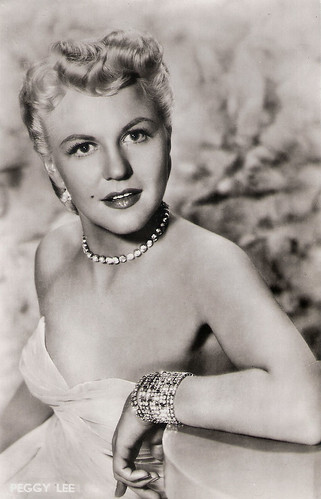
Vintage postcard, no. 330. Photo: Warner Bros.
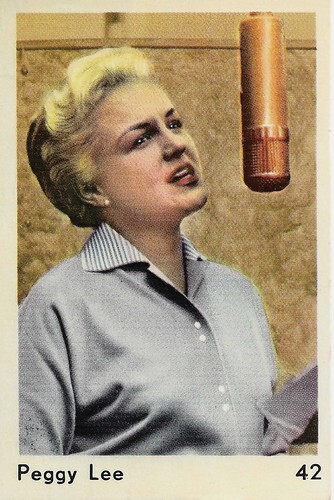
Dutch collector card, no. 42.
An elegant, intimate performer with a minimalist style
Peggy Lee was born Norma Dolores Egstrom in Jamestown, North Dakota, in 1920. She was the seventh of the eight children of Selma Amelia (née Anderson) Egstrom and Marvin Olof Egstrom, a station agent for the Midland Continental Railroad. At age four, her mother died. Peggy's father remarried Minnie Schaumberg Wiese, but he later left home, leaving Peggy's care entrusted to a stepmother who physically abused her.
Peggy used singing as an escape. She later memorialised this in the calypso number 'One Beating a Day', one of 22 songs she co-wrote for the autobiographical musical 'Peg' (1983), in which she made her Broadway debut at the age of 62. Young Peggy worked as a milkmaid, later turning to singing for money in her teens. While singing on a local radio station in Fargo, the program director there suggested she change her name to Peggy Lee. She developed her trademark sultry purr, having decided to compete with the noisy crowd with subtlety rather than volume.
Peggy's big break came in 1941 when Benny Goodman hired her to sing with his band after hearing her perform in a Chicago nightclub. She replaced vocalist Helen Forrest. In 1942, Lee had her first No. 1 hit, 'Somebody Else Is Taking My Place', followed in 1943 by 'Why Don't You Do Right?', which sold more than one million copies and made her famous. She sang with Goodman's orchestra in two films, Stage Door Canteen (Frank Borzage, 1943) and The Powers Girl (Norman Z. McLeod, 1943). In March 1943, Lee married Dave Barbour, a guitarist in Goodman's band. She had to leave the band and became a housewife.
In 1947, she drifted back to songwriting and occasional recording sessions for Capitol Records. She had hits with 'Golden Earrings', 'It's a Good Day', and the no. 1 hit 'Manana', which she also wrote. Later, such classics followed as 'Fever' in 1958, 'Lover', 'Big Spender' and 'Is That All There Is?' - the latter winning her a Grammy Award in 1969. Peggy's vocal style provided a distinctive imprint to countless swing tunes, ballads and big band numbers. She was considered the type of performer equally capable of interpreting a song as uniquely as Billie Holiday, Ella Fitzgerald and Bessie Smith.
Peggy Lee also became known as a film actress. Gary Brumburgh at IMDb : "An elegant, intimate performer with a minimalist style, her recording and supper club fame eventually led to movie offers". She appeared opposite Danny Thomas in The Jazz Singer (Michael Curtiz, 1952), a remake of the Al Jolson film, The Jazz Singer (Alan Crosland, 1927). She made her mark in Hollywood, winning an Academy Award nomination for her role as a singer who battles the bottle in the jazz saga, Pete Kelly's Blues (Jack Webb, 1955).
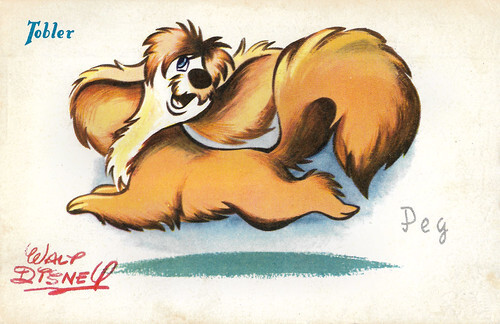
French postcard by Tobler. Image: The Walt Disney Company.

Belgian postcard by Editions Corna. Image: Walt Disney Productions. Peg in Lady and the Tramp (Clyde Geronimi, Wilfred Jackson, Hamilton Luske, 1955).
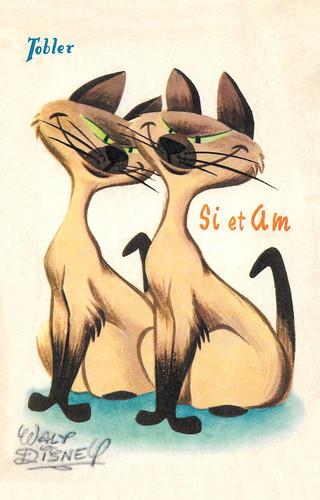
French postcard by Imp. Georges Lang, Paris, offered by Chocolats Tobler. Image: Walt Disney.
The namesake of the Margarita cocktail
Peggy Lee composed songs for the Walt Disney animated classic Lady and the Tramp (Clyde Geronimi, Wilfred Jackson, Hamilton Luske, 1955). She also voiced four different characters in the film: Darling, both the Siamese cats, and Peg, a broken-down old showgirl of a dog, whose provocative walk was based on the stage-prowl of Peggy Lee. In 1991, 36 years later, she won $2.3 million against Disney to recoup royalties from videocassette sales of Lady and the Tramp. The case hinged on a clause in her pre-video-era contract barring the sale of 'transcriptions' of the film without her approval.
But music was her first love, and she continued on the road, crossing over occasionally from the easy jazz to the pop field. At the age of 62, she made her Broadway debut in the autobiographical musical 'Peg' (1983). It was one of the few projects in her life that was not a success. Lee was nominated for twelve Grammy Awards, winning Best Contemporary Vocal Performance for her 1969 hit 'Is That All There Is?' Her 1989 album, 'Peggy Sings the Blues', was a Grammy Award nominee.
Peggy was a prolific songwriter and arranger, and her 1990 album 'The Peggy Lee Songbook' contained four songs she wrote with guitarist John Chiodini. Peggy also wrote for jazz greats Duke Ellington, who called her "The Queen", Johnny Mercer, and composer Quincy Jones. Also in 1990, Peggy was awarded the coveted Pied Piper Award presented by the American Society of Composers, Authors and Publishers (ASCAP). In 1995, she was given the Grammy Lifetime Achievement Award.
Peggy's private life was racked by physical ailments, a near-fatal fall in 1976, diabetes, and she was semi-confined to a wheelchair since the 1980s, but she valiantly continued performing. She was married four times, to guitarist Dave Barbour, actor Brad Dexter, actor Dewey Martin, and actor Jack del Rio, all marriages ending in divorce. She and David Barbour had a daughter, Nicki Lee Foster (1943), her only child. Peggy and Dave were on the verge of a reconciliation in 1965, but he died of a heart attack before the couple got back together. At the time, Dave had divorced her because he felt his drinking was not good for his daughter. They engaged again four days before he died. Dave claimed he had been sober for 13 years by then and was ready to remarry Peggy.
In 1998, Peggy Lee had a stroke, and in 2002, she died of a heart attack in Bel Air, Los Angeles. Just a week before her death, she earned a preliminary approval of $4.75 million in a class lawsuit (she was the lead plaintiff of a group of Decca recording artists) for royalties against Universal Music Group. Gary Brumburgh: "Miss Peggy Lee", as she was always introduced, was a class act all the way and, in talent, is often deemed a smooth, self-contained combination of Ella Fitzgerald and Billie Holiday." And according to IMDb , Lee is the namesake of the Margarita cocktail. In 1948. Santos Cruz, a bartender at the famed Texas nightclub the Balinese Room, mixed up a new drink especially for her. He named it for the Spanish version of 'Margaret', which is the formal version of 'Peggy'.
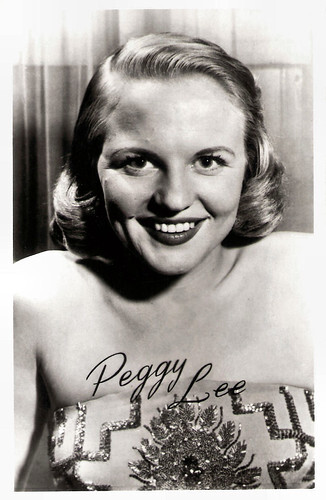
Dutch postcard by Takken / 't Sticht, no A.X. 934. Photo: Fotoatchief Maandblad PHILHARMONIC.
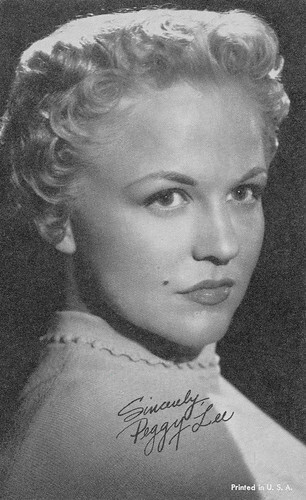
American Arcade card.
Sources: (IMDb), (IMDb), Wikipedia and .

Vintage postcard, no. 330. Photo: Warner Bros.

Dutch collector card, no. 42.
An elegant, intimate performer with a minimalist style
Peggy Lee was born Norma Dolores Egstrom in Jamestown, North Dakota, in 1920. She was the seventh of the eight children of Selma Amelia (née Anderson) Egstrom and Marvin Olof Egstrom, a station agent for the Midland Continental Railroad. At age four, her mother died. Peggy's father remarried Minnie Schaumberg Wiese, but he later left home, leaving Peggy's care entrusted to a stepmother who physically abused her.
Peggy used singing as an escape. She later memorialised this in the calypso number 'One Beating a Day', one of 22 songs she co-wrote for the autobiographical musical 'Peg' (1983), in which she made her Broadway debut at the age of 62. Young Peggy worked as a milkmaid, later turning to singing for money in her teens. While singing on a local radio station in Fargo, the program director there suggested she change her name to Peggy Lee. She developed her trademark sultry purr, having decided to compete with the noisy crowd with subtlety rather than volume.
Peggy's big break came in 1941 when Benny Goodman hired her to sing with his band after hearing her perform in a Chicago nightclub. She replaced vocalist Helen Forrest. In 1942, Lee had her first No. 1 hit, 'Somebody Else Is Taking My Place', followed in 1943 by 'Why Don't You Do Right?', which sold more than one million copies and made her famous. She sang with Goodman's orchestra in two films, Stage Door Canteen (Frank Borzage, 1943) and The Powers Girl (Norman Z. McLeod, 1943). In March 1943, Lee married Dave Barbour, a guitarist in Goodman's band. She had to leave the band and became a housewife.
In 1947, she drifted back to songwriting and occasional recording sessions for Capitol Records. She had hits with 'Golden Earrings', 'It's a Good Day', and the no. 1 hit 'Manana', which she also wrote. Later, such classics followed as 'Fever' in 1958, 'Lover', 'Big Spender' and 'Is That All There Is?' - the latter winning her a Grammy Award in 1969. Peggy's vocal style provided a distinctive imprint to countless swing tunes, ballads and big band numbers. She was considered the type of performer equally capable of interpreting a song as uniquely as Billie Holiday, Ella Fitzgerald and Bessie Smith.
Peggy Lee also became known as a film actress. Gary Brumburgh at IMDb : "An elegant, intimate performer with a minimalist style, her recording and supper club fame eventually led to movie offers". She appeared opposite Danny Thomas in The Jazz Singer (Michael Curtiz, 1952), a remake of the Al Jolson film, The Jazz Singer (Alan Crosland, 1927). She made her mark in Hollywood, winning an Academy Award nomination for her role as a singer who battles the bottle in the jazz saga, Pete Kelly's Blues (Jack Webb, 1955).

French postcard by Tobler. Image: The Walt Disney Company.

Belgian postcard by Editions Corna. Image: Walt Disney Productions. Peg in Lady and the Tramp (Clyde Geronimi, Wilfred Jackson, Hamilton Luske, 1955).

French postcard by Imp. Georges Lang, Paris, offered by Chocolats Tobler. Image: Walt Disney.
The namesake of the Margarita cocktail
Peggy Lee composed songs for the Walt Disney animated classic Lady and the Tramp (Clyde Geronimi, Wilfred Jackson, Hamilton Luske, 1955). She also voiced four different characters in the film: Darling, both the Siamese cats, and Peg, a broken-down old showgirl of a dog, whose provocative walk was based on the stage-prowl of Peggy Lee. In 1991, 36 years later, she won $2.3 million against Disney to recoup royalties from videocassette sales of Lady and the Tramp. The case hinged on a clause in her pre-video-era contract barring the sale of 'transcriptions' of the film without her approval.
But music was her first love, and she continued on the road, crossing over occasionally from the easy jazz to the pop field. At the age of 62, she made her Broadway debut in the autobiographical musical 'Peg' (1983). It was one of the few projects in her life that was not a success. Lee was nominated for twelve Grammy Awards, winning Best Contemporary Vocal Performance for her 1969 hit 'Is That All There Is?' Her 1989 album, 'Peggy Sings the Blues', was a Grammy Award nominee.
Peggy was a prolific songwriter and arranger, and her 1990 album 'The Peggy Lee Songbook' contained four songs she wrote with guitarist John Chiodini. Peggy also wrote for jazz greats Duke Ellington, who called her "The Queen", Johnny Mercer, and composer Quincy Jones. Also in 1990, Peggy was awarded the coveted Pied Piper Award presented by the American Society of Composers, Authors and Publishers (ASCAP). In 1995, she was given the Grammy Lifetime Achievement Award.
Peggy's private life was racked by physical ailments, a near-fatal fall in 1976, diabetes, and she was semi-confined to a wheelchair since the 1980s, but she valiantly continued performing. She was married four times, to guitarist Dave Barbour, actor Brad Dexter, actor Dewey Martin, and actor Jack del Rio, all marriages ending in divorce. She and David Barbour had a daughter, Nicki Lee Foster (1943), her only child. Peggy and Dave were on the verge of a reconciliation in 1965, but he died of a heart attack before the couple got back together. At the time, Dave had divorced her because he felt his drinking was not good for his daughter. They engaged again four days before he died. Dave claimed he had been sober for 13 years by then and was ready to remarry Peggy.
In 1998, Peggy Lee had a stroke, and in 2002, she died of a heart attack in Bel Air, Los Angeles. Just a week before her death, she earned a preliminary approval of $4.75 million in a class lawsuit (she was the lead plaintiff of a group of Decca recording artists) for royalties against Universal Music Group. Gary Brumburgh: "Miss Peggy Lee", as she was always introduced, was a class act all the way and, in talent, is often deemed a smooth, self-contained combination of Ella Fitzgerald and Billie Holiday." And according to IMDb , Lee is the namesake of the Margarita cocktail. In 1948. Santos Cruz, a bartender at the famed Texas nightclub the Balinese Room, mixed up a new drink especially for her. He named it for the Spanish version of 'Margaret', which is the formal version of 'Peggy'.

Dutch postcard by Takken / 't Sticht, no A.X. 934. Photo: Fotoatchief Maandblad PHILHARMONIC.

American Arcade card.
Sources: (IMDb), (IMDb), Wikipedia and .
Published on September 18, 2025 22:00
September 16, 2025
Nat King Cole
American singer and pianist Nat 'King' Cole (1919-1965) with his typical raspy voice received 28 golden records for such classic hits as 'Mona Lisa' (1949), 'Too Young' (the #1 song in 1951), his signature tune 'Unforgettable' (1951) and 'Ramblin' Rose' (1962). He also appeared in several films, including St. Louis Blues (1958) and Cat Ballou (1965).
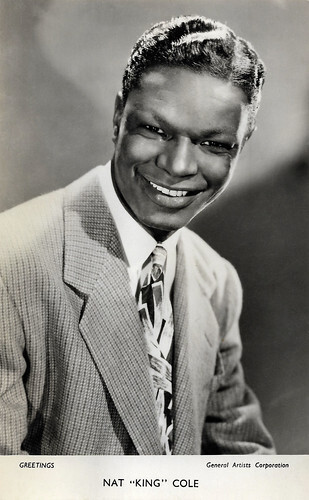
British postcard in the Greetings series. Photo: General Artists Cooperation.
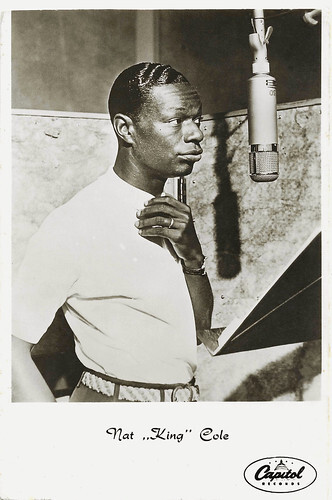
Dutch postcard by Editions Altona / Gebr. Spanjersberg N.V., Rotterdam, no. 5152. Photo: Capitol Records.
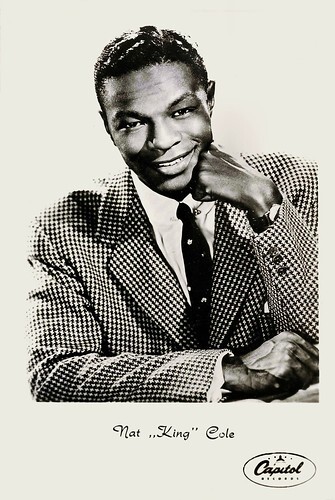
Dutch postcard by Editions Altona, no. 5172. Photo: Capitol Records.
Too black to marry
Nat King Cole was born Nathaniel Adams Coles in Montgomery, Alabama, in 1919. When he was four or five (the sources differ), his family moved to Chicago. There, his father, Edward James Coles, was a minister at the True Light Baptist Church and later the Pastor of the First Baptist Church.
Nat received music lessons from his mother. He learned jazz and gospel music, but also Western classical music. At 12, he was playing the church organ, and at 14, he formed a 14-piece band called the Royal Dukes. His three brothers, Ike Cole, Eddie Cole, and Frankie Cole, also played the piano and later sang professionally.
In 1939, Nat formed the King Cole Trio after his publicist put a silver tin-foiled crown on his head and proclaimed him King. He became known as a leading jazz pianist and soon became noted for his soft, baritone voice. His recordings of 'Straighten Up And Fly Right' (1943), which sold over 500,000 copies, and '(Get Your Kicks on) Route 66' (1946) would become classics and influenced several Rock and roll singers of the 1950s.
Nat King Cole met his second wife, Maria (a big-band singer), at the Zanzibar nightclub in Los Angeles through the Eddie 'Rochester' Anderson show. Her parents protested her decision to marry Cole, claiming he was "too black". However, they were married in 1948 and had five children, including singer Natalie Cole.
When he and his family moved to the upscale Hancock Park area of Los Angeles in the late 1940s, they were met with considerable opposition from the residents of the previously all-white neighbourhood. When the neighbours finally realised - after several attempts, including legal action - that the Coles were not going to be intimidated, they accepted defeat and, ultimately, the Coles as well.

Dutch postcard by Uitg. Takken, Utrecht, no. AX 2002.
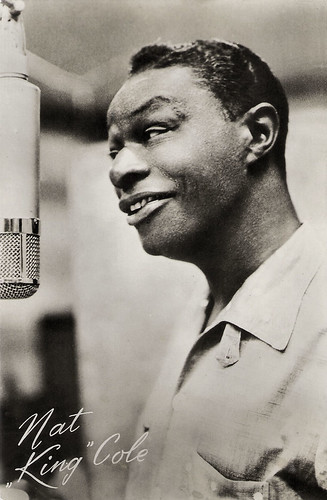
Dutch postcard by Uitg. Takken, Utrecht, no. 3559.
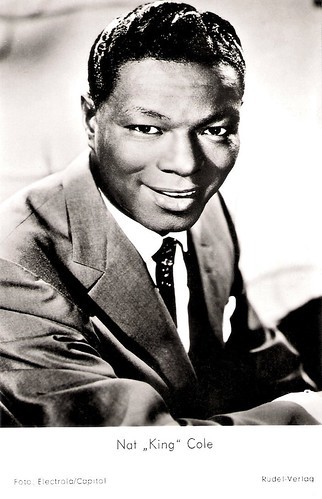
German postcard by Rüdel-Verlag, Hamburg-Bergedorf, no. 3119. Photo: Electrola / Capitol.
Unforgettable
In the mid-1950s, Nat King Cole had several mainstream Rock and Roll hits including 'Send For Me', 'With You On My Mind', 'When Rock and Roll Comes To Trinidad', and 'Looking Back'. He often toured Europe and made a command performance before Queen Elizabeth II.
He was the first African-American to have his own TV show - the highly-rated The Nat King Cole Show (1954). Cole cancelled the show because no company was willing to sponsor the show. In 1956, during a concert in Birmingham, Alabama, Cole was attacked by six white men from a white supremacist group called the White Citizens Council. He sustained minor injuries to his back.
Nat King Cole appeared in several films. Uncredited, he made his film debut in Citizen Kane (Orson Welles, 1941) as a pianist in El Rancho. He performed songs in musicals like Here Comes Elmer (Joseph Santley, 1943), Pin-Up Girl (H. Bruce Humberstone, 1944) starring Betty Grable , and Breakfast in Hollywood (Harold D. Schuster, 1946).
During the 1950s, both the films and his parts became bigger, such as in Fritz Lang 's Film Noir The Blue Gardenia (1953), Kiss Me Deadly (Robert Aldrich, 1955), and the war drama China Gate (Samuel Fuller, 1957) with Angie Dickinson . He played the lead role in St. Louis Blues (Allen Reisner, 1958), a biopic of turn-of-the-century blues composer W. C. Handy. Cole also worked in the European cinema and appeared in the Schlager film Schlager-Raketen / Schlager Missiles (Erik Ode, 1960). His last film was the comic Western Cat Ballou (Elliot Silverstein, 1965), starring Lee Marvin and Jane Fonda .
Nat King Cole was also a composer, and his song 'Straighten Up and Fly Right' was sold for $50,000. A heavy smoker, he died of lung cancer in 1965 in Santa Monica. He was only 45. In 1991, his song 'Unforgettable' was made famous again by Cole's daughter Natalie when modern recording technology was used to reunite father and daughter in a duet. The duet version rose to the top of the pop charts, almost forty years after its original popularity.
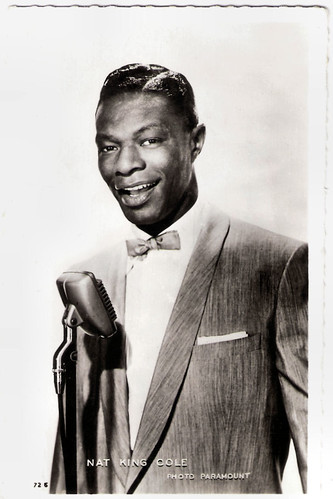
French postcard by Editions P.I., Paris, no. 726. Photo: Paramount, 1956.
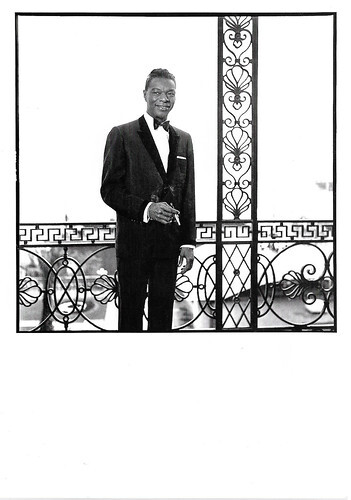
German postcard by Benedikt Taschen Verlag GMBH, Köln, 1997. Photo: William Claxton. Caption: Nat King Cole, San Francisco, 1957, from the book 'William Claxton's Jazz Photography'.
Source: (IMDb), Wikipedia, and .

British postcard in the Greetings series. Photo: General Artists Cooperation.

Dutch postcard by Editions Altona / Gebr. Spanjersberg N.V., Rotterdam, no. 5152. Photo: Capitol Records.

Dutch postcard by Editions Altona, no. 5172. Photo: Capitol Records.
Too black to marry
Nat King Cole was born Nathaniel Adams Coles in Montgomery, Alabama, in 1919. When he was four or five (the sources differ), his family moved to Chicago. There, his father, Edward James Coles, was a minister at the True Light Baptist Church and later the Pastor of the First Baptist Church.
Nat received music lessons from his mother. He learned jazz and gospel music, but also Western classical music. At 12, he was playing the church organ, and at 14, he formed a 14-piece band called the Royal Dukes. His three brothers, Ike Cole, Eddie Cole, and Frankie Cole, also played the piano and later sang professionally.
In 1939, Nat formed the King Cole Trio after his publicist put a silver tin-foiled crown on his head and proclaimed him King. He became known as a leading jazz pianist and soon became noted for his soft, baritone voice. His recordings of 'Straighten Up And Fly Right' (1943), which sold over 500,000 copies, and '(Get Your Kicks on) Route 66' (1946) would become classics and influenced several Rock and roll singers of the 1950s.
Nat King Cole met his second wife, Maria (a big-band singer), at the Zanzibar nightclub in Los Angeles through the Eddie 'Rochester' Anderson show. Her parents protested her decision to marry Cole, claiming he was "too black". However, they were married in 1948 and had five children, including singer Natalie Cole.
When he and his family moved to the upscale Hancock Park area of Los Angeles in the late 1940s, they were met with considerable opposition from the residents of the previously all-white neighbourhood. When the neighbours finally realised - after several attempts, including legal action - that the Coles were not going to be intimidated, they accepted defeat and, ultimately, the Coles as well.

Dutch postcard by Uitg. Takken, Utrecht, no. AX 2002.

Dutch postcard by Uitg. Takken, Utrecht, no. 3559.

German postcard by Rüdel-Verlag, Hamburg-Bergedorf, no. 3119. Photo: Electrola / Capitol.
Unforgettable
In the mid-1950s, Nat King Cole had several mainstream Rock and Roll hits including 'Send For Me', 'With You On My Mind', 'When Rock and Roll Comes To Trinidad', and 'Looking Back'. He often toured Europe and made a command performance before Queen Elizabeth II.
He was the first African-American to have his own TV show - the highly-rated The Nat King Cole Show (1954). Cole cancelled the show because no company was willing to sponsor the show. In 1956, during a concert in Birmingham, Alabama, Cole was attacked by six white men from a white supremacist group called the White Citizens Council. He sustained minor injuries to his back.
Nat King Cole appeared in several films. Uncredited, he made his film debut in Citizen Kane (Orson Welles, 1941) as a pianist in El Rancho. He performed songs in musicals like Here Comes Elmer (Joseph Santley, 1943), Pin-Up Girl (H. Bruce Humberstone, 1944) starring Betty Grable , and Breakfast in Hollywood (Harold D. Schuster, 1946).
During the 1950s, both the films and his parts became bigger, such as in Fritz Lang 's Film Noir The Blue Gardenia (1953), Kiss Me Deadly (Robert Aldrich, 1955), and the war drama China Gate (Samuel Fuller, 1957) with Angie Dickinson . He played the lead role in St. Louis Blues (Allen Reisner, 1958), a biopic of turn-of-the-century blues composer W. C. Handy. Cole also worked in the European cinema and appeared in the Schlager film Schlager-Raketen / Schlager Missiles (Erik Ode, 1960). His last film was the comic Western Cat Ballou (Elliot Silverstein, 1965), starring Lee Marvin and Jane Fonda .
Nat King Cole was also a composer, and his song 'Straighten Up and Fly Right' was sold for $50,000. A heavy smoker, he died of lung cancer in 1965 in Santa Monica. He was only 45. In 1991, his song 'Unforgettable' was made famous again by Cole's daughter Natalie when modern recording technology was used to reunite father and daughter in a duet. The duet version rose to the top of the pop charts, almost forty years after its original popularity.

French postcard by Editions P.I., Paris, no. 726. Photo: Paramount, 1956.

German postcard by Benedikt Taschen Verlag GMBH, Köln, 1997. Photo: William Claxton. Caption: Nat King Cole, San Francisco, 1957, from the book 'William Claxton's Jazz Photography'.
Source: (IMDb), Wikipedia, and .
Published on September 16, 2025 22:00
September 15, 2025
Jacques Charrier (1936-2025)
French actor and film producer Jacques Charrier (1936) passed away on 3 September 2025 in Saint-Briac-sur-Mer in France. He played a young existentialist rebel in the massive box office hit Les Tricheurs / The Cheaters (1958) and appeared in other French films of the late 1950s and 1960s. He gained notoriety when he married Brigitte Bardot. Their brief, tumultuous marriage was punctuated by his personal problems. He later worked as a film producer and as an artist in painting and ceramics. Charrier was 88.
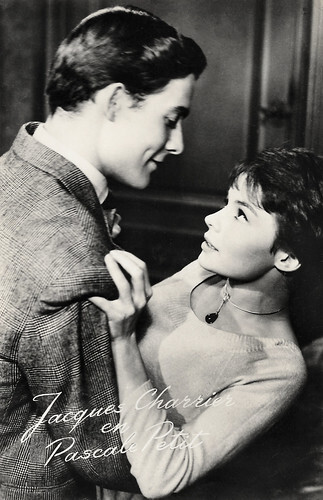
Dutch postcard by Uitg. Takken, Utrecht, no. AX 4069. Photo: NV Standaardfilms, Amsterdam. Jacques Charrier and Pascale Petit in Les Tricheurs / The Cheaters (Marcel Carné, 1958).
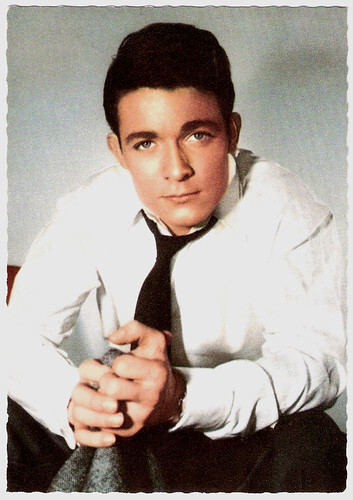
German postcard by Universum-Film Aktiengesellschaft (UFA), Berlin-Tempelhof, no. CK-264. Photo: UFA.
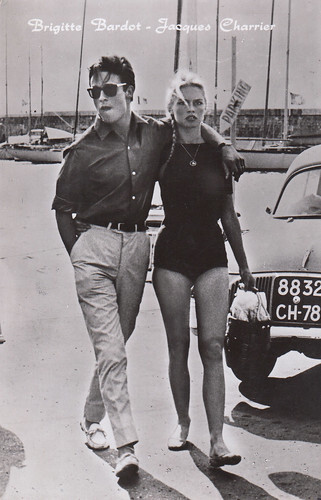
Dutch postcard by Int. Filmpers, Amsterdam, no. 3500. Collection: Marlene Pilaete.
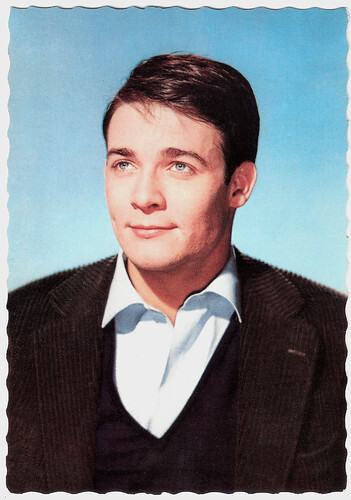
French Postcard by E.D.U.G. (Editions du Globe), no. 25. Photo: Sam Lévin.
Diary of Anne Frank
Jacques Joseph Henri Charrier was born into a family of military men in Metz, France, in 1936. Growing up with six siblings, he was supposed to pursue a military career like his father.
Jacques broke with the family tradition to become an artist. At the age of 17, he entered the École des Beaux-Arts in Strasbourg, where he tried ceramics.
In 1956, a teacher at the Conservatoire de Montpellier offered him a role in a local film, L'Arlésienne, based on a novel by Alphonse Daudet. This success stimulated him to try his luck in Paris.
As a 20-year-old, he entered the ENSATT (École Nationale Supérieure des Arts et Techniques du Théâtre), where he studied with the actress Berthe Bovy .
In 1958, after some odd jobs, he became an extra at the famous Comédie-Française. Then Marguerite Chamois chose him to play one of the leading roles in the play 'Le Journal d'Anne Frank' (The Diary of Anne Frank) with Pascale Audret at the Théâtre Montparnasse.
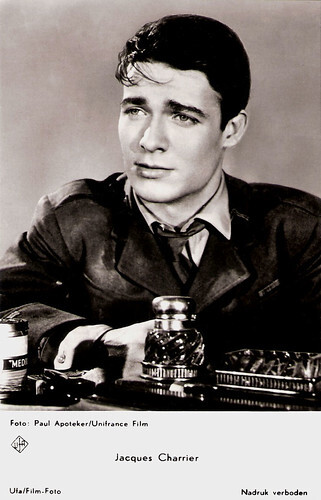
Dutch postcard by Gebr. Spanjersberg N.V., Rotterdam, no. 4519. Photo: Paul Apoteker / Unifrance Film / Ufa.
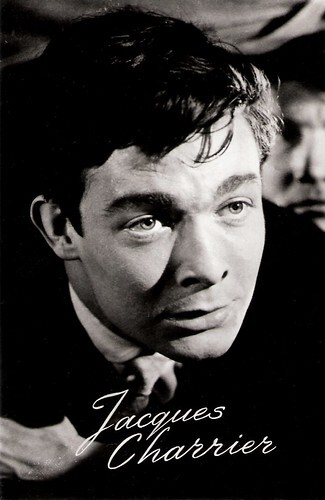
Dutch postcard by Uitg. Takken, Utrecht, nro AX 4072. Photo: NV Standaardfilms. Publicity still for Les Tricheurs / The Cheaters (Marcel Carné, 1958).
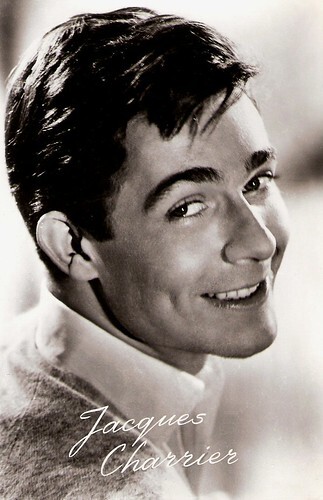
Dutch postcard by Uitg. Takken, Utrecht, no. AX 4071. Photo: NV Standaardfilms. Publicity still for Les Tricheurs / The Cheaters (Marcel Carné, 1958).
The cheaters
There, the famous film director Marcel Carné saw Jacques Charrier and offered him his first film role, Bob Letellier, a good-looking, rich kid who studies science, in Les Tricheurs / The Cheaters (Marcel Carné, 1958) with Jean-Paul Belmondo and Pascale Petit .
Les Tricheurs / The Cheaters is a study of the rebellious, existentialist youth of Saint-Germain-des-Prés and the Latin Quarter of Paris.
The film was harshly judged by young French critics upon release, but became a massive box office hit in France, with admissions of 4,953,600. Overnight, Jacques Charrier became a star.
Next, he played a lead role in the drama Les dragueurs / The Chasers (Jean-Pierre Mocky, 1959). He and Charles Aznavour played two young men, Freddy and Joseph, who go out looking for girls one night, hoping to find the right girl.
Then he acted in the comedy-drama La main chaude / The Itchy Palm (Gérard Oury, 1960), and the thriller L'oeil du malin / The Third Lover (Claude Chabrol, 1961) with Stéphane Audran .
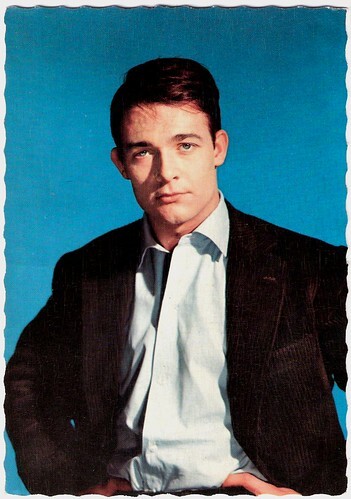
French Postcard by E.D.U.G. (Editions du Globe), no. 27. Photo: Sam Lévin.
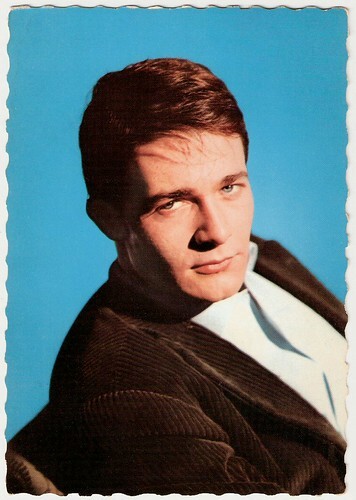
French Postcard by E.D.U.G. (Editions du Globe), no. 71. Photo: Sam Lévin.
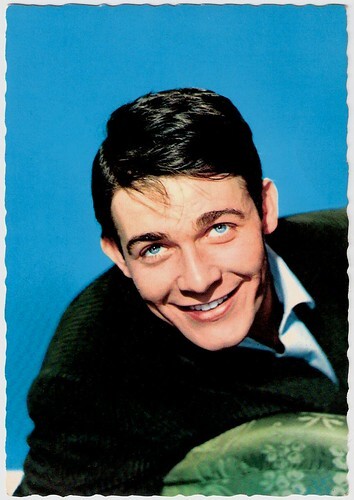
French Postcard by E.D.U.G. (Editions du Globe), no. 66. Photo: Sam Lévin.
BB
Brigitte Bardot chose Jacques Charrier as her leading man in the comedy Babette s'en va-t-en guerre / Babette Goes to War (Christian-Jacque, 1959).
During the shooting of the film, Brigitte and Jacques fell madly in love. Immediately after the production was finished, they married under massive media attention.
At the time, Jacques was just 23 years old, and a year later, he became the father of their son Nicolas-Jacques Charrier (1960). BB’s baby was again a media event.
Charrier made headlines when he made several suicide attempts and when he withdrew from the National Service on health grounds.
In 1962, Jacques Charrier and Brigitte Bardot divorced and from then on, he took care of their son Nicholas.
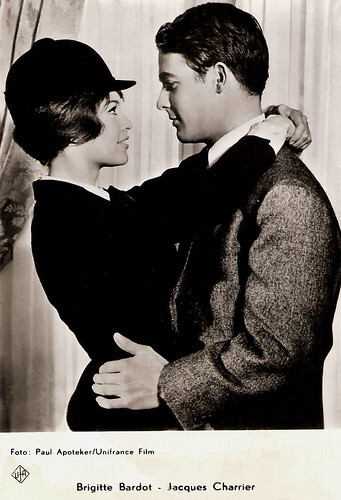
Dutch postcard by Gebr. Spanjersberg N.V., Rotterdam, no. 4518. Photo: Paul Apoteker / Unifrance Film / Ufa. Publicity still for Babette s'en va-t-en guerre / Babette Goes to War (1959) with Brigitte Bardot .
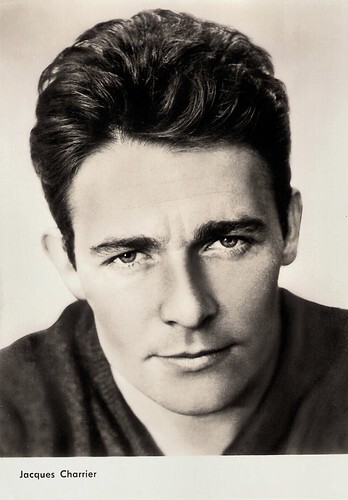
East German postcard by VEB Progress Filmvertrieb.
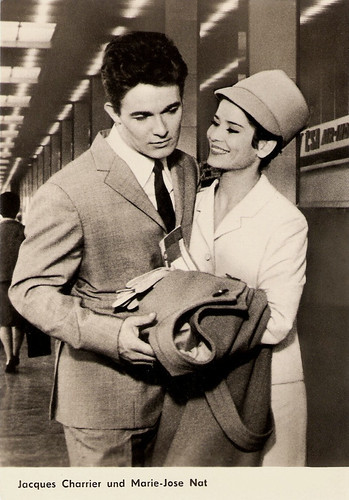
German postcard by Progress Film-Vertrieb, Berlin, no. 2.625. Retail price: 0,20 MDN. Photo: Progress. Still from La Vie Conjugale / Anatomy of a Marriage (1963) with Marie-José Nat .
Anatomy of a marriage
Jacques Charrier continued acting in films like the comedy À cause, à cause d'une femme / Because of a Woman (Michel Deville, 1962) opposite Mylène Demongeot , and Carmen 63 / Carmen di Trastevere (Carmine Gallone, 1963).
Unique was the experiment Françoise ou la vie conjugale / Anatomy of a Marriage: My Days with Françoise and Jean-Marc ou La vie conjugale / Anatomy of a Marriage: My Days with Jean-Marc (André Cayatte, both 1964). The two films tell the same story, but the first one was made from the wife's point of view, and the second from the husband's.
In 1969, Jacques Charrier, along with Jean-Claude Brialy , founded the film company Les Films Marquise to produce low-budget films.
He produced and starred in films like Sirokkó / Winter Wind (Miklos Jancso, 1969) with Marina Vlady , Eglantine (Jean-Claude Brialy, 1971), and Les volets clos / Closed Shutters (Jean-Claude Brialy, 1973) with Marie Bell .
The financial failure of Il pleut sur Santiago / It's Raining on Santiago (Helvio Soto, 1975), a feature film about the 1973 coup d'état in Chile, led him to leave the world of cinema. The title is a code word the Chilean military had broadcast to signal the start of the coup.
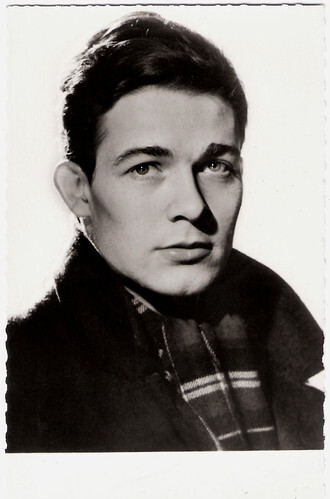
French postcard by Editions P.I., Paris, no. 960. Presented by Les Carbones Korès 'Carboplane'. Photo: Lucienne Chevert.
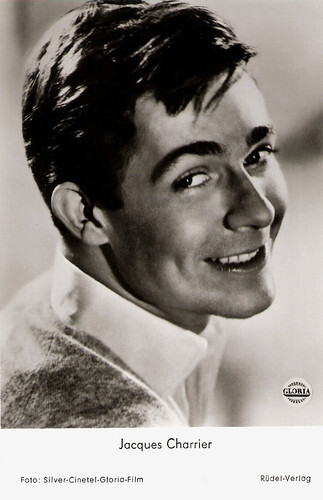
German Postcard by Rüdel-Verlag, Hamburg-Bergedorf, no. 2744. Photo: Silver / Cinetel / Gloria-Film. Publicity still for Les tricheurs/The Cheaters (1958).
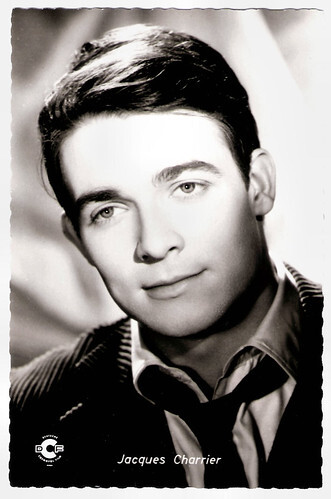
German Postcard by Kolibri-Verlag no. 824. Photo: Deutsche Cosmopol Film. Publicity still for Les dragueurs/The Dredgers (1959).
A damning riposte
In the 1980s, Jacques Charrier returned to the École des Beaux-Arts to study painting. His work is marked by references to his two passions: travel and antiquity, and would be exhibited in Paris, Genève and San Francisco.
In 1996, he found himself back in the media spotlight once more when Brigitte Bardot 's best-selling memoir, 'Initiales BB', was published. She described her former husband as "a violent, alcoholic macho". To her pregnancy, she referred to as a 'tumour' growing inside her.
Charrier and their son, Nicolas Charrier, both successfully sued her for "violation of privacy". Bardot and her publisher were ordered to pay 250,000 francs to Jacques and Nicholas. In 1997, Jacques also published 'Ma réponse à Brigitte Bardot' (My Answer to Brigitte Bardot), a damning riposte to his ex-wife.
After his marriage to Bardot, Charrier married three more times. In 1964, he wed France Louis-Dreyfus, of the Louis-Dreyfus family, with whom he had two daughters, Sophie and Marie, before divorcing in 1967. In 1982, he met his third wife, Linda, with whom he had one daughter, Rosalie. In 2009, he married Japanese artist and photographer Makiko Kumano. In 2008, Charrier exhibited a number of his paintings at the Espace Cardin in Paris and in 2012, he exhibited at the Yves Klein Archives in Paris.
Charrier died on 3 September 2025, at the age of 88, in Saint-Briac-sur-Mer, where he had lived for 13 years. His death was announced by his family in a simple obituary in the newspaper 'Ouest France': "We are saddened to announce the death of Mr Jacques Charrier on Wednesday 3 September 2025, at the age of 88." The message was signed by Makiko, his Japanese wife, Nicolas, Marie, Sophie and Rosalie, his children, his grandchildren and great-grandchildren, as well as all his family and friends. A final tribute was paid to him in a private family ceremony.
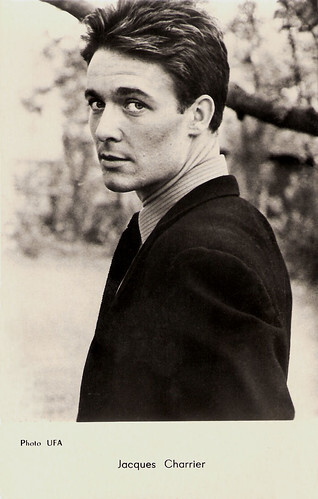
French postcard by Editions P.I., no. FK 120A, offered by Les Carbones Korès 'Carboplane'. Photo: Ufa.
Scene from Les Tricheurs (1958). Source: Le canard en rut (Daily Motion).
Sources: (IMDb), Sandra Brennan (AllMovie - Page now defunct), Paris-Match (French), Wikipedia (French and English) and .

Dutch postcard by Uitg. Takken, Utrecht, no. AX 4069. Photo: NV Standaardfilms, Amsterdam. Jacques Charrier and Pascale Petit in Les Tricheurs / The Cheaters (Marcel Carné, 1958).

German postcard by Universum-Film Aktiengesellschaft (UFA), Berlin-Tempelhof, no. CK-264. Photo: UFA.

Dutch postcard by Int. Filmpers, Amsterdam, no. 3500. Collection: Marlene Pilaete.

French Postcard by E.D.U.G. (Editions du Globe), no. 25. Photo: Sam Lévin.
Diary of Anne Frank
Jacques Joseph Henri Charrier was born into a family of military men in Metz, France, in 1936. Growing up with six siblings, he was supposed to pursue a military career like his father.
Jacques broke with the family tradition to become an artist. At the age of 17, he entered the École des Beaux-Arts in Strasbourg, where he tried ceramics.
In 1956, a teacher at the Conservatoire de Montpellier offered him a role in a local film, L'Arlésienne, based on a novel by Alphonse Daudet. This success stimulated him to try his luck in Paris.
As a 20-year-old, he entered the ENSATT (École Nationale Supérieure des Arts et Techniques du Théâtre), where he studied with the actress Berthe Bovy .
In 1958, after some odd jobs, he became an extra at the famous Comédie-Française. Then Marguerite Chamois chose him to play one of the leading roles in the play 'Le Journal d'Anne Frank' (The Diary of Anne Frank) with Pascale Audret at the Théâtre Montparnasse.

Dutch postcard by Gebr. Spanjersberg N.V., Rotterdam, no. 4519. Photo: Paul Apoteker / Unifrance Film / Ufa.

Dutch postcard by Uitg. Takken, Utrecht, nro AX 4072. Photo: NV Standaardfilms. Publicity still for Les Tricheurs / The Cheaters (Marcel Carné, 1958).

Dutch postcard by Uitg. Takken, Utrecht, no. AX 4071. Photo: NV Standaardfilms. Publicity still for Les Tricheurs / The Cheaters (Marcel Carné, 1958).
The cheaters
There, the famous film director Marcel Carné saw Jacques Charrier and offered him his first film role, Bob Letellier, a good-looking, rich kid who studies science, in Les Tricheurs / The Cheaters (Marcel Carné, 1958) with Jean-Paul Belmondo and Pascale Petit .
Les Tricheurs / The Cheaters is a study of the rebellious, existentialist youth of Saint-Germain-des-Prés and the Latin Quarter of Paris.
The film was harshly judged by young French critics upon release, but became a massive box office hit in France, with admissions of 4,953,600. Overnight, Jacques Charrier became a star.
Next, he played a lead role in the drama Les dragueurs / The Chasers (Jean-Pierre Mocky, 1959). He and Charles Aznavour played two young men, Freddy and Joseph, who go out looking for girls one night, hoping to find the right girl.
Then he acted in the comedy-drama La main chaude / The Itchy Palm (Gérard Oury, 1960), and the thriller L'oeil du malin / The Third Lover (Claude Chabrol, 1961) with Stéphane Audran .

French Postcard by E.D.U.G. (Editions du Globe), no. 27. Photo: Sam Lévin.

French Postcard by E.D.U.G. (Editions du Globe), no. 71. Photo: Sam Lévin.

French Postcard by E.D.U.G. (Editions du Globe), no. 66. Photo: Sam Lévin.
BB
Brigitte Bardot chose Jacques Charrier as her leading man in the comedy Babette s'en va-t-en guerre / Babette Goes to War (Christian-Jacque, 1959).
During the shooting of the film, Brigitte and Jacques fell madly in love. Immediately after the production was finished, they married under massive media attention.
At the time, Jacques was just 23 years old, and a year later, he became the father of their son Nicolas-Jacques Charrier (1960). BB’s baby was again a media event.
Charrier made headlines when he made several suicide attempts and when he withdrew from the National Service on health grounds.
In 1962, Jacques Charrier and Brigitte Bardot divorced and from then on, he took care of their son Nicholas.

Dutch postcard by Gebr. Spanjersberg N.V., Rotterdam, no. 4518. Photo: Paul Apoteker / Unifrance Film / Ufa. Publicity still for Babette s'en va-t-en guerre / Babette Goes to War (1959) with Brigitte Bardot .

East German postcard by VEB Progress Filmvertrieb.

German postcard by Progress Film-Vertrieb, Berlin, no. 2.625. Retail price: 0,20 MDN. Photo: Progress. Still from La Vie Conjugale / Anatomy of a Marriage (1963) with Marie-José Nat .
Anatomy of a marriage
Jacques Charrier continued acting in films like the comedy À cause, à cause d'une femme / Because of a Woman (Michel Deville, 1962) opposite Mylène Demongeot , and Carmen 63 / Carmen di Trastevere (Carmine Gallone, 1963).
Unique was the experiment Françoise ou la vie conjugale / Anatomy of a Marriage: My Days with Françoise and Jean-Marc ou La vie conjugale / Anatomy of a Marriage: My Days with Jean-Marc (André Cayatte, both 1964). The two films tell the same story, but the first one was made from the wife's point of view, and the second from the husband's.
In 1969, Jacques Charrier, along with Jean-Claude Brialy , founded the film company Les Films Marquise to produce low-budget films.
He produced and starred in films like Sirokkó / Winter Wind (Miklos Jancso, 1969) with Marina Vlady , Eglantine (Jean-Claude Brialy, 1971), and Les volets clos / Closed Shutters (Jean-Claude Brialy, 1973) with Marie Bell .
The financial failure of Il pleut sur Santiago / It's Raining on Santiago (Helvio Soto, 1975), a feature film about the 1973 coup d'état in Chile, led him to leave the world of cinema. The title is a code word the Chilean military had broadcast to signal the start of the coup.

French postcard by Editions P.I., Paris, no. 960. Presented by Les Carbones Korès 'Carboplane'. Photo: Lucienne Chevert.

German Postcard by Rüdel-Verlag, Hamburg-Bergedorf, no. 2744. Photo: Silver / Cinetel / Gloria-Film. Publicity still for Les tricheurs/The Cheaters (1958).

German Postcard by Kolibri-Verlag no. 824. Photo: Deutsche Cosmopol Film. Publicity still for Les dragueurs/The Dredgers (1959).
A damning riposte
In the 1980s, Jacques Charrier returned to the École des Beaux-Arts to study painting. His work is marked by references to his two passions: travel and antiquity, and would be exhibited in Paris, Genève and San Francisco.
In 1996, he found himself back in the media spotlight once more when Brigitte Bardot 's best-selling memoir, 'Initiales BB', was published. She described her former husband as "a violent, alcoholic macho". To her pregnancy, she referred to as a 'tumour' growing inside her.
Charrier and their son, Nicolas Charrier, both successfully sued her for "violation of privacy". Bardot and her publisher were ordered to pay 250,000 francs to Jacques and Nicholas. In 1997, Jacques also published 'Ma réponse à Brigitte Bardot' (My Answer to Brigitte Bardot), a damning riposte to his ex-wife.
After his marriage to Bardot, Charrier married three more times. In 1964, he wed France Louis-Dreyfus, of the Louis-Dreyfus family, with whom he had two daughters, Sophie and Marie, before divorcing in 1967. In 1982, he met his third wife, Linda, with whom he had one daughter, Rosalie. In 2009, he married Japanese artist and photographer Makiko Kumano. In 2008, Charrier exhibited a number of his paintings at the Espace Cardin in Paris and in 2012, he exhibited at the Yves Klein Archives in Paris.
Charrier died on 3 September 2025, at the age of 88, in Saint-Briac-sur-Mer, where he had lived for 13 years. His death was announced by his family in a simple obituary in the newspaper 'Ouest France': "We are saddened to announce the death of Mr Jacques Charrier on Wednesday 3 September 2025, at the age of 88." The message was signed by Makiko, his Japanese wife, Nicolas, Marie, Sophie and Rosalie, his children, his grandchildren and great-grandchildren, as well as all his family and friends. A final tribute was paid to him in a private family ceremony.

French postcard by Editions P.I., no. FK 120A, offered by Les Carbones Korès 'Carboplane'. Photo: Ufa.
Scene from Les Tricheurs (1958). Source: Le canard en rut (Daily Motion).
Sources: (IMDb), Sandra Brennan (AllMovie - Page now defunct), Paris-Match (French), Wikipedia (French and English) and .
Published on September 15, 2025 22:00
Paul van Yperen's Blog
- Paul van Yperen's profile
- 13 followers
Paul van Yperen isn't a Goodreads Author
(yet),
but they
do have a blog,
so here are some recent posts imported from
their feed.



